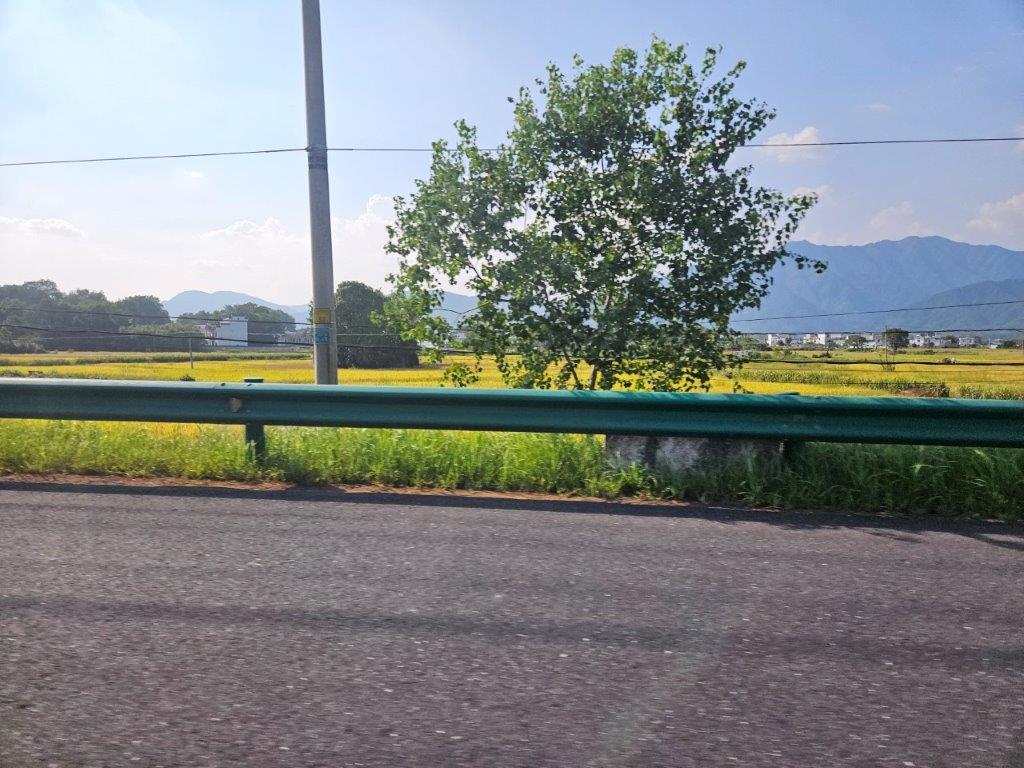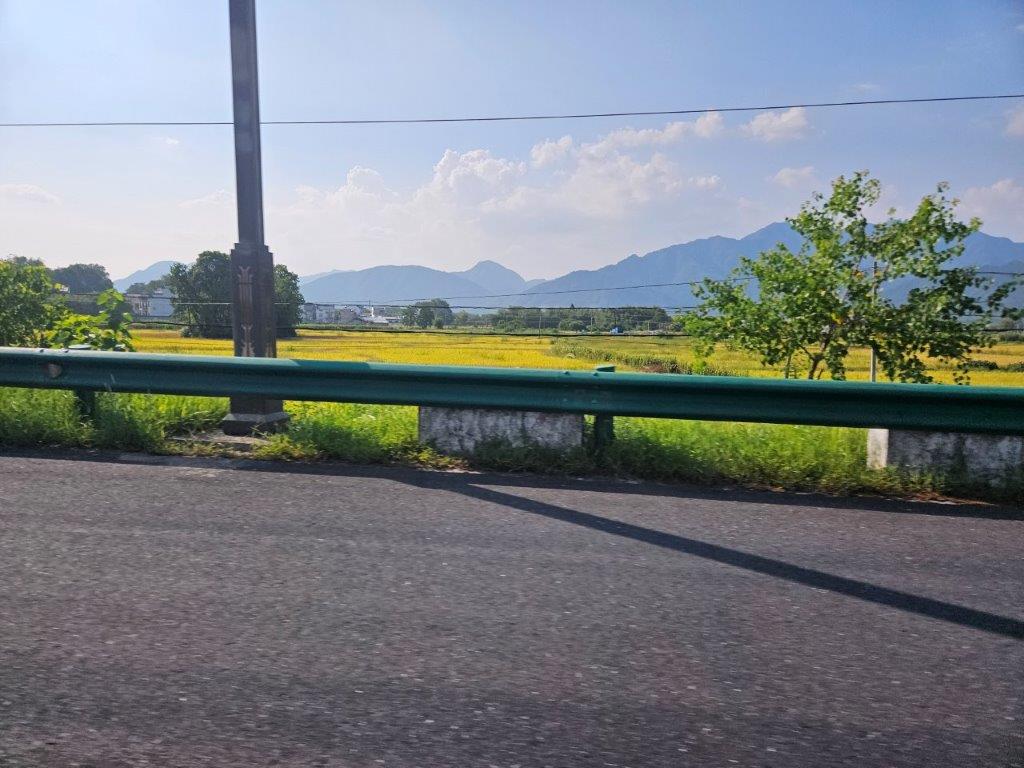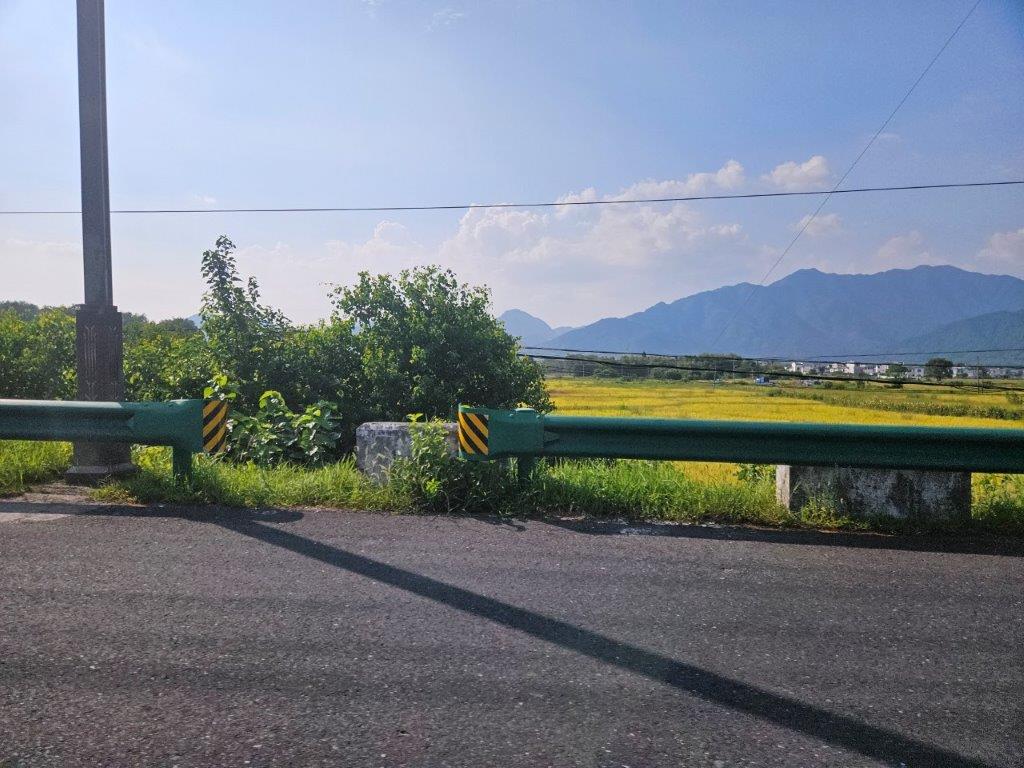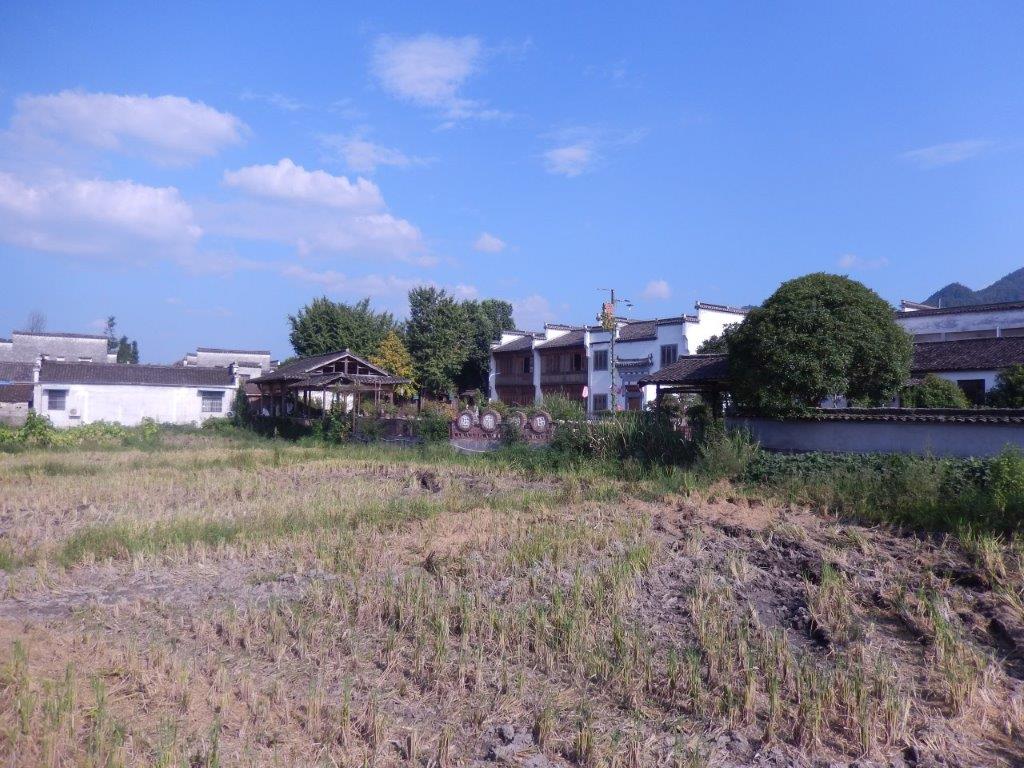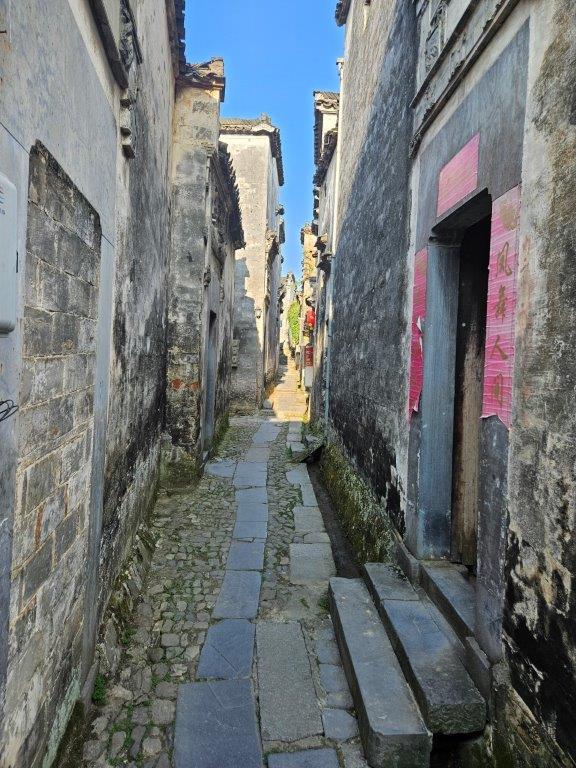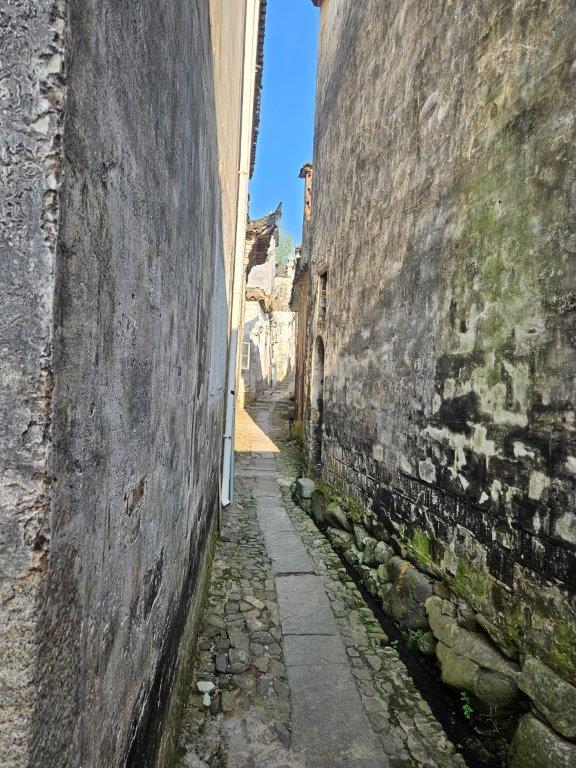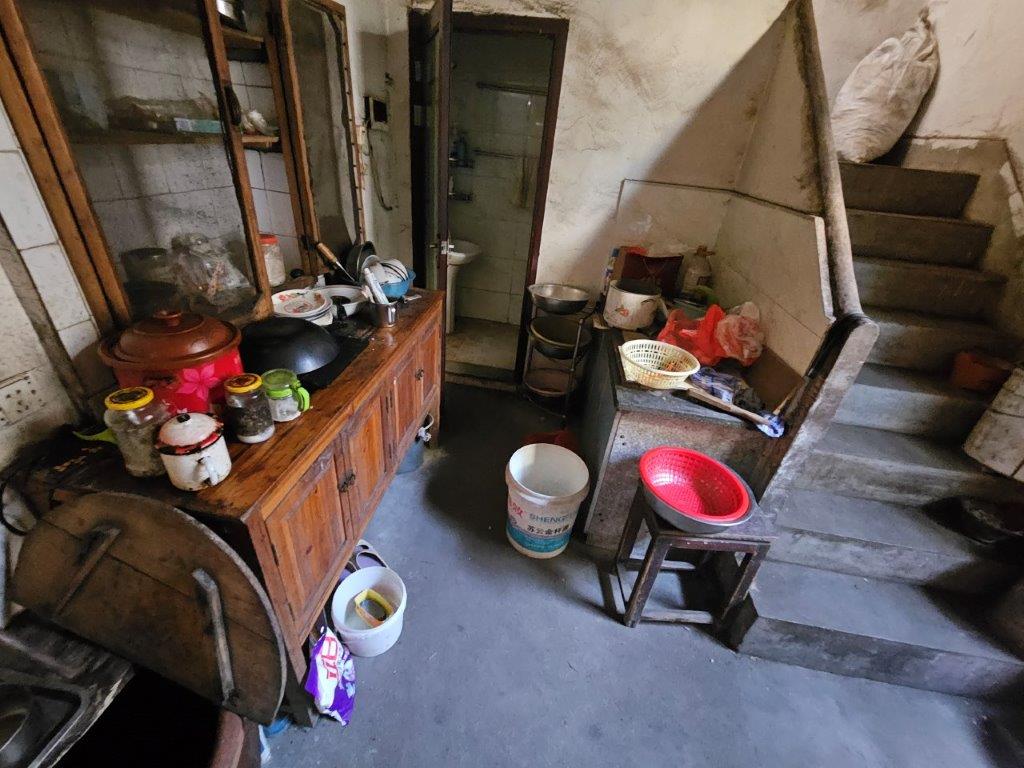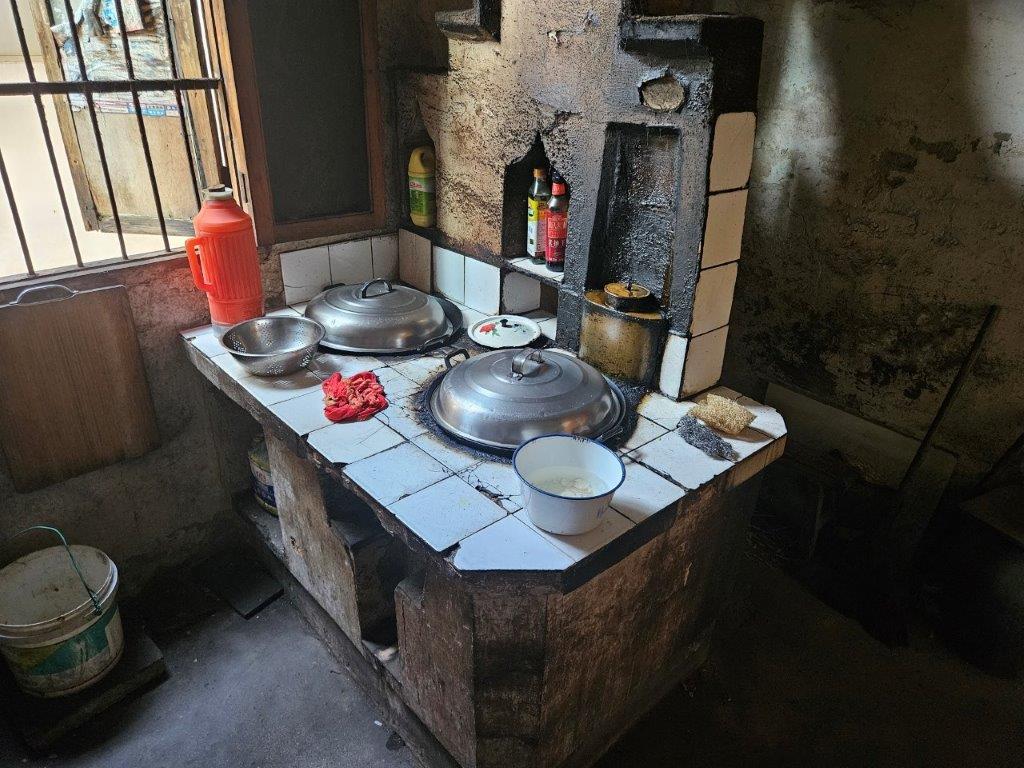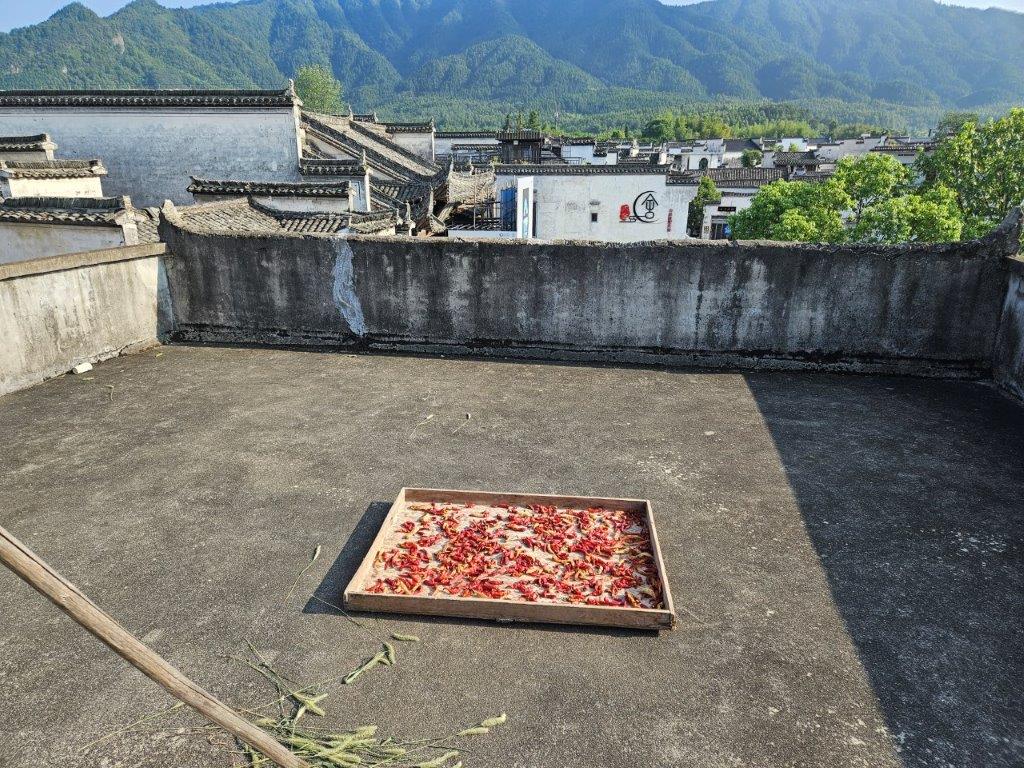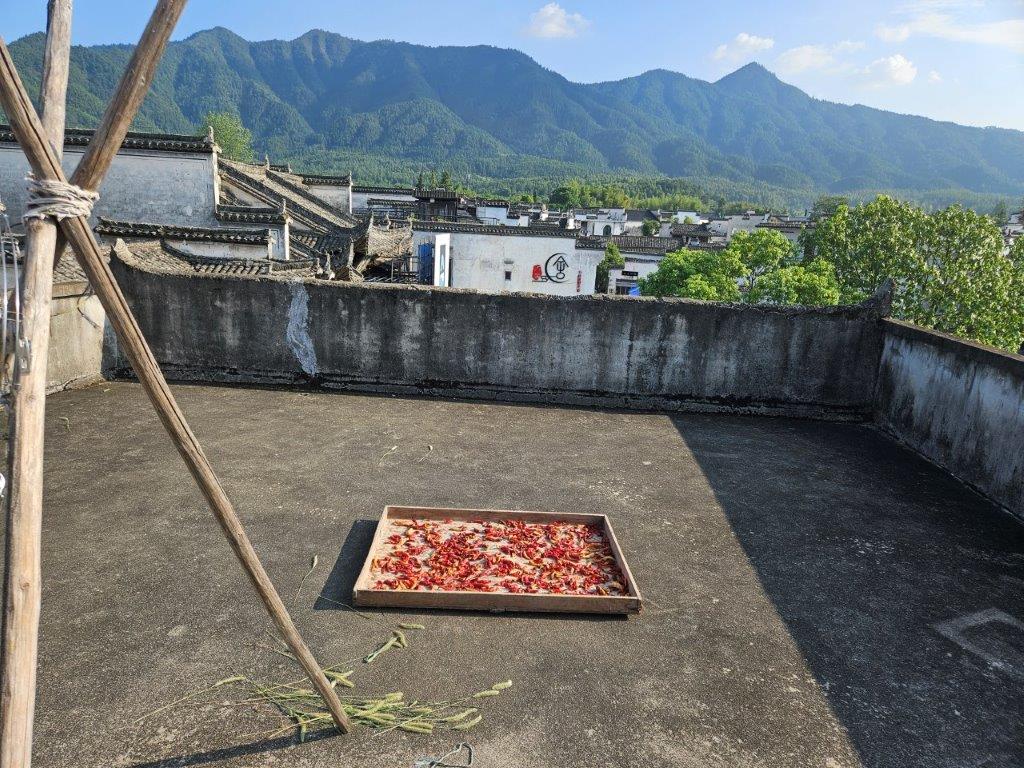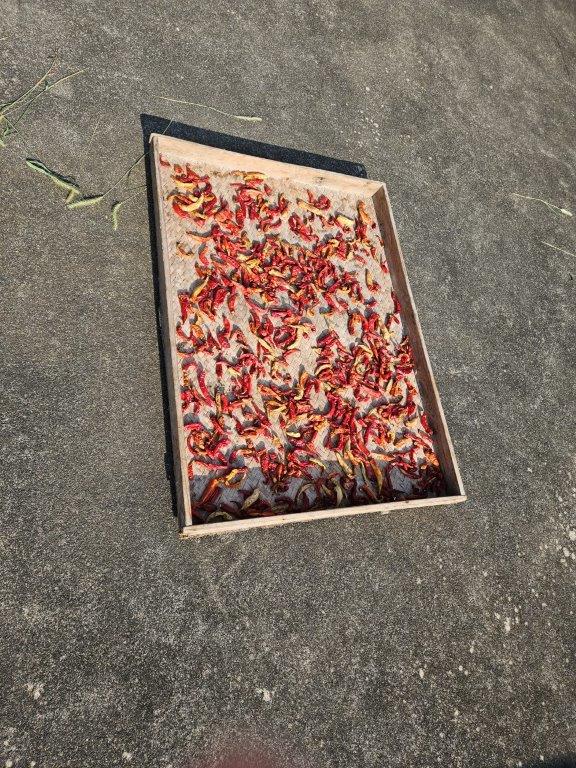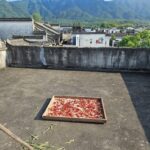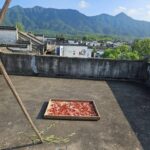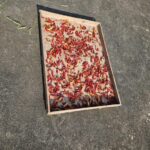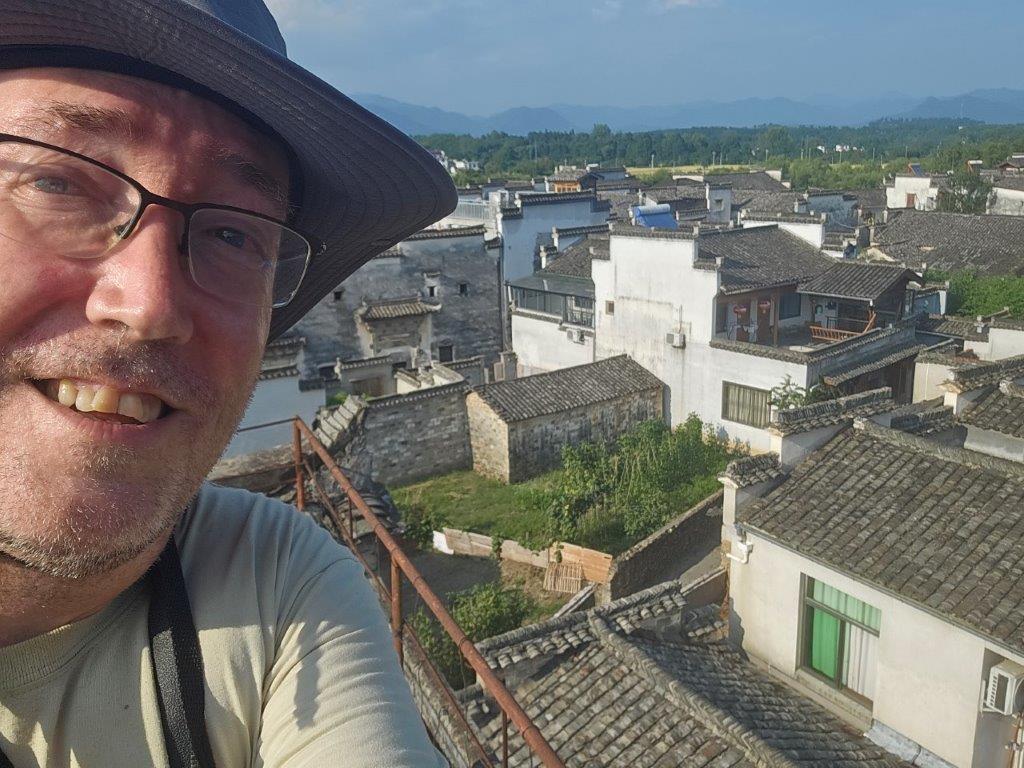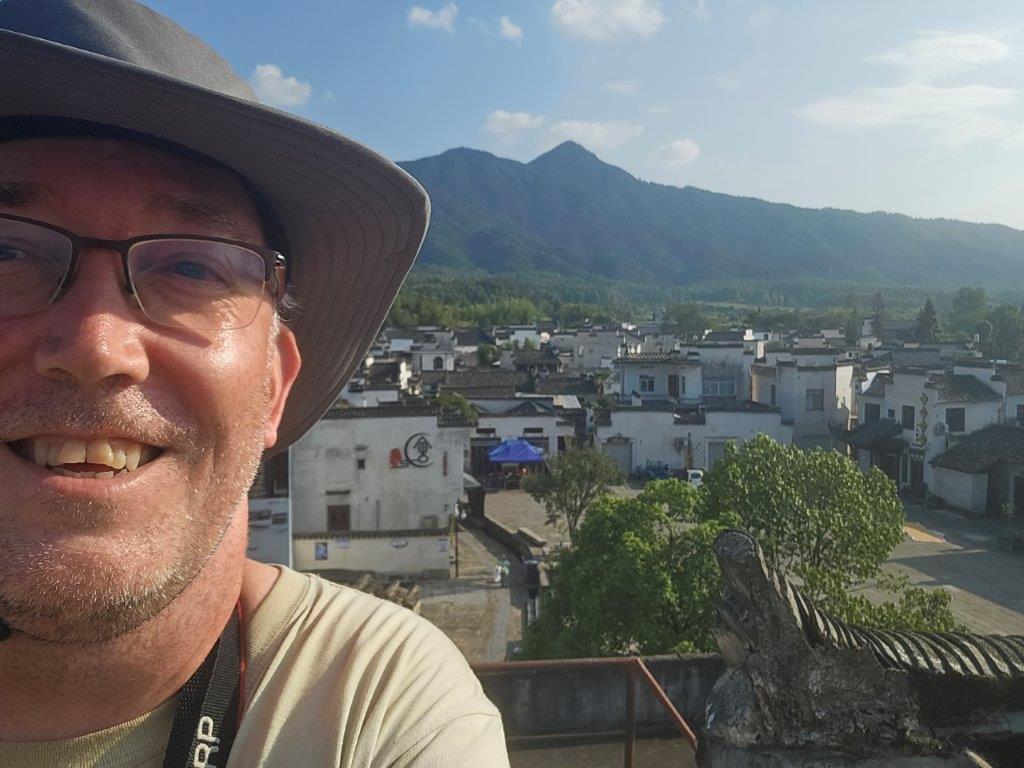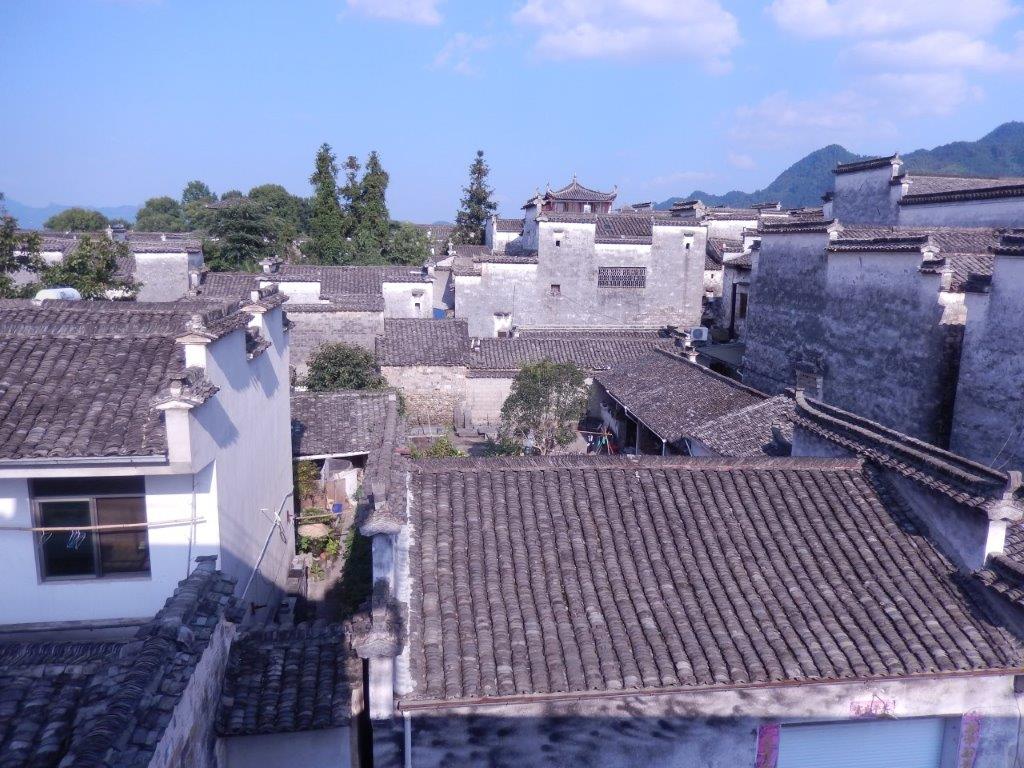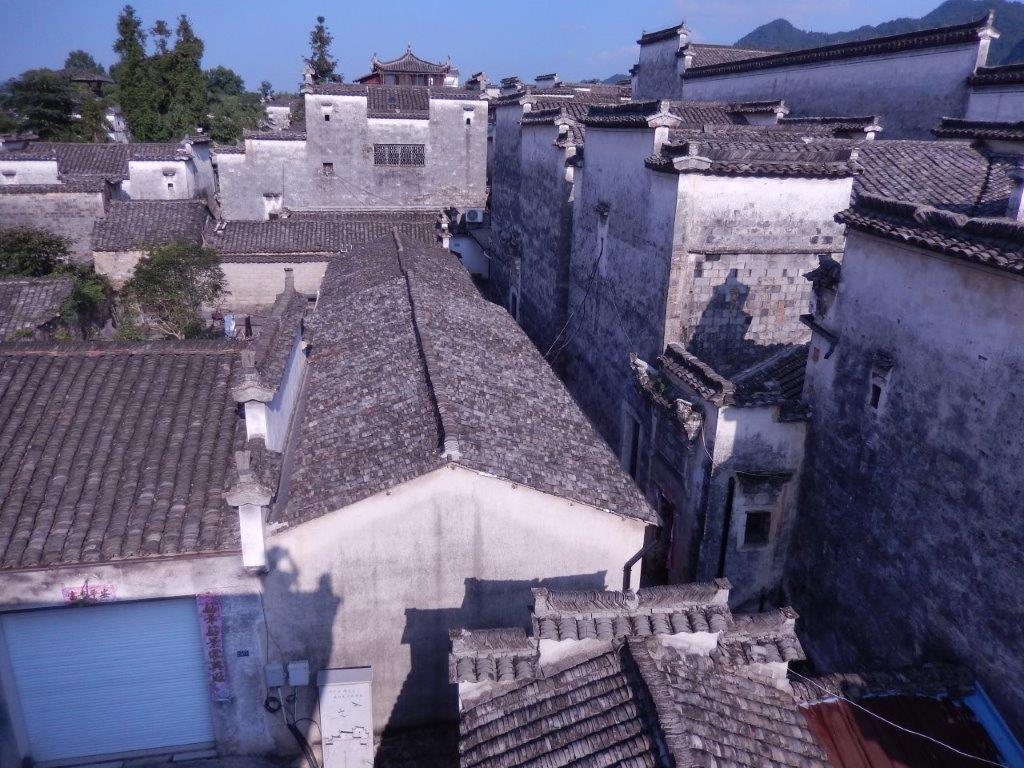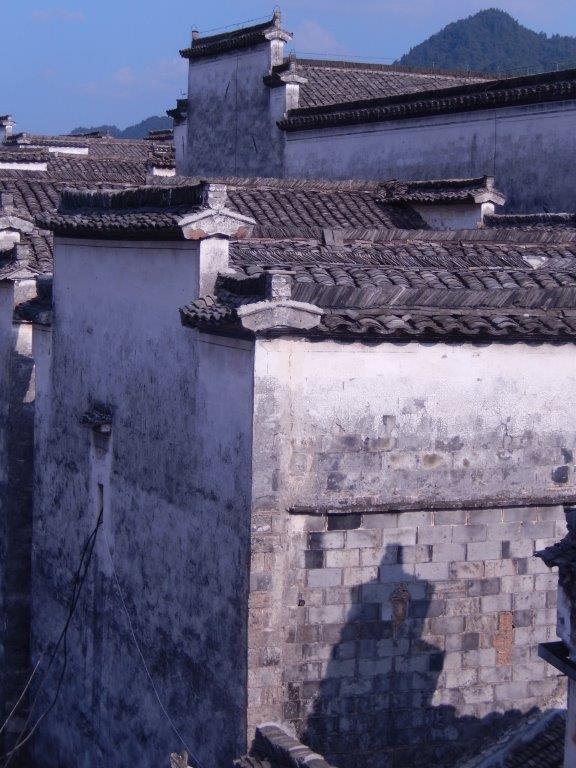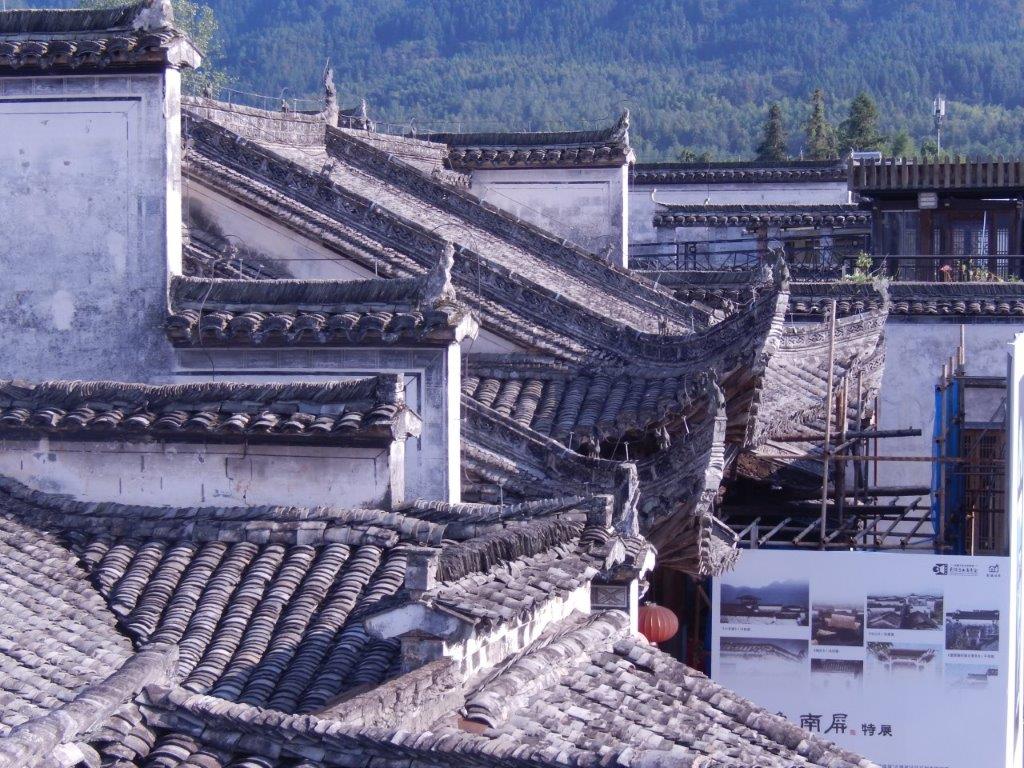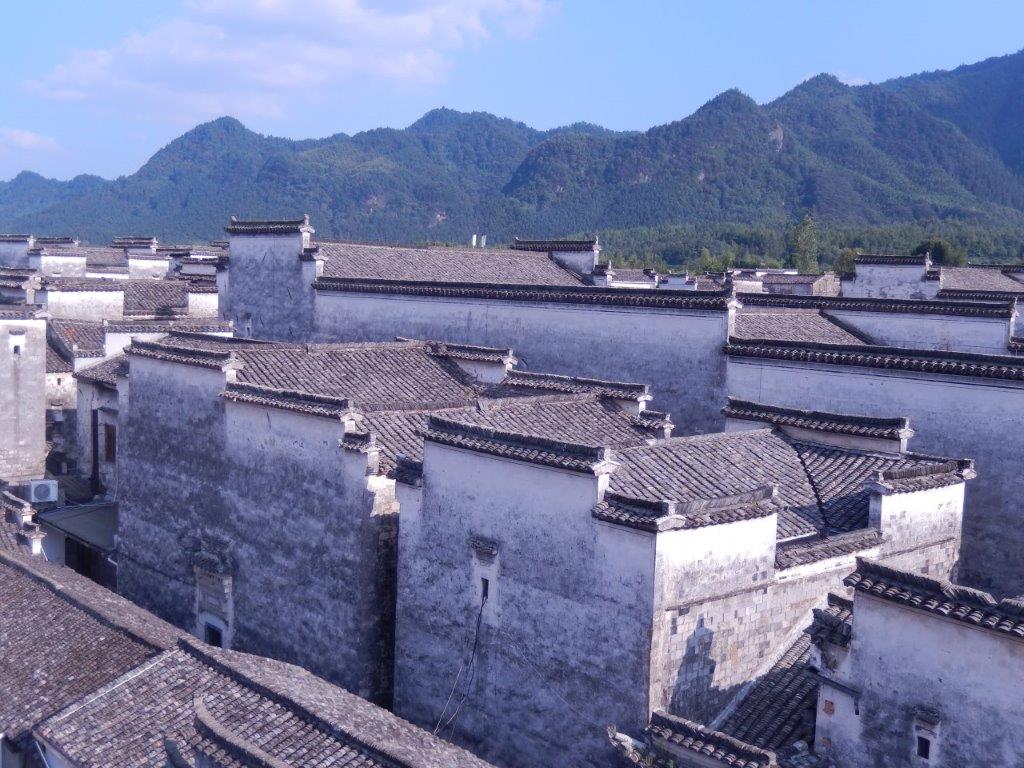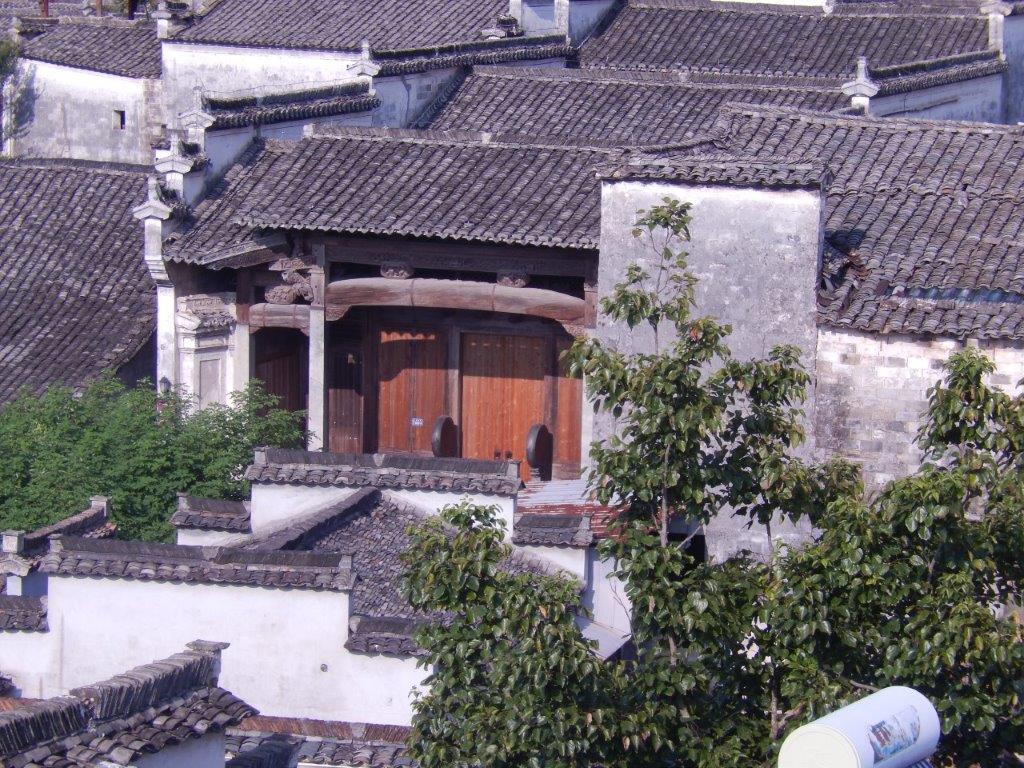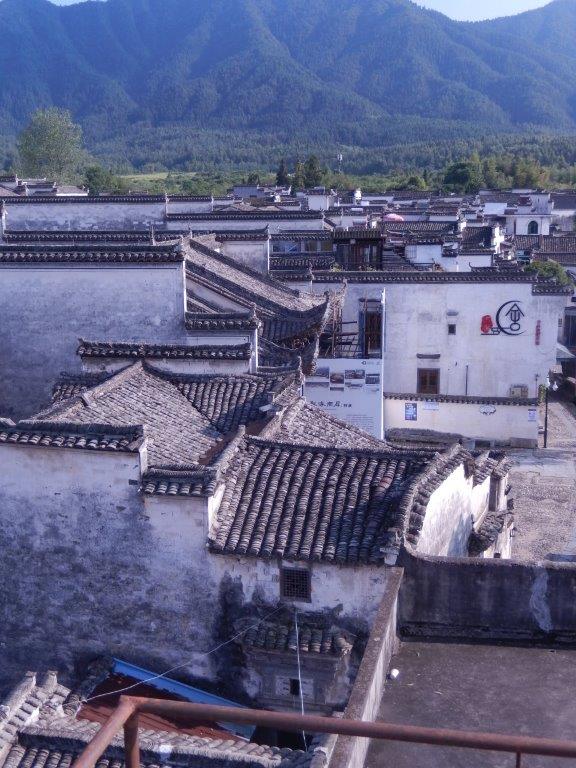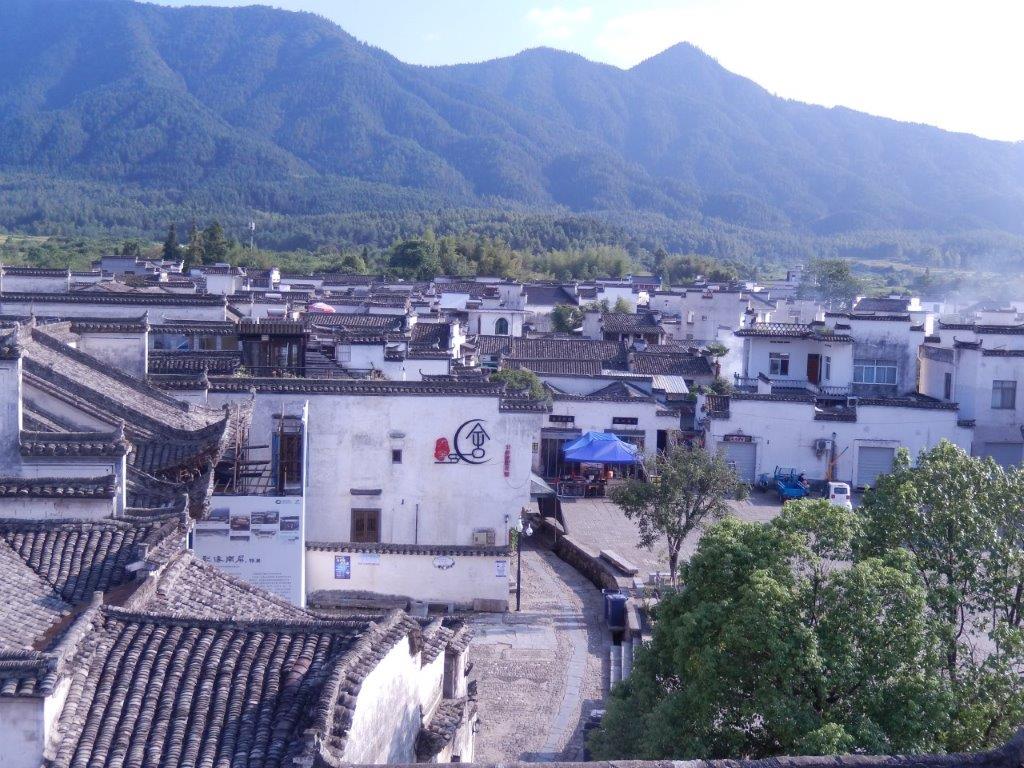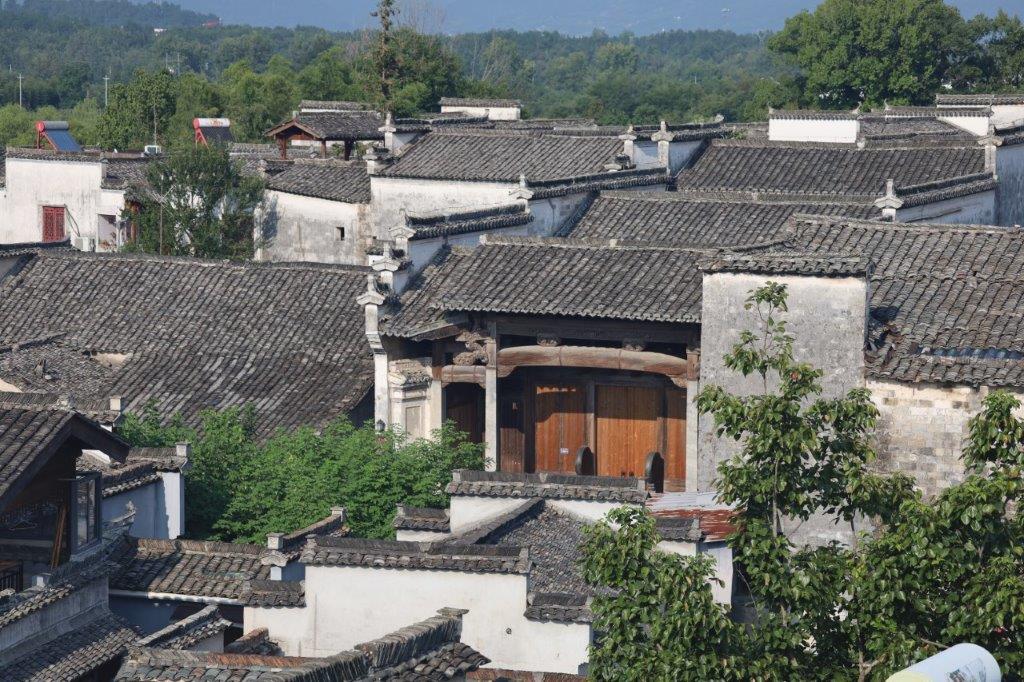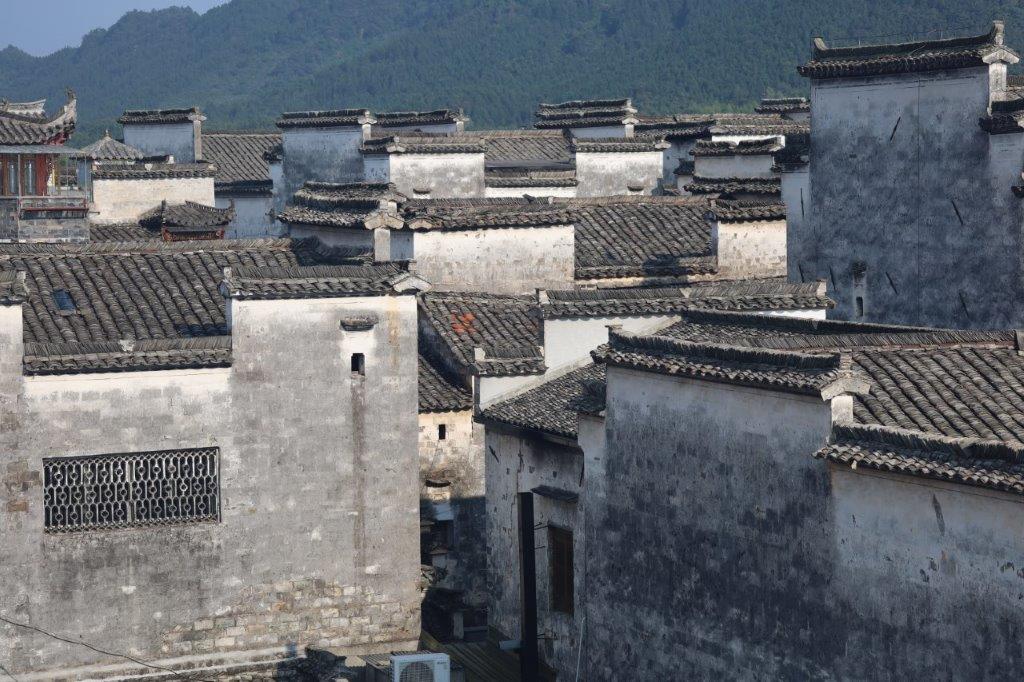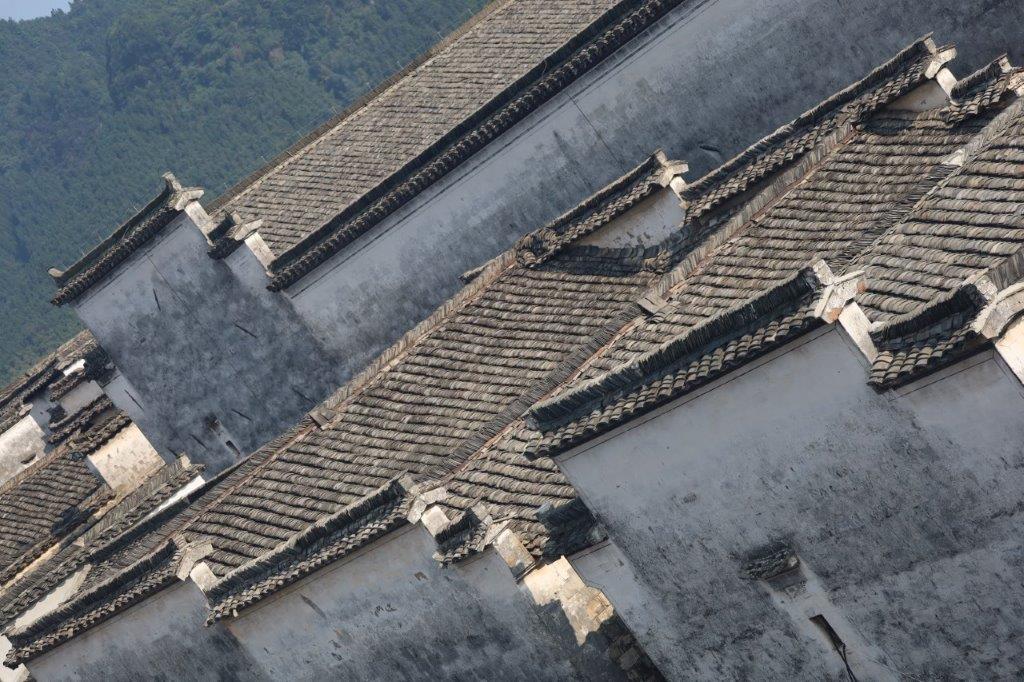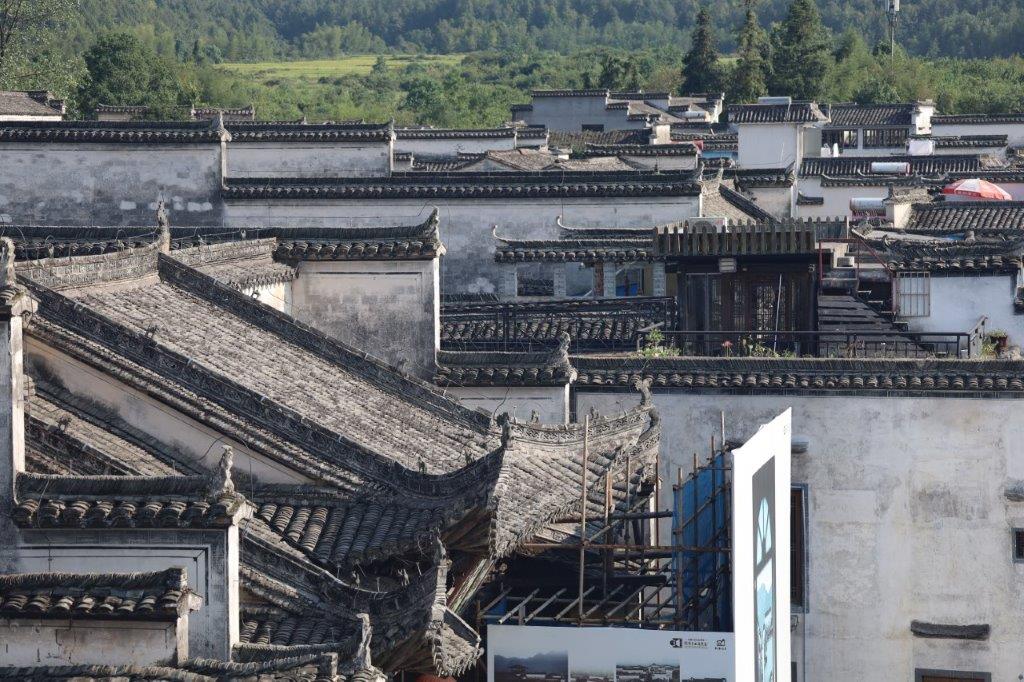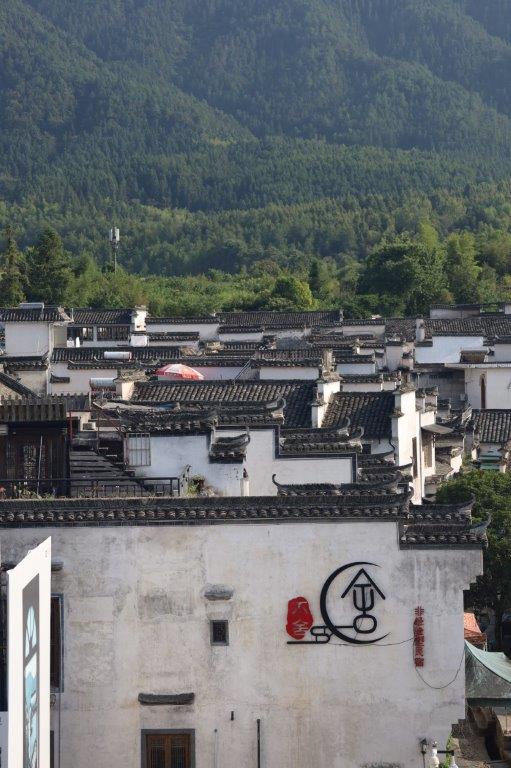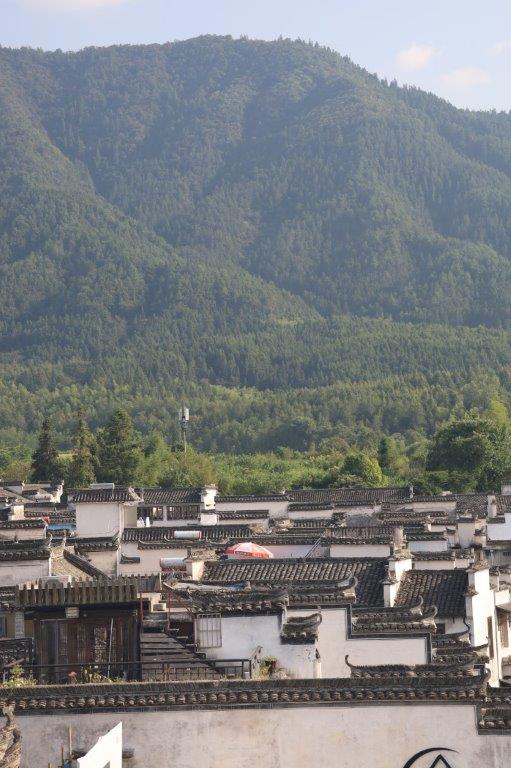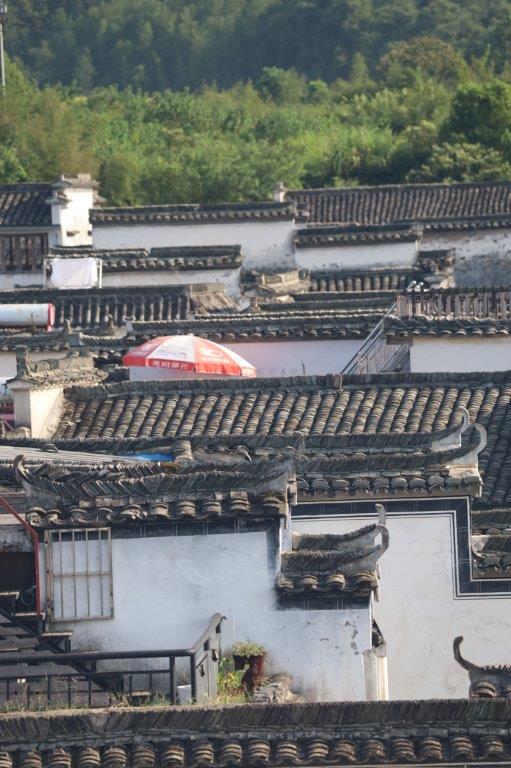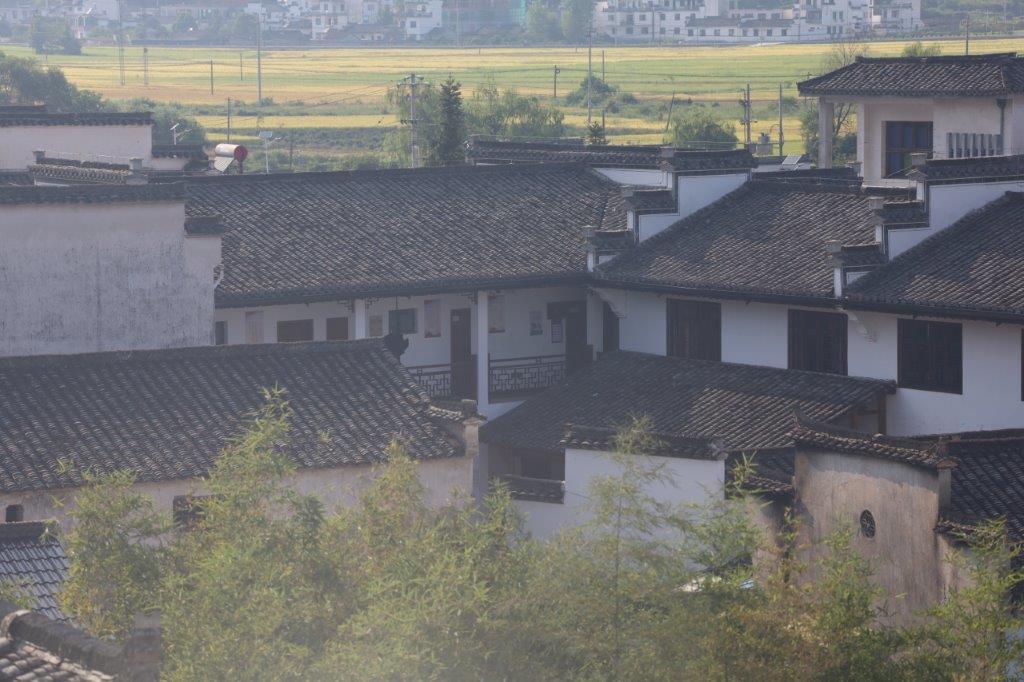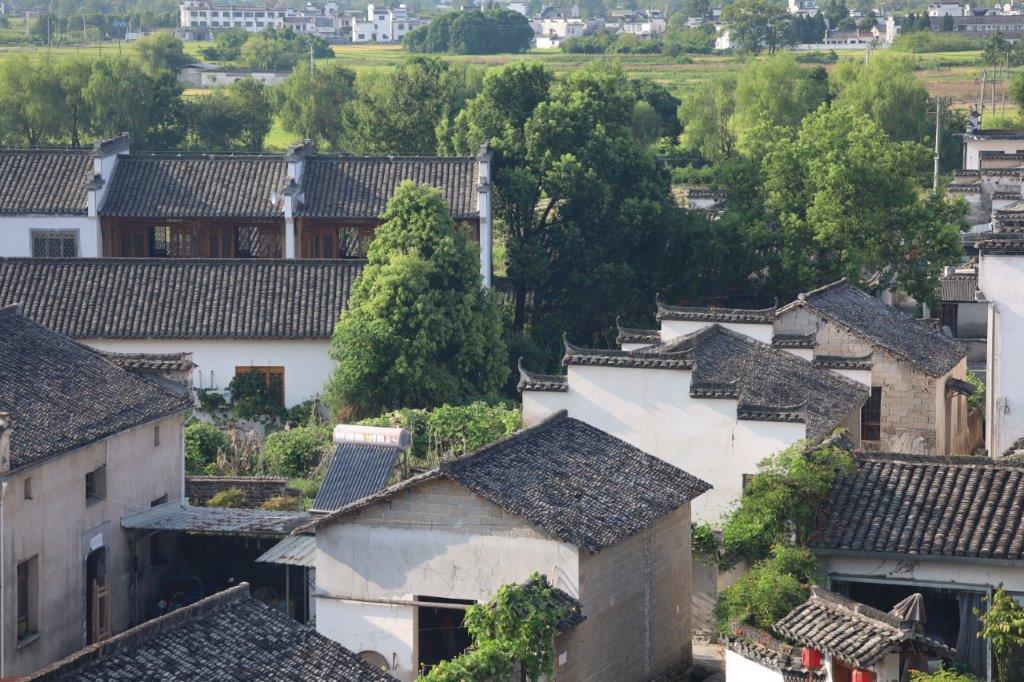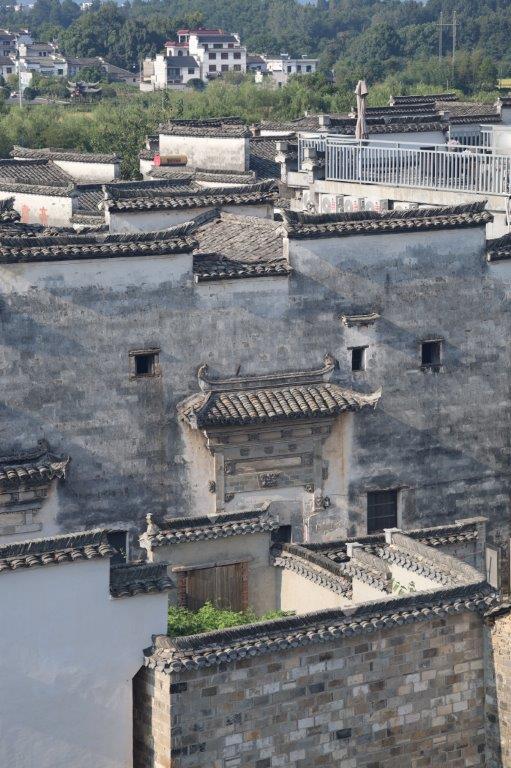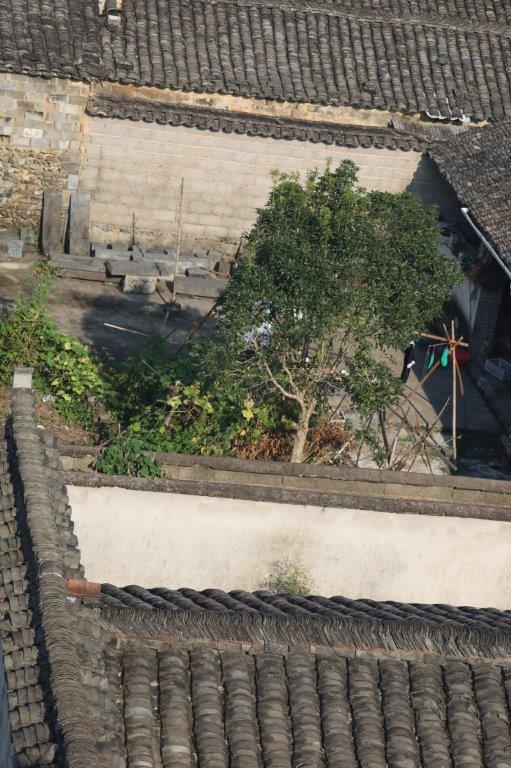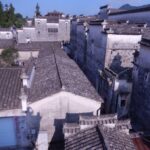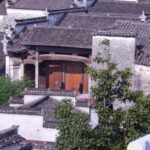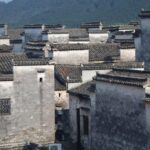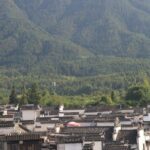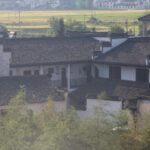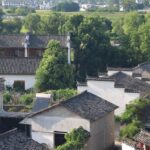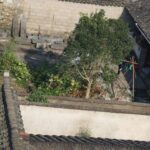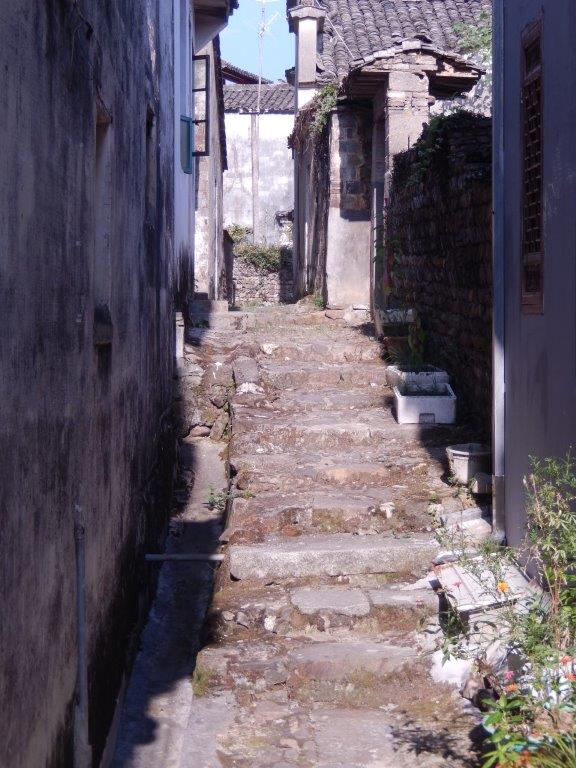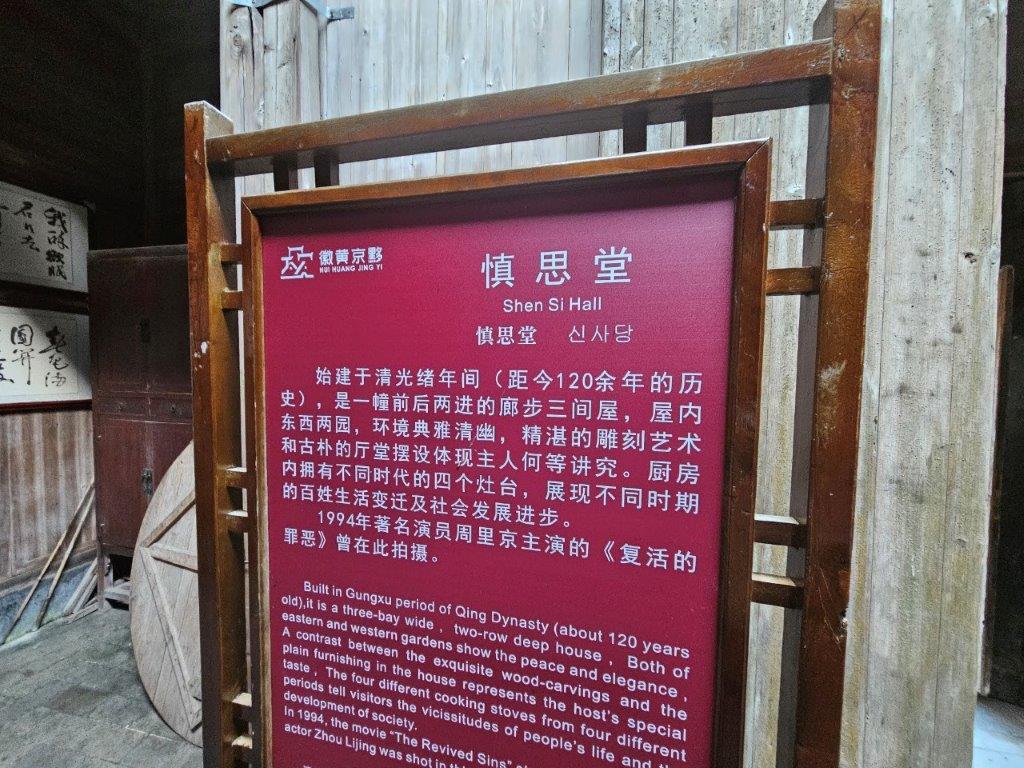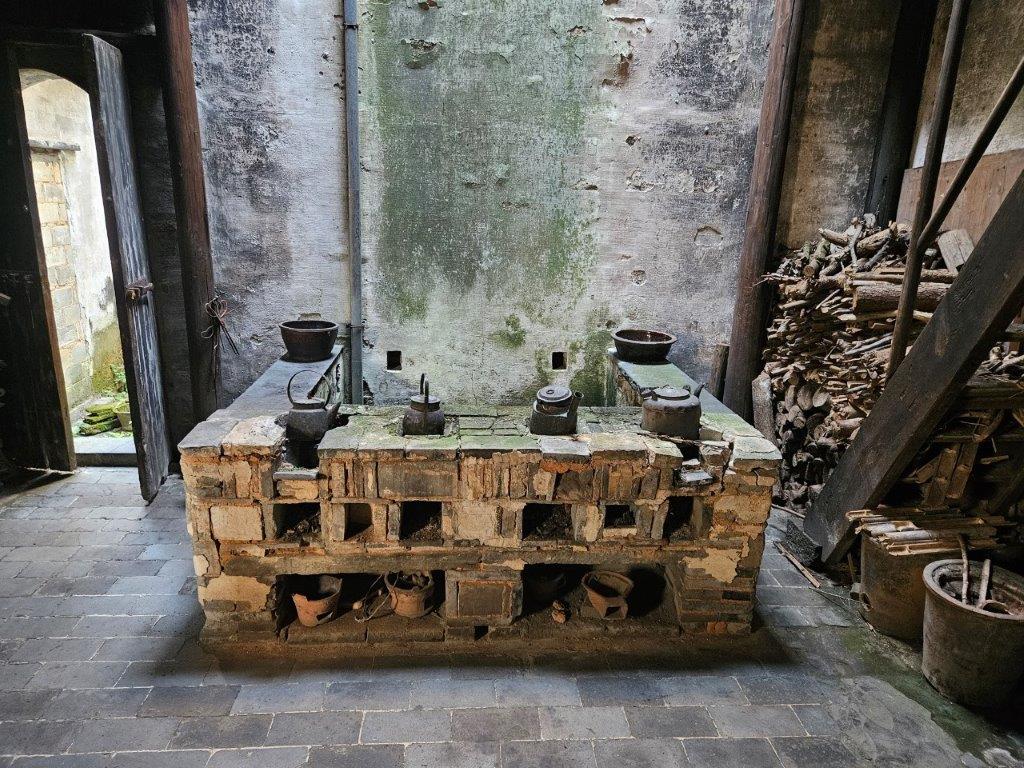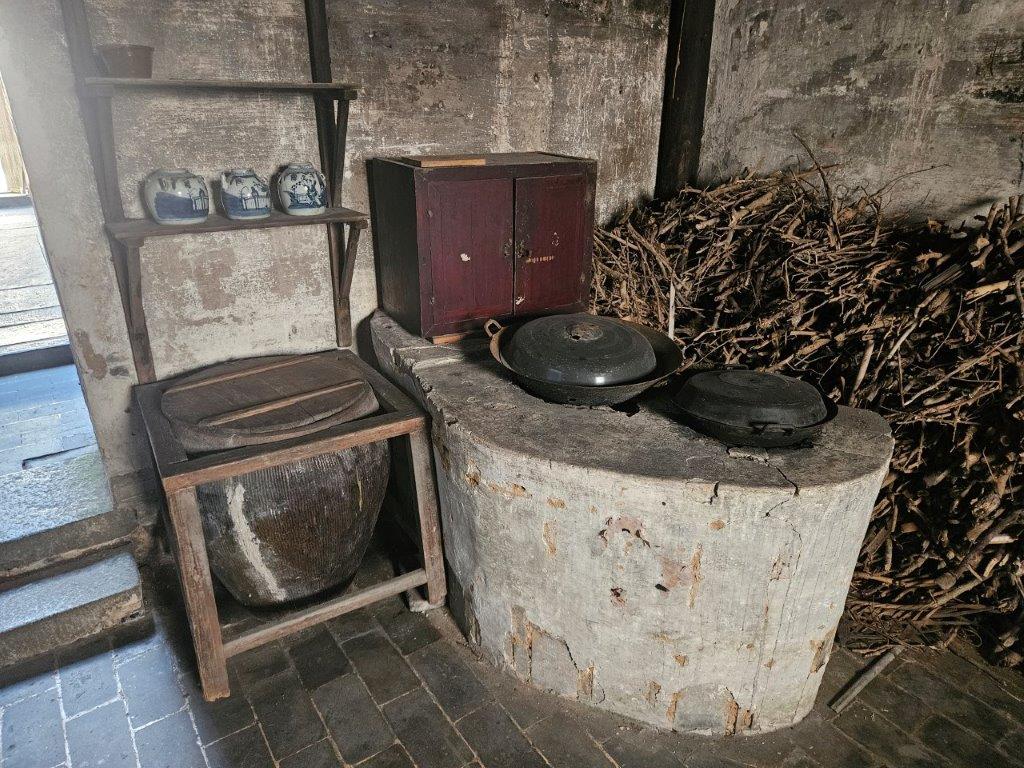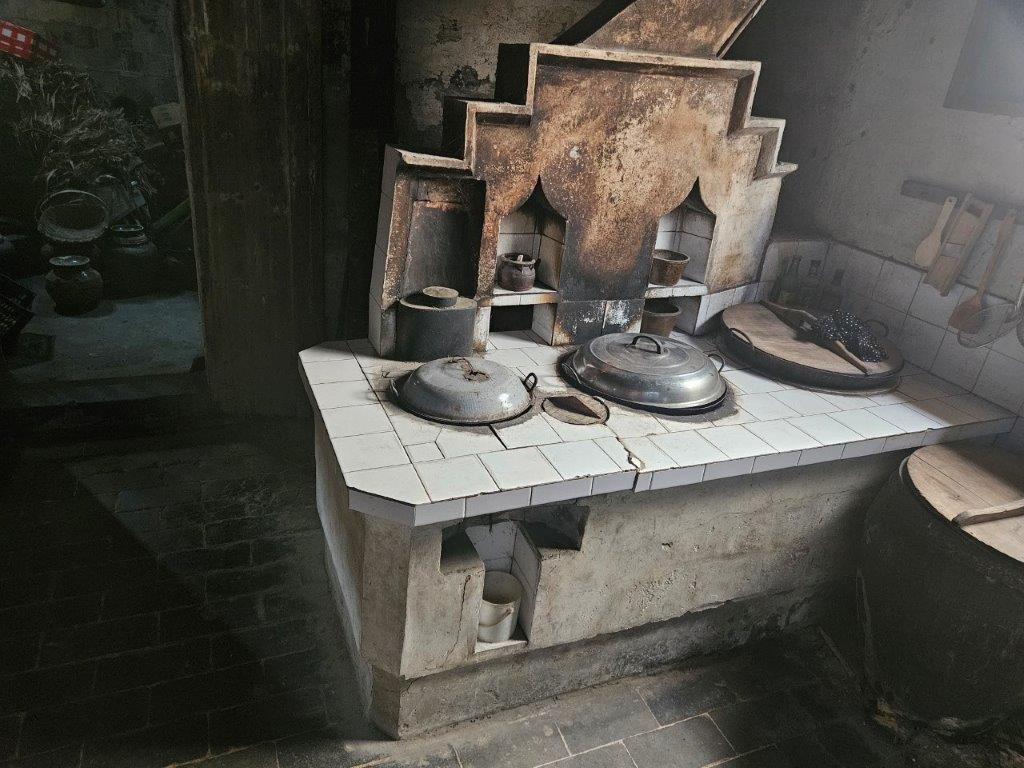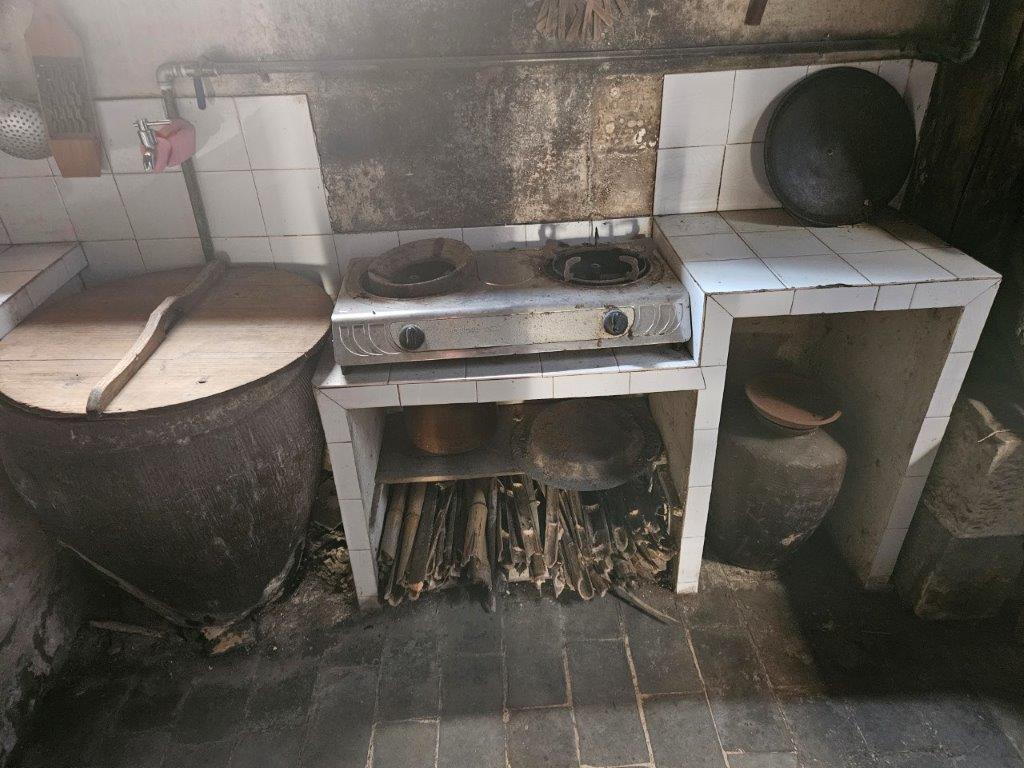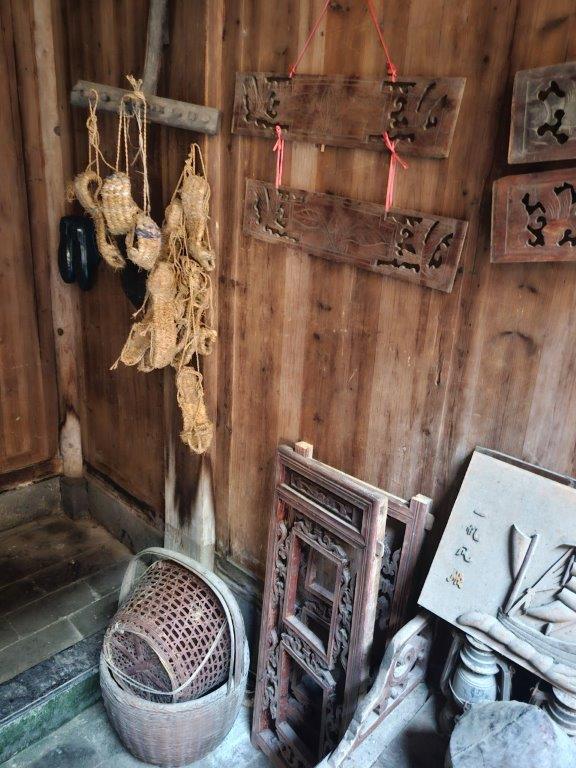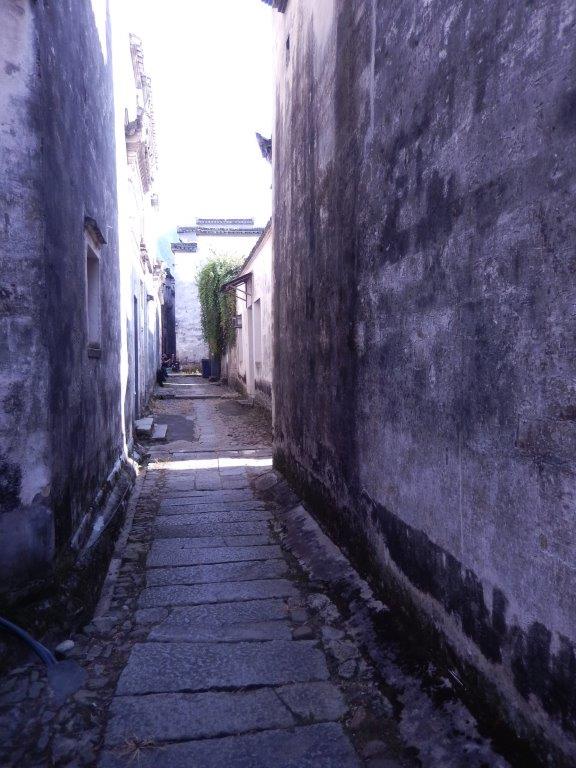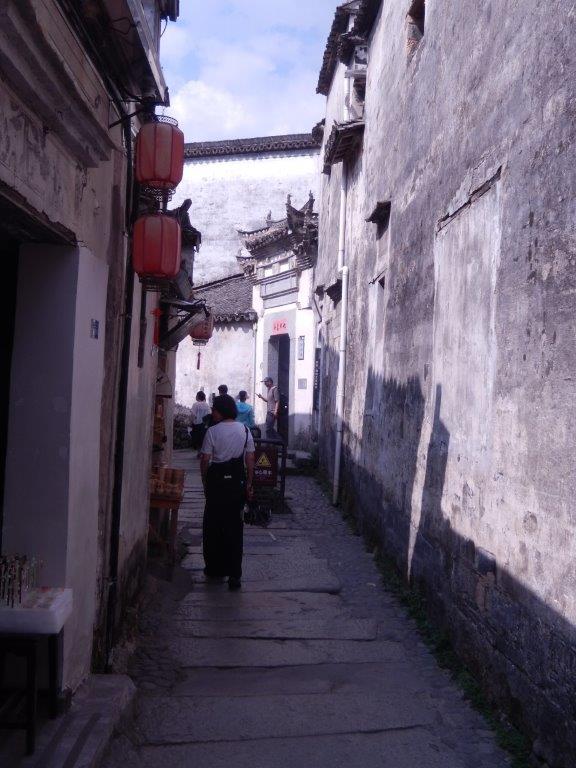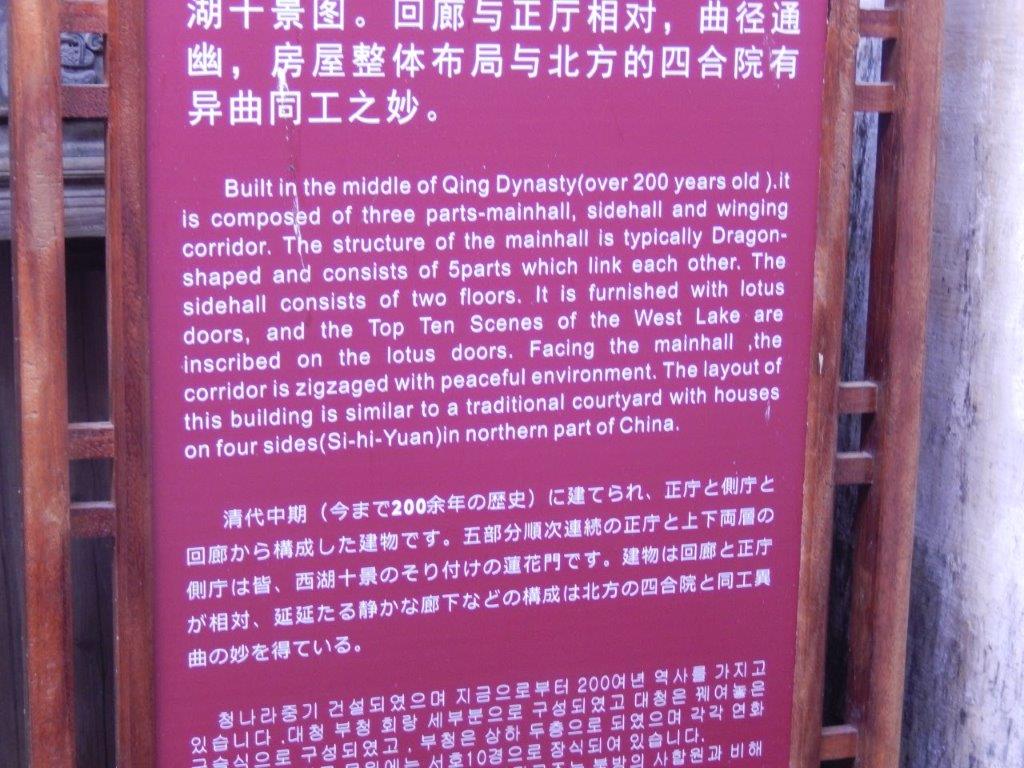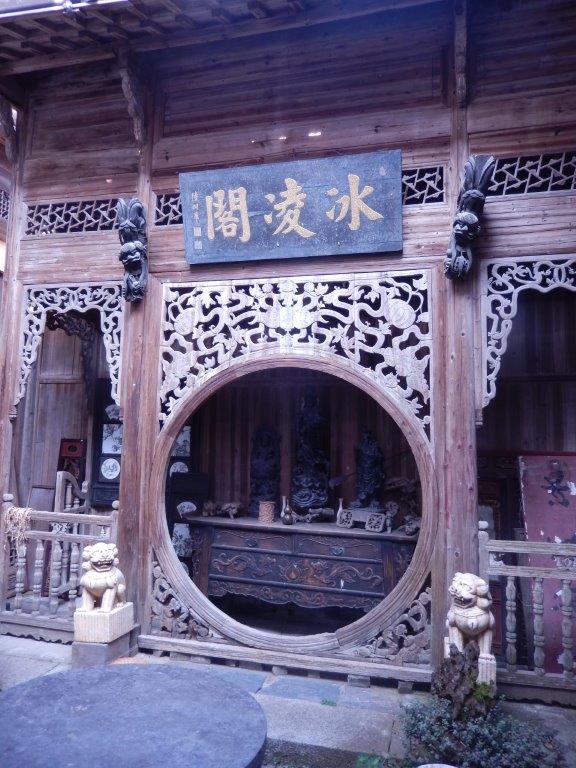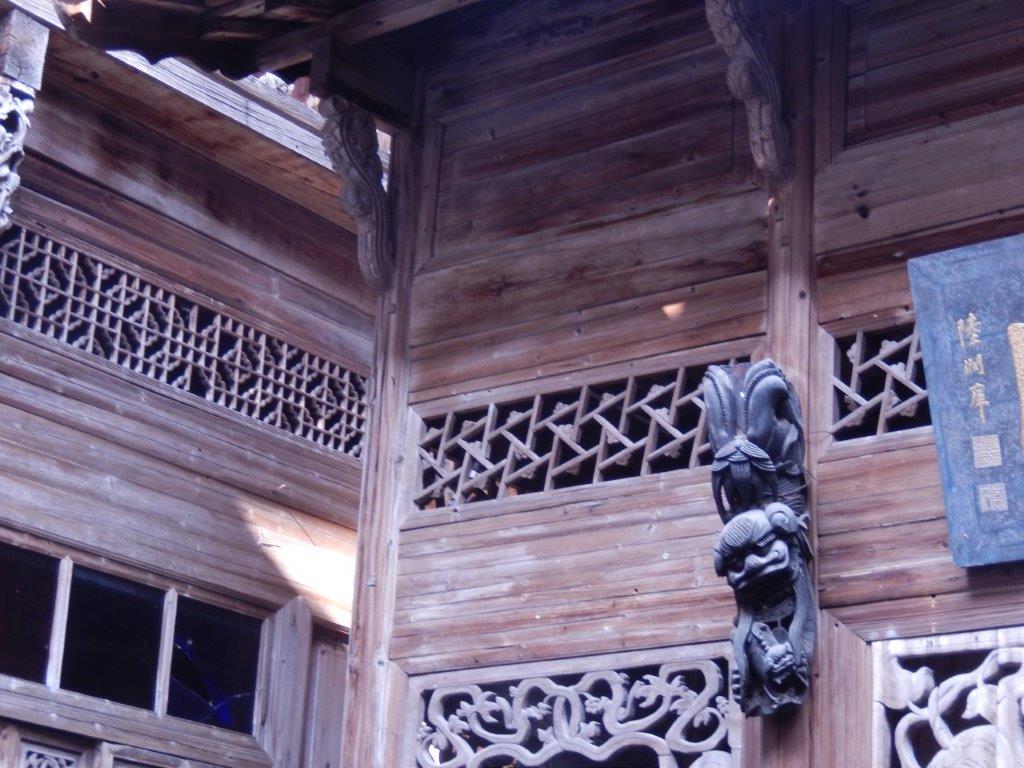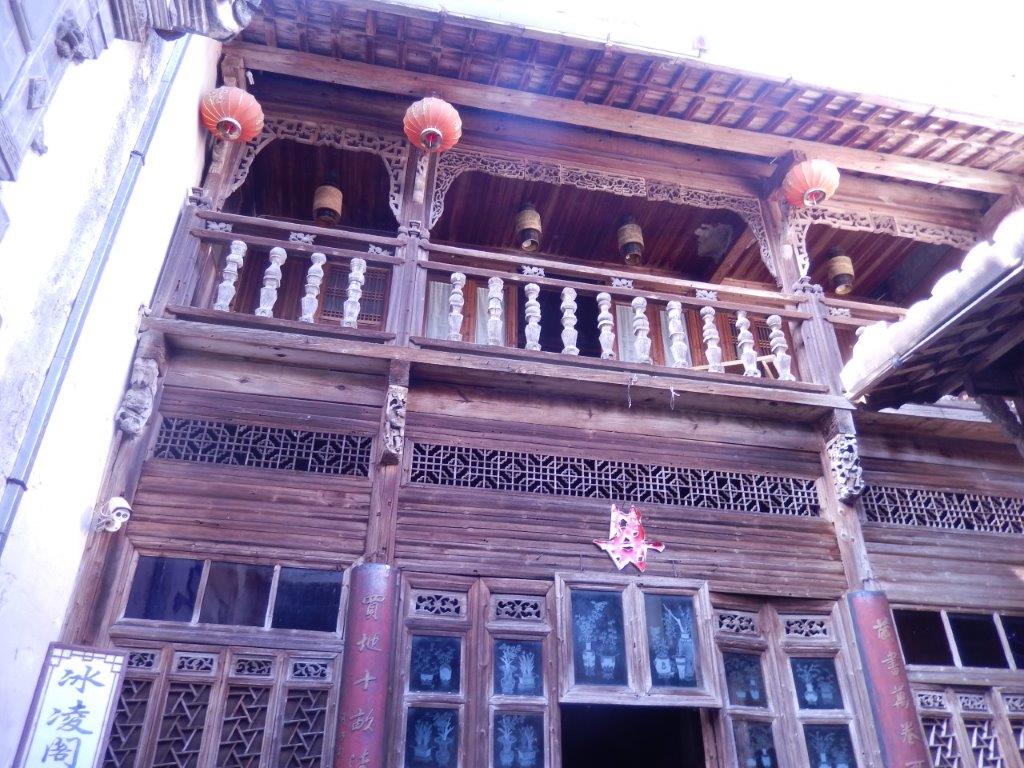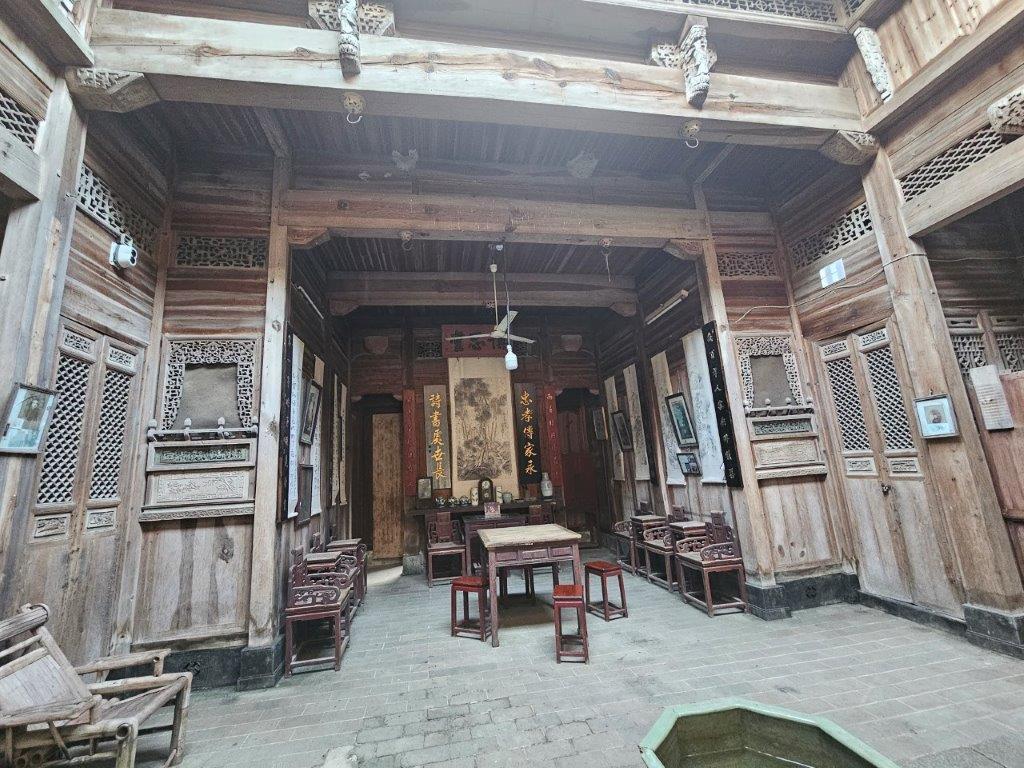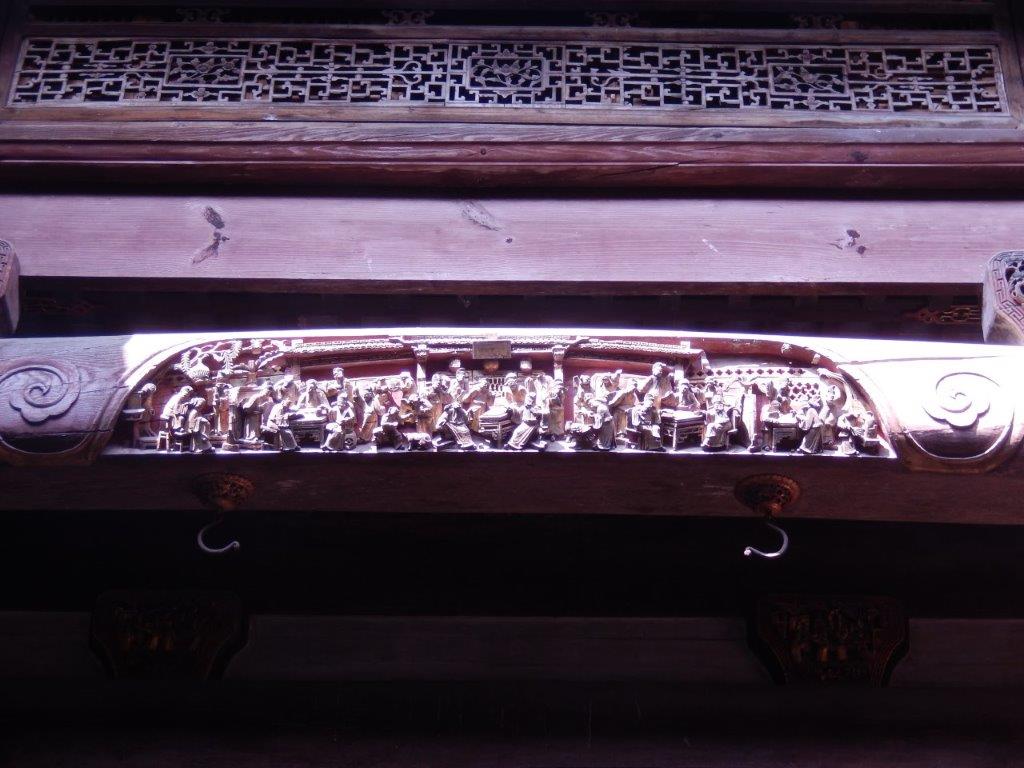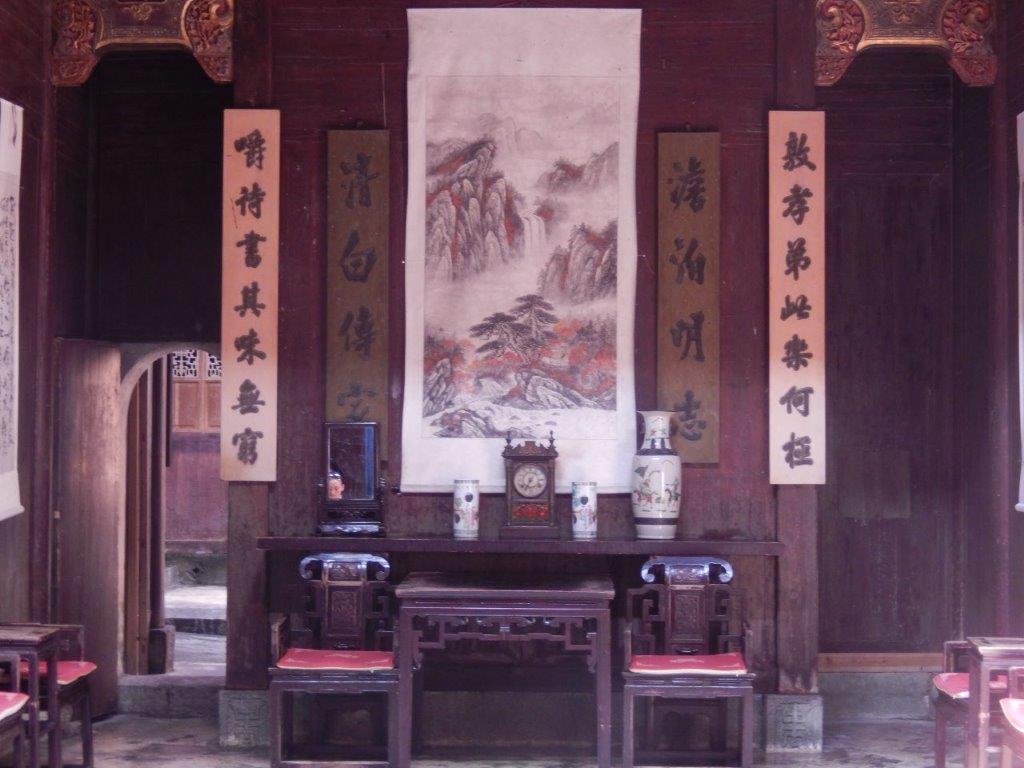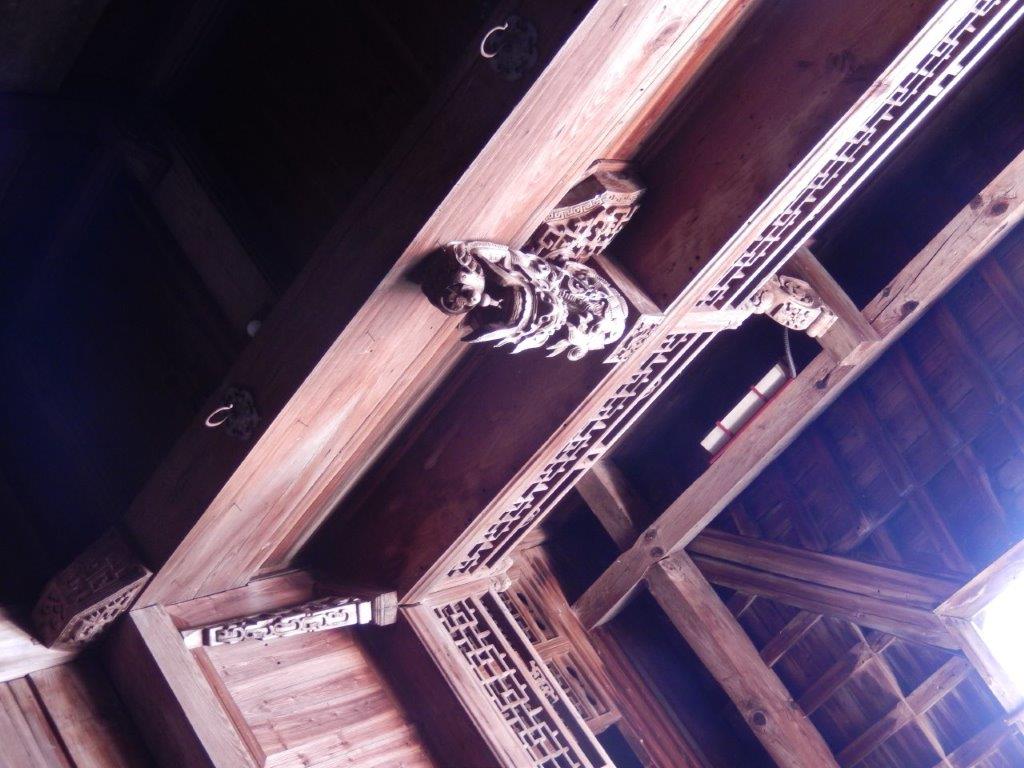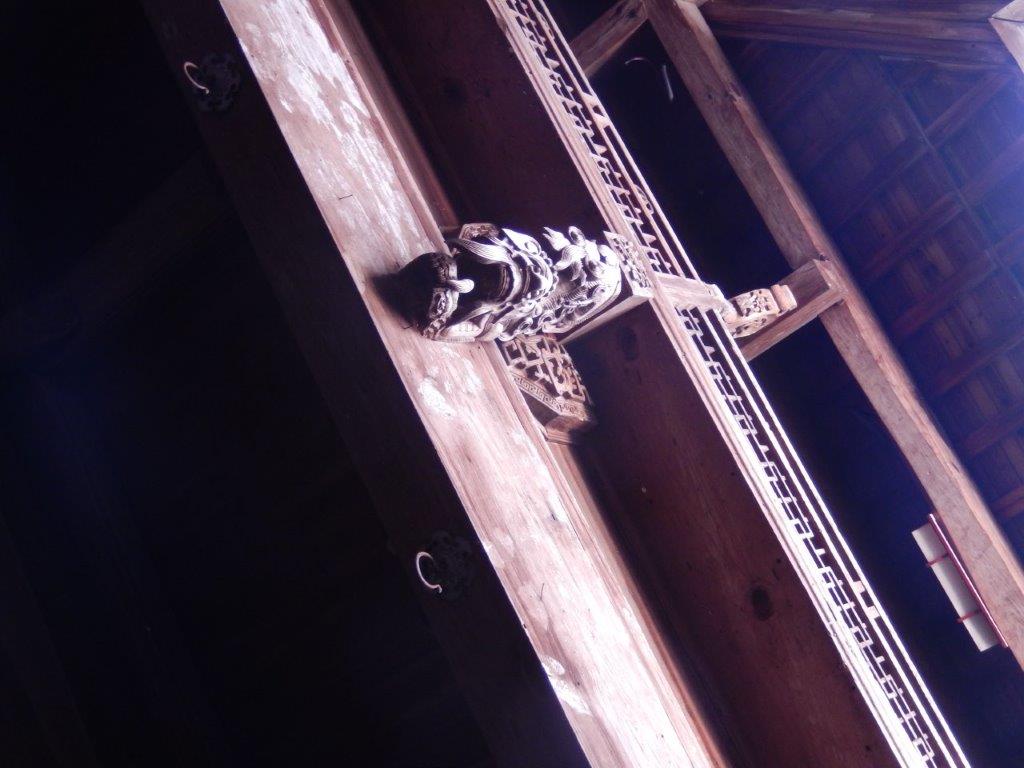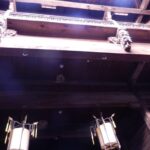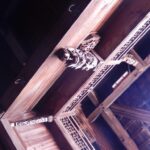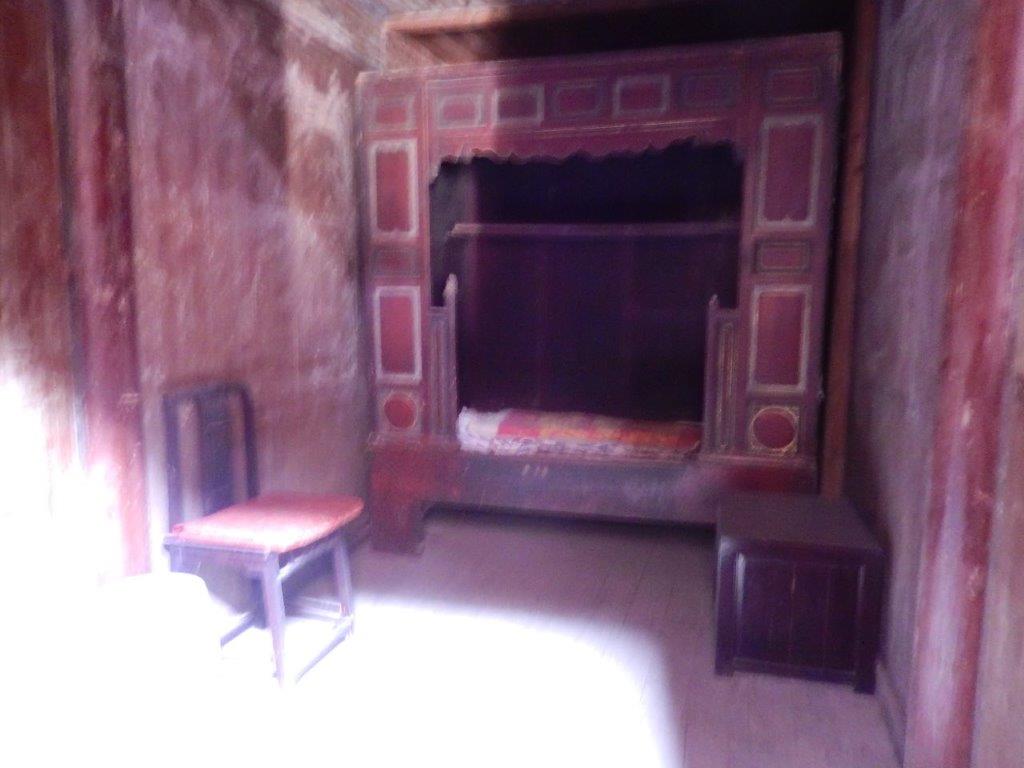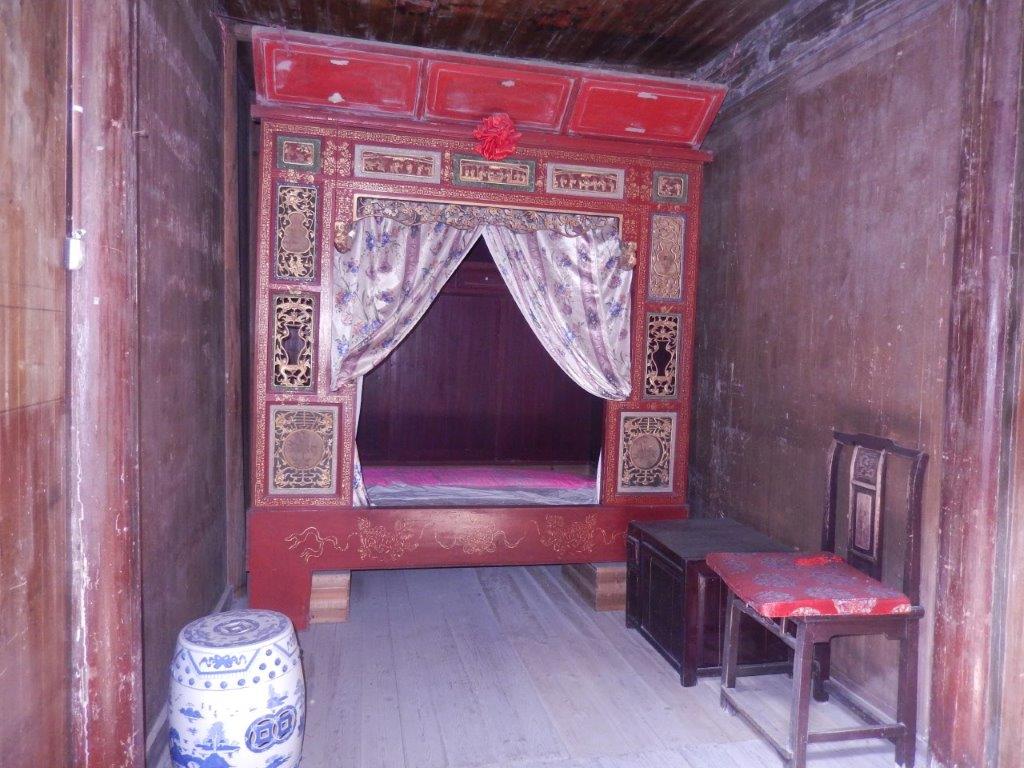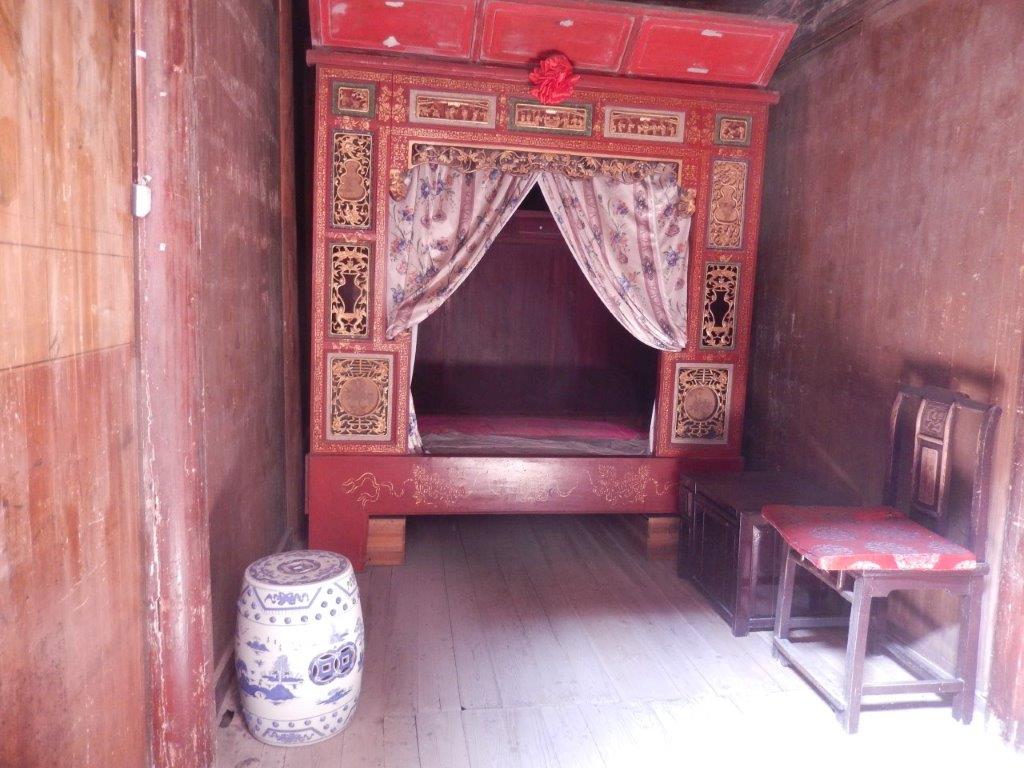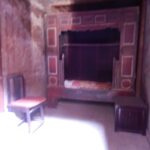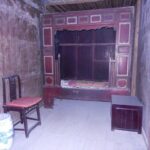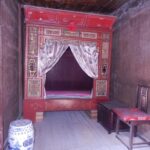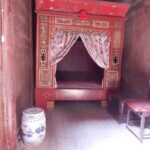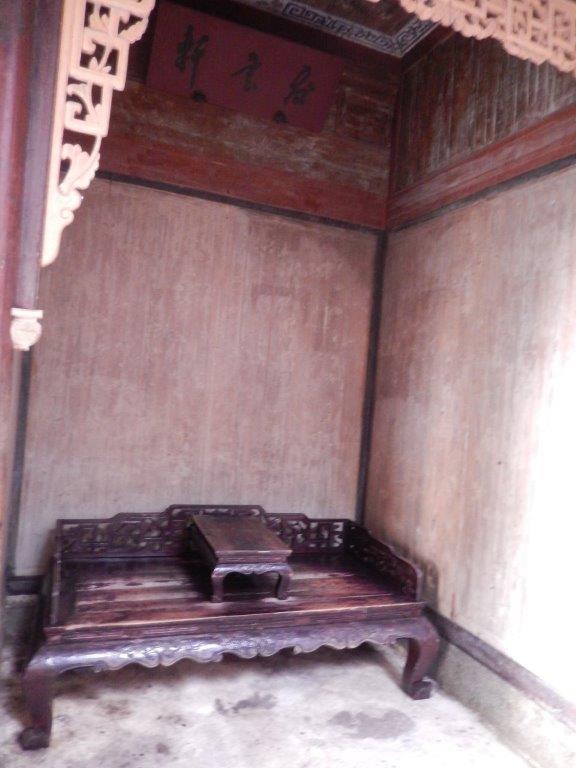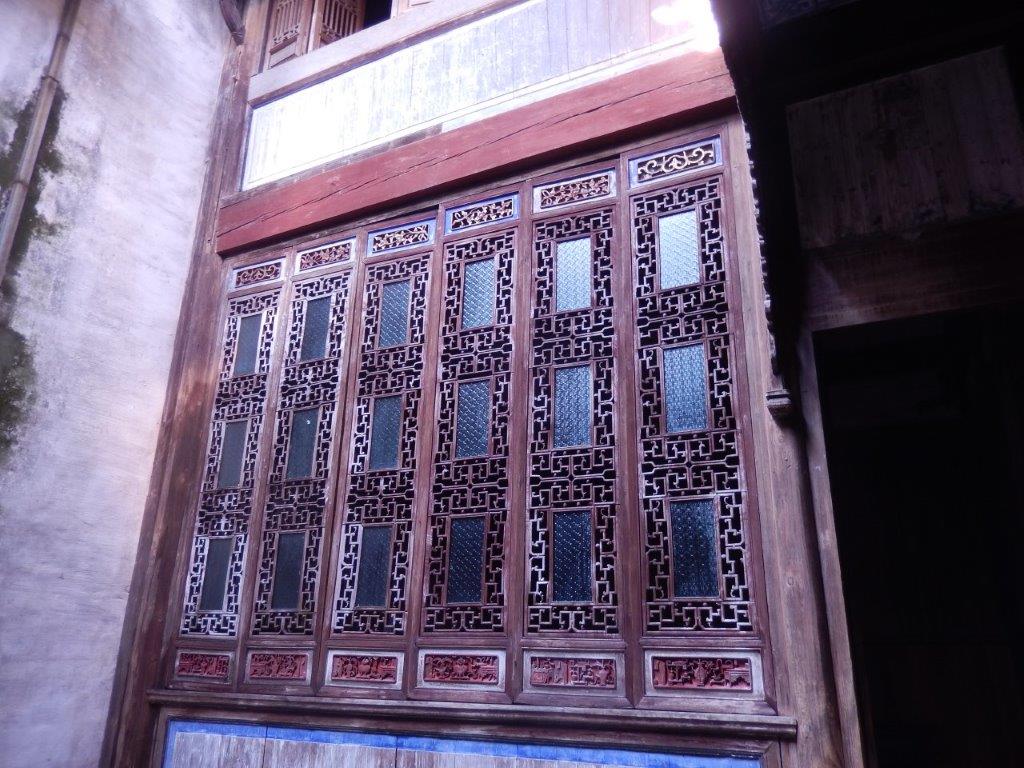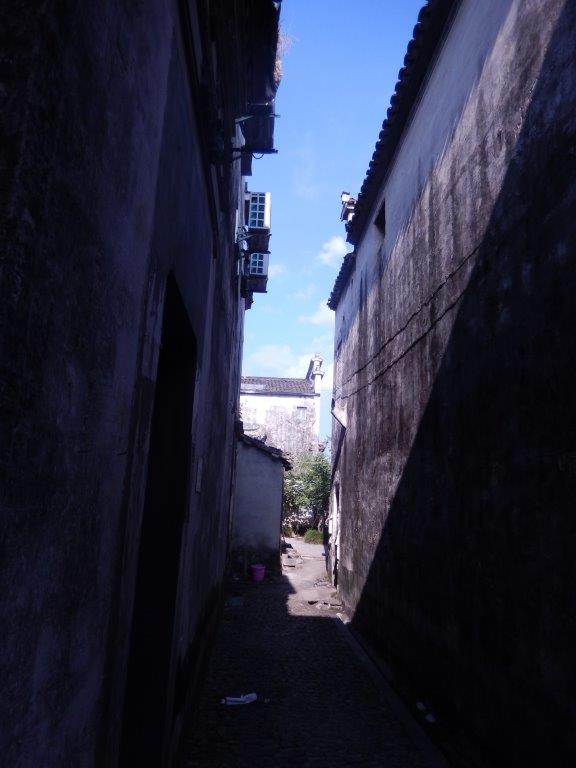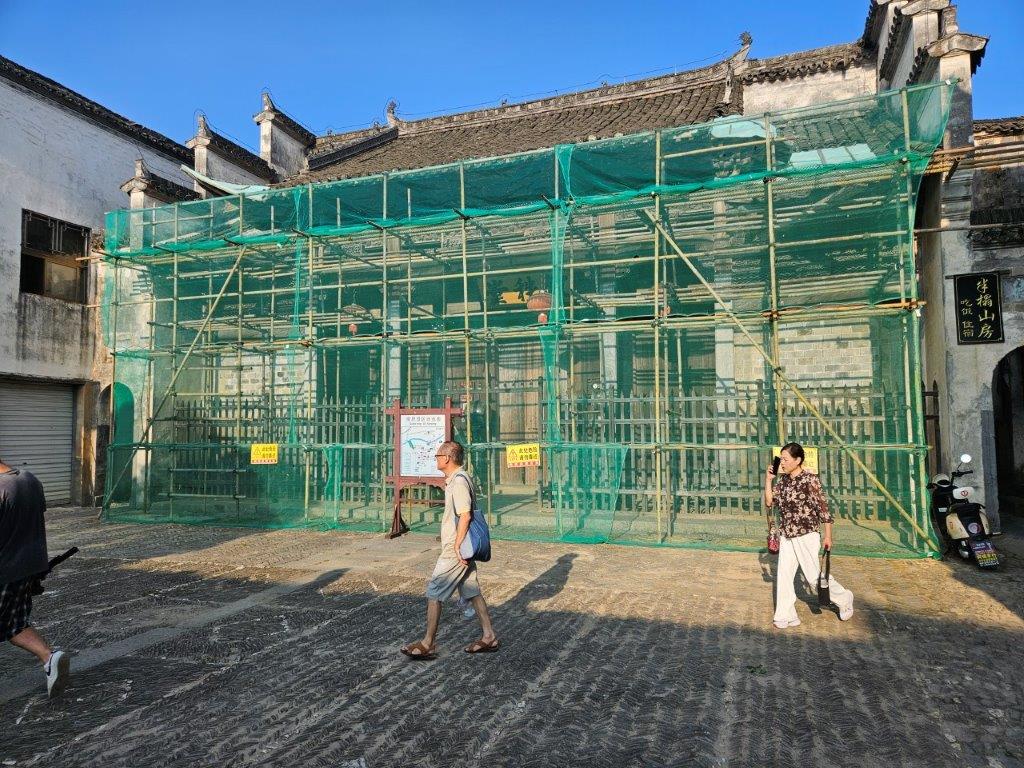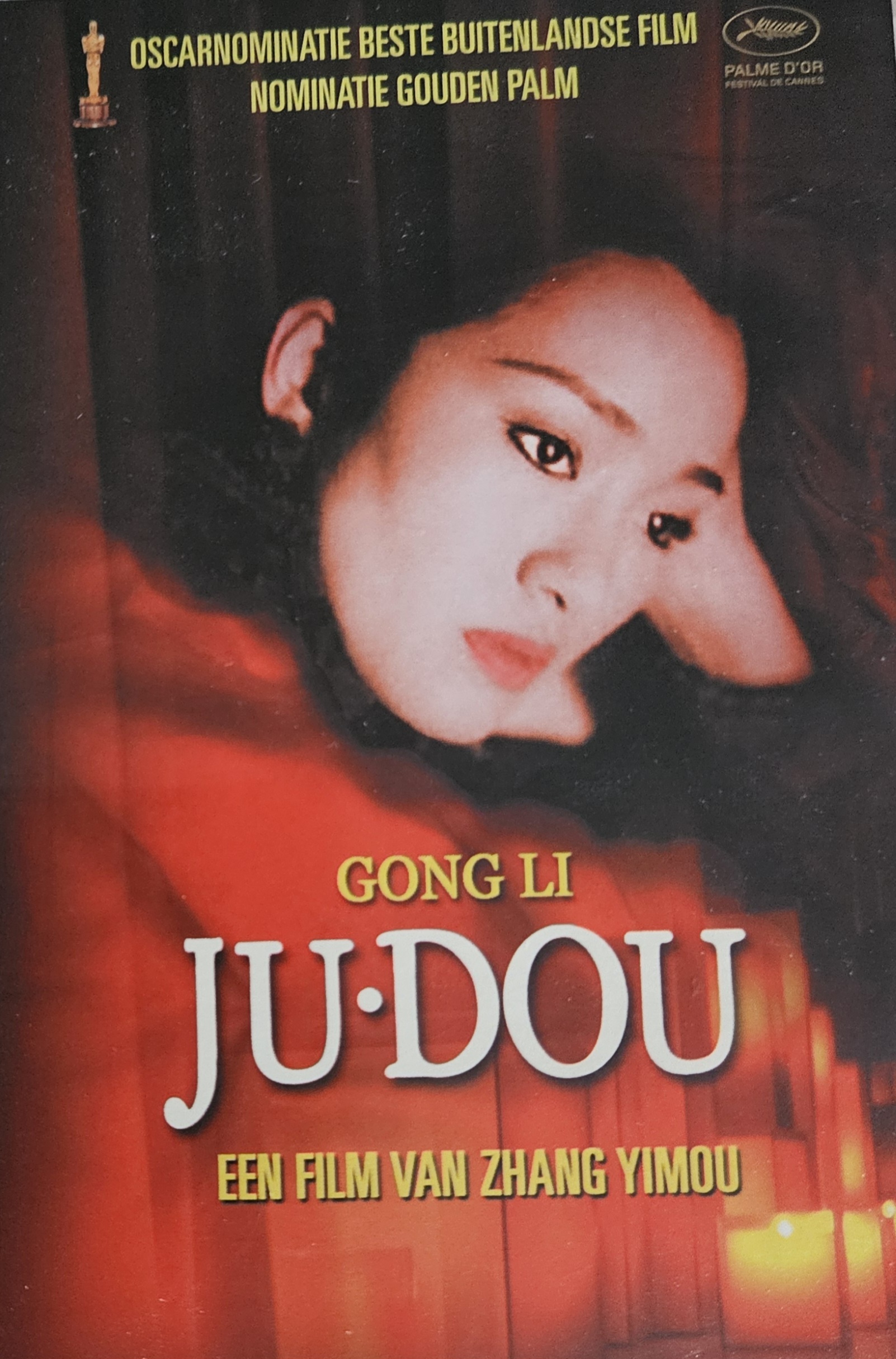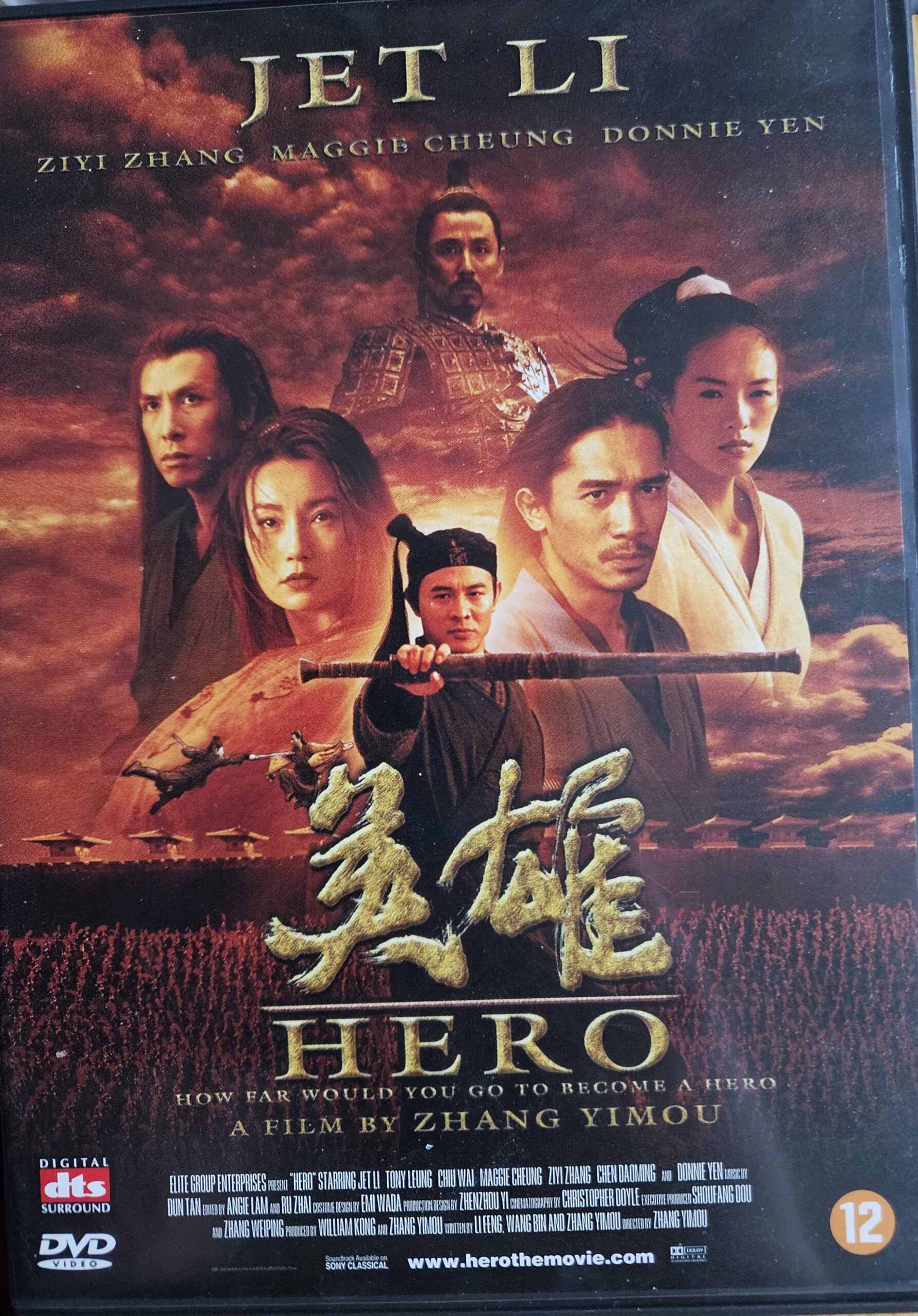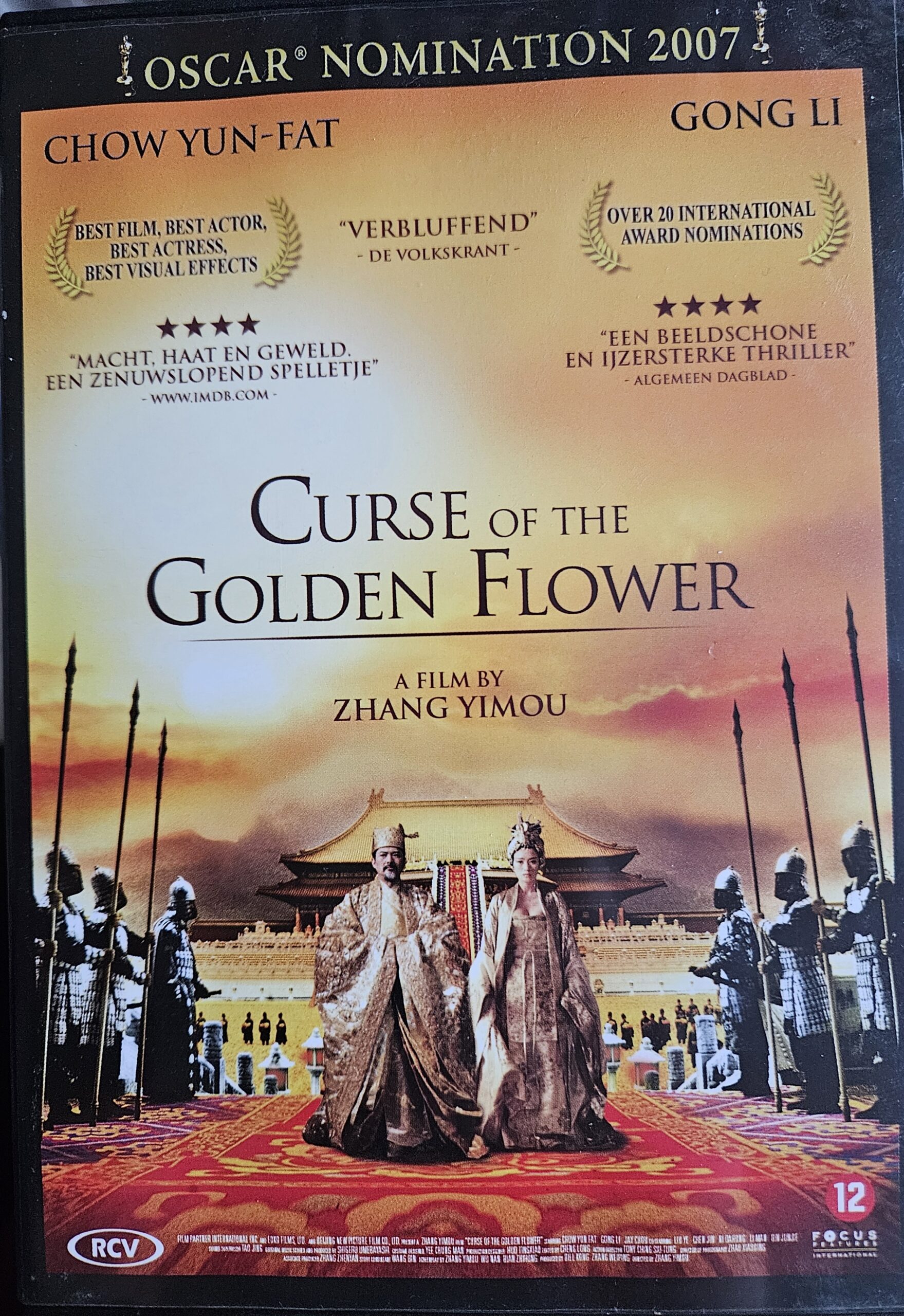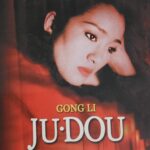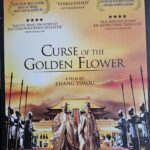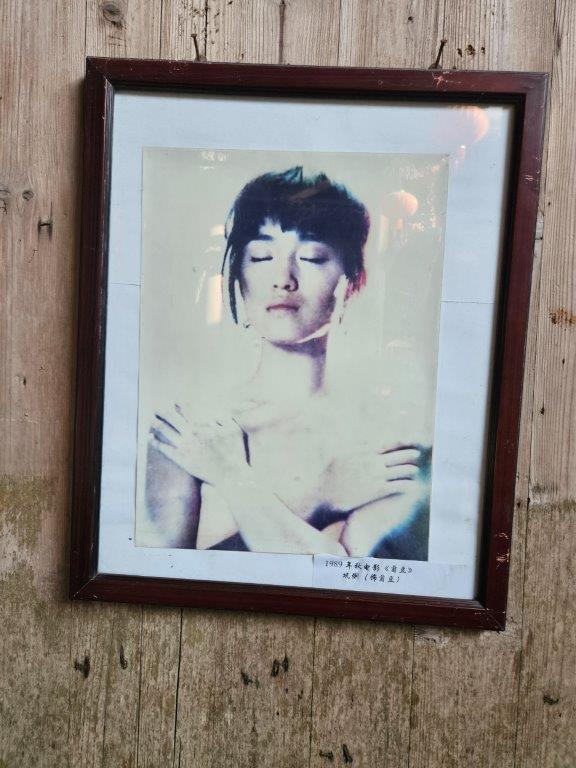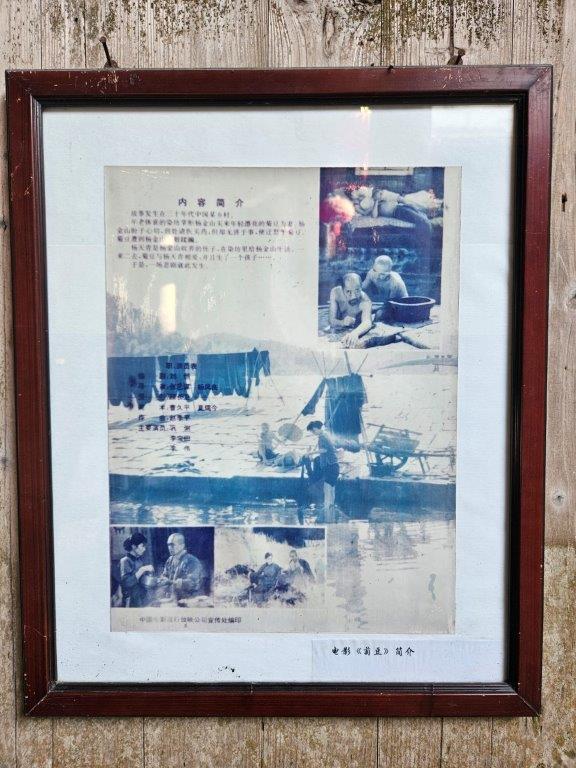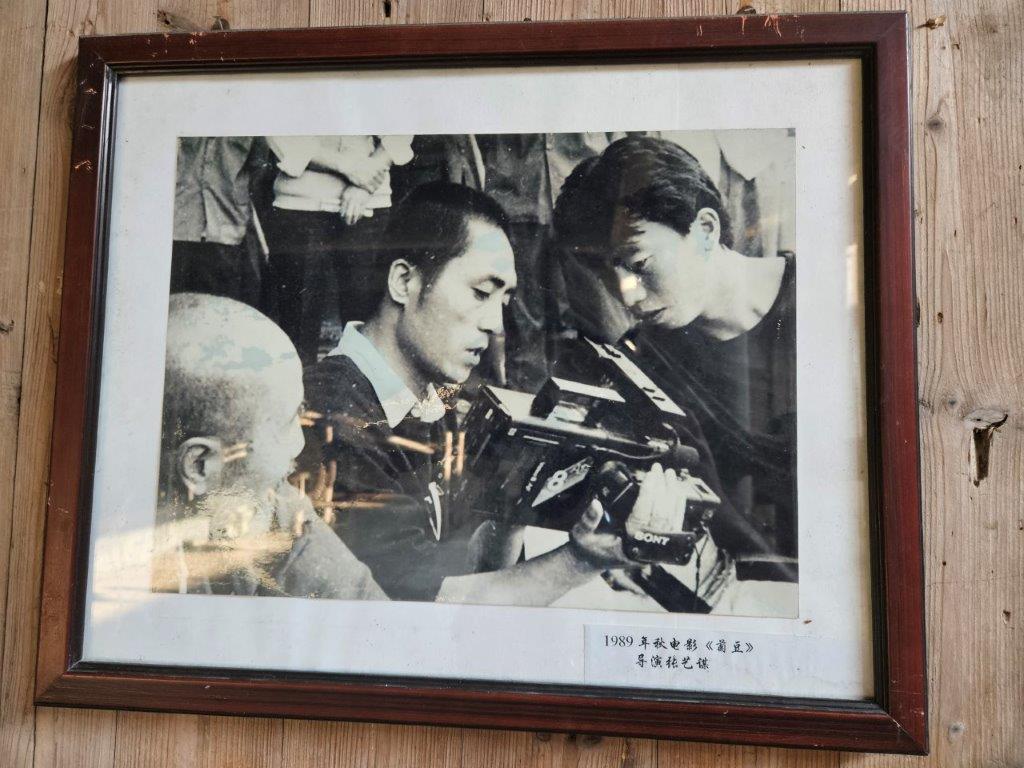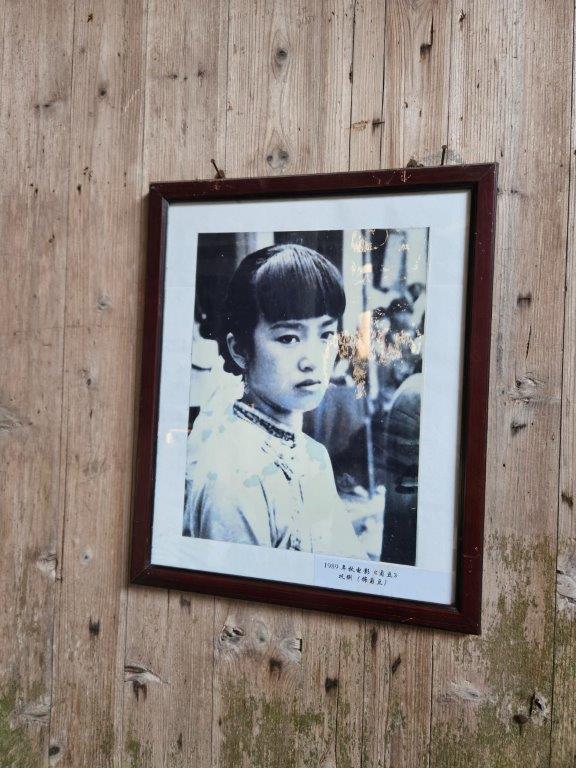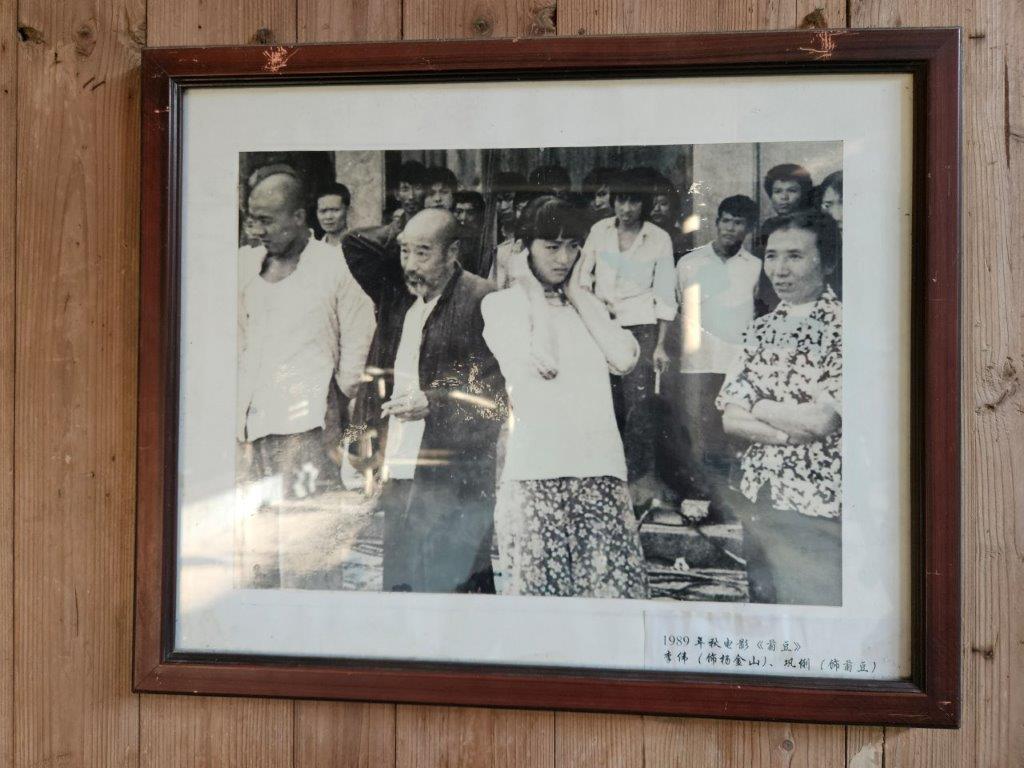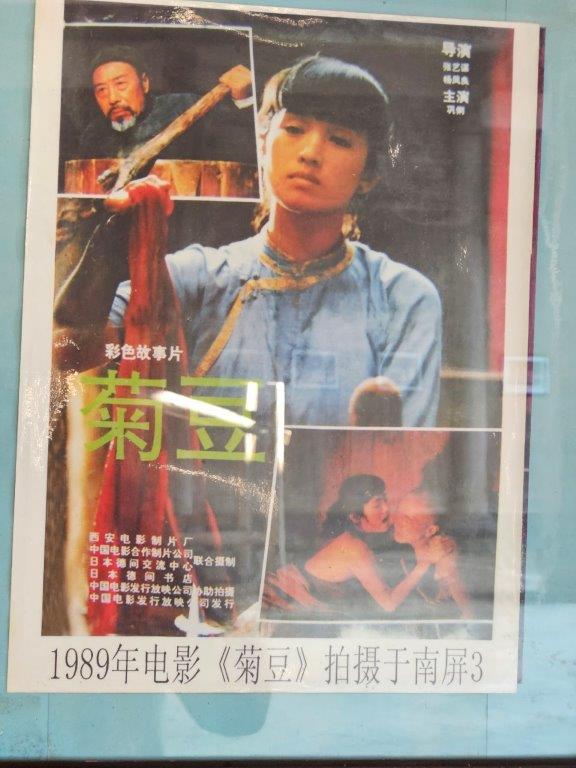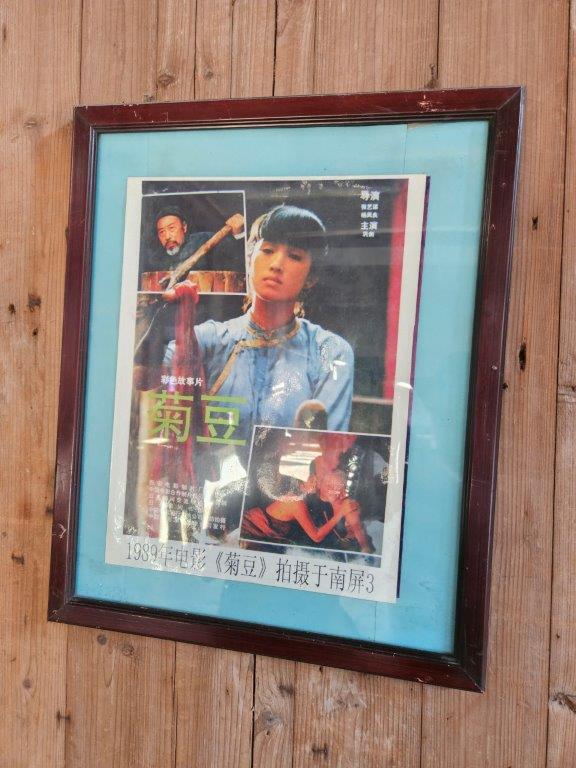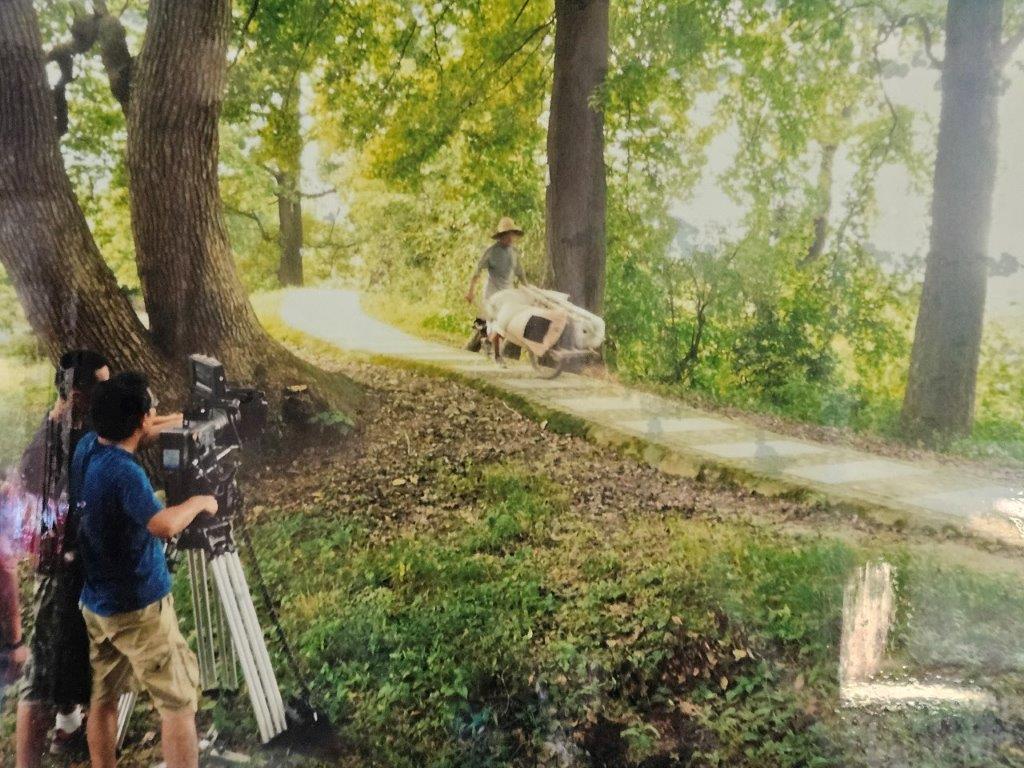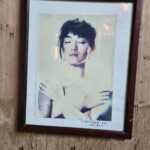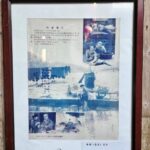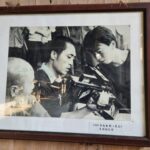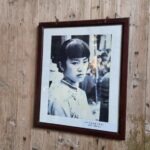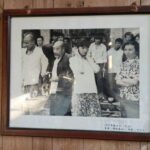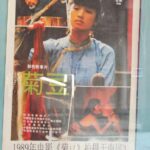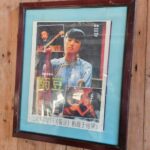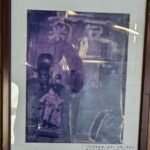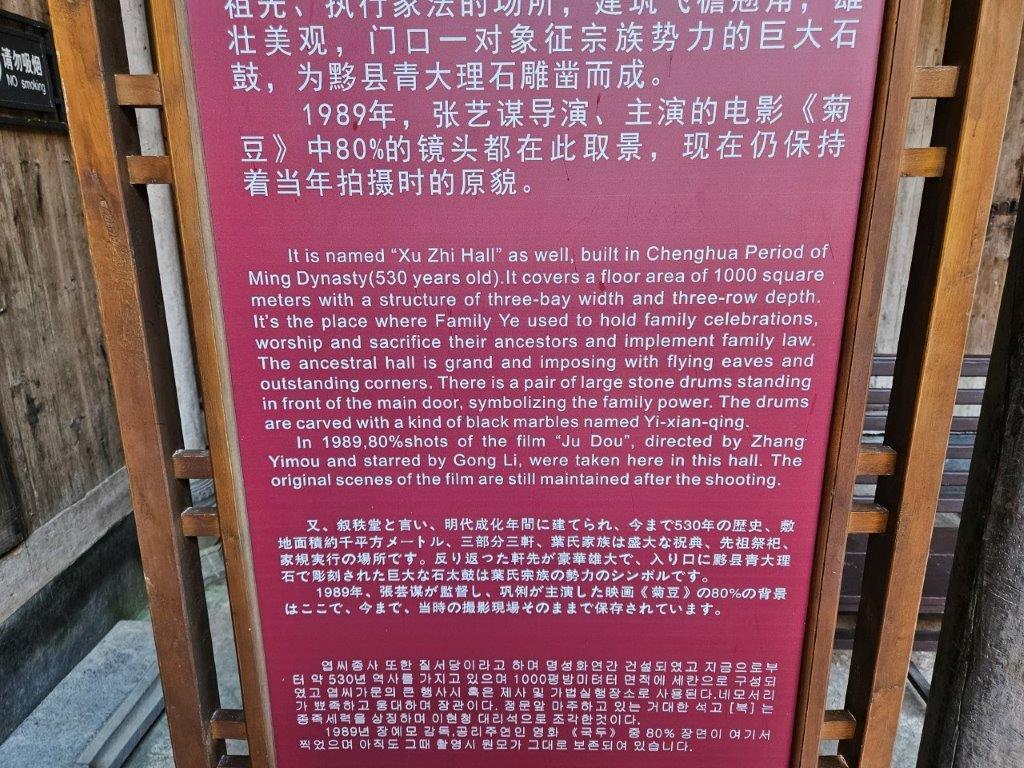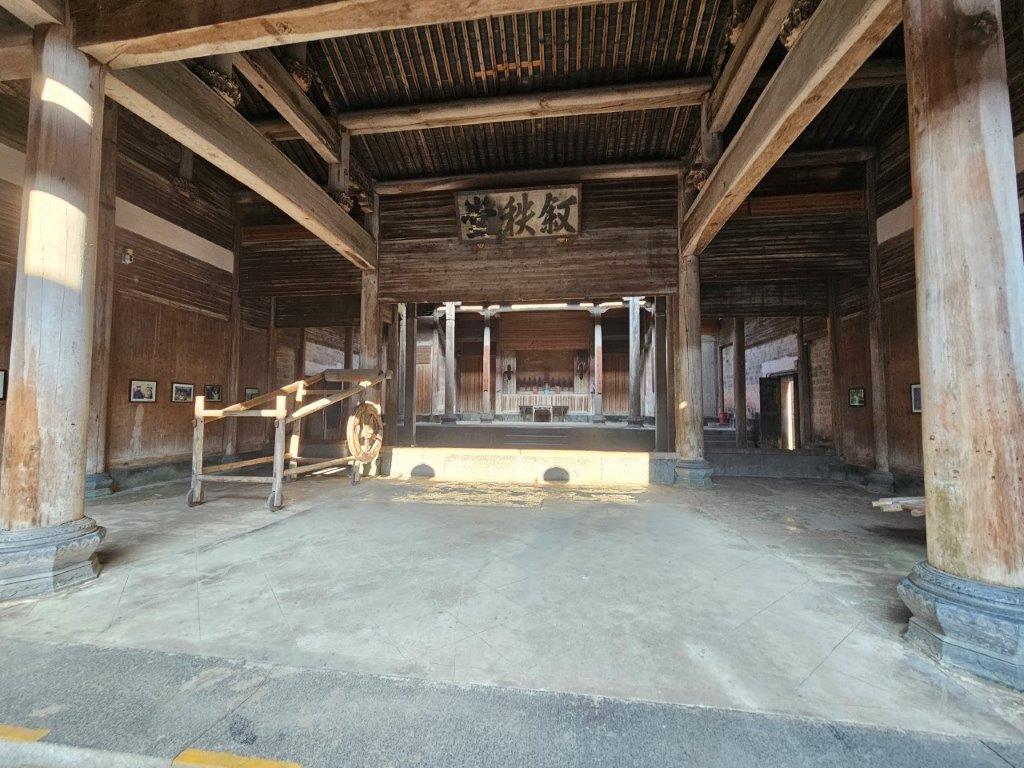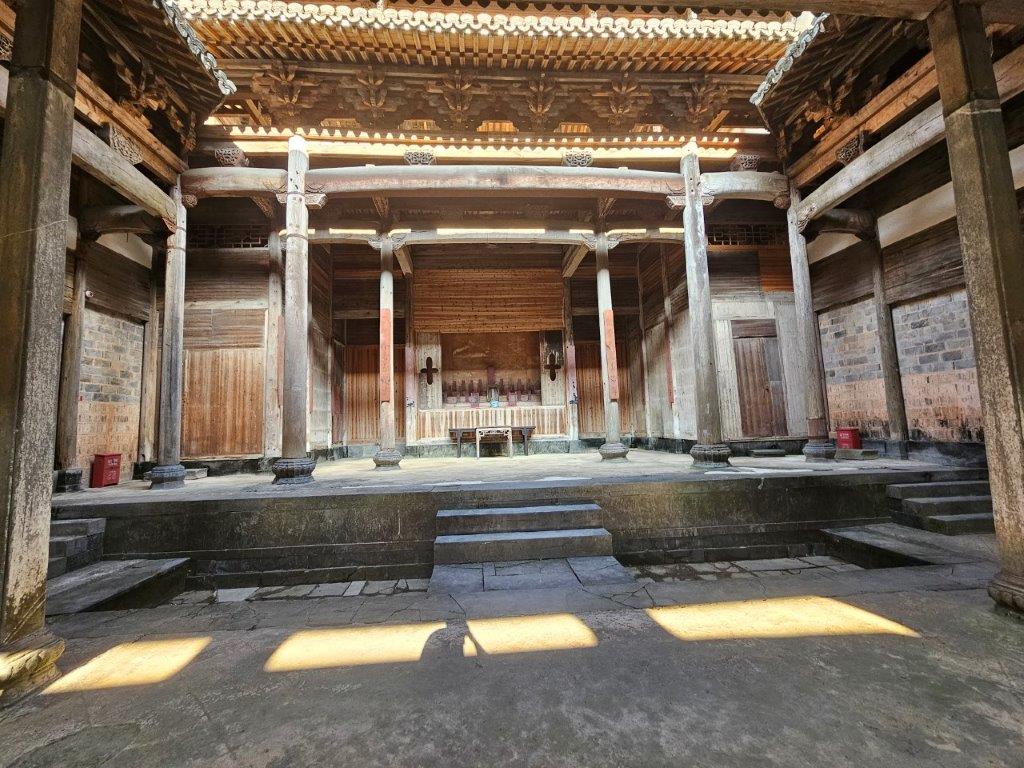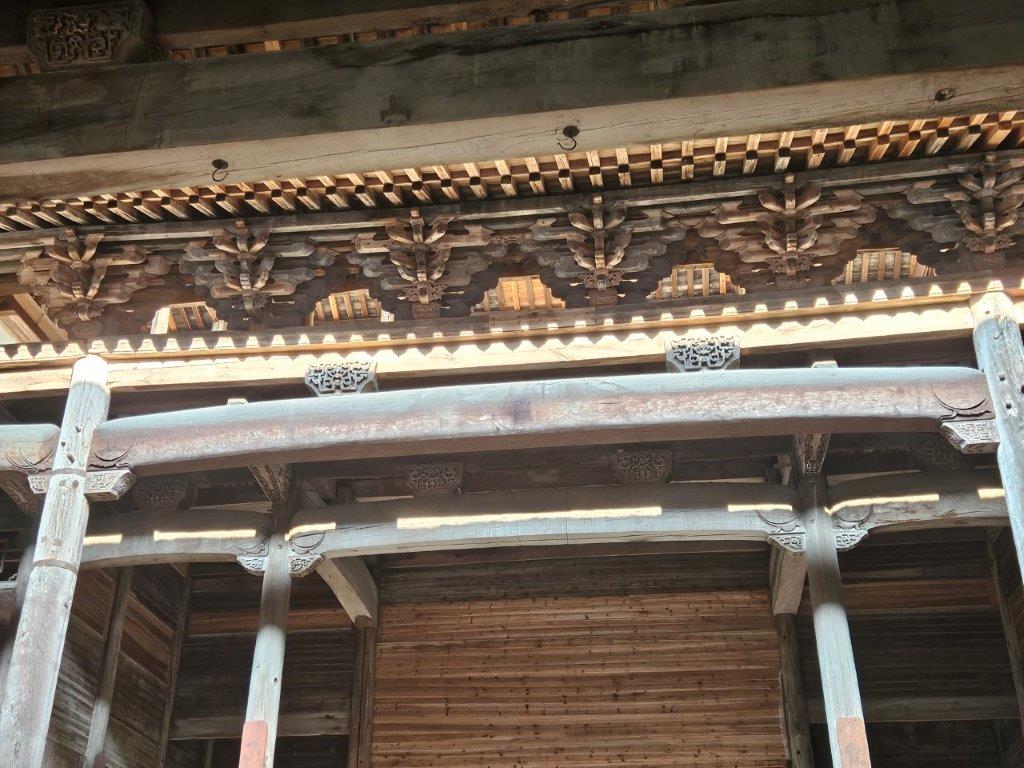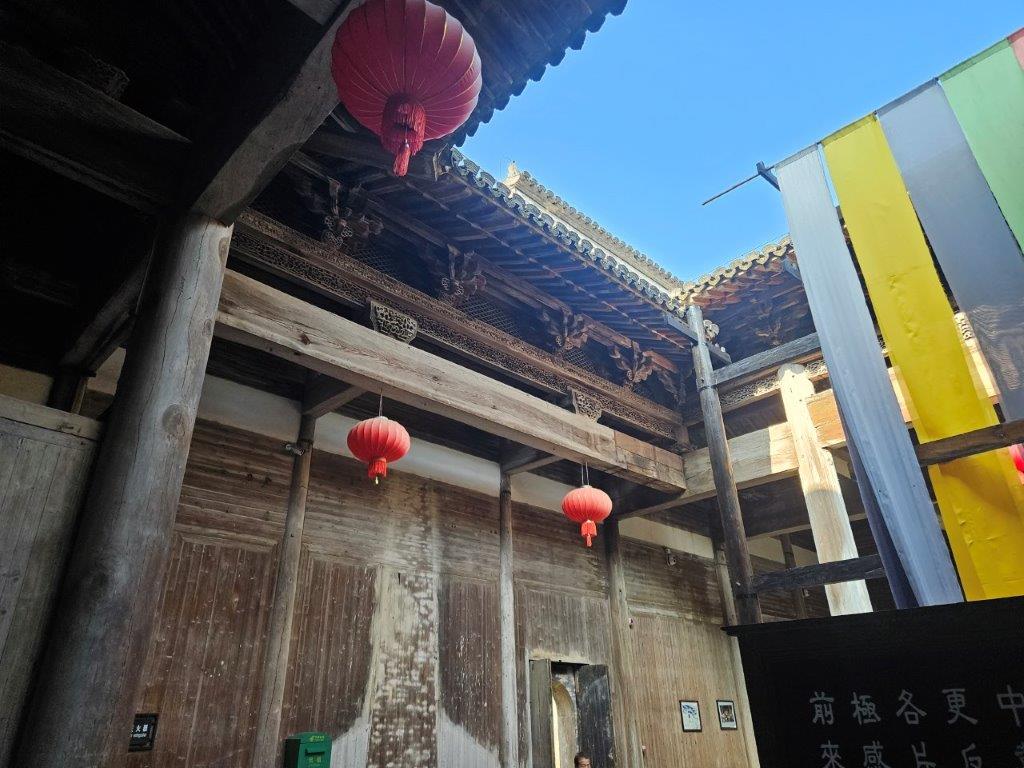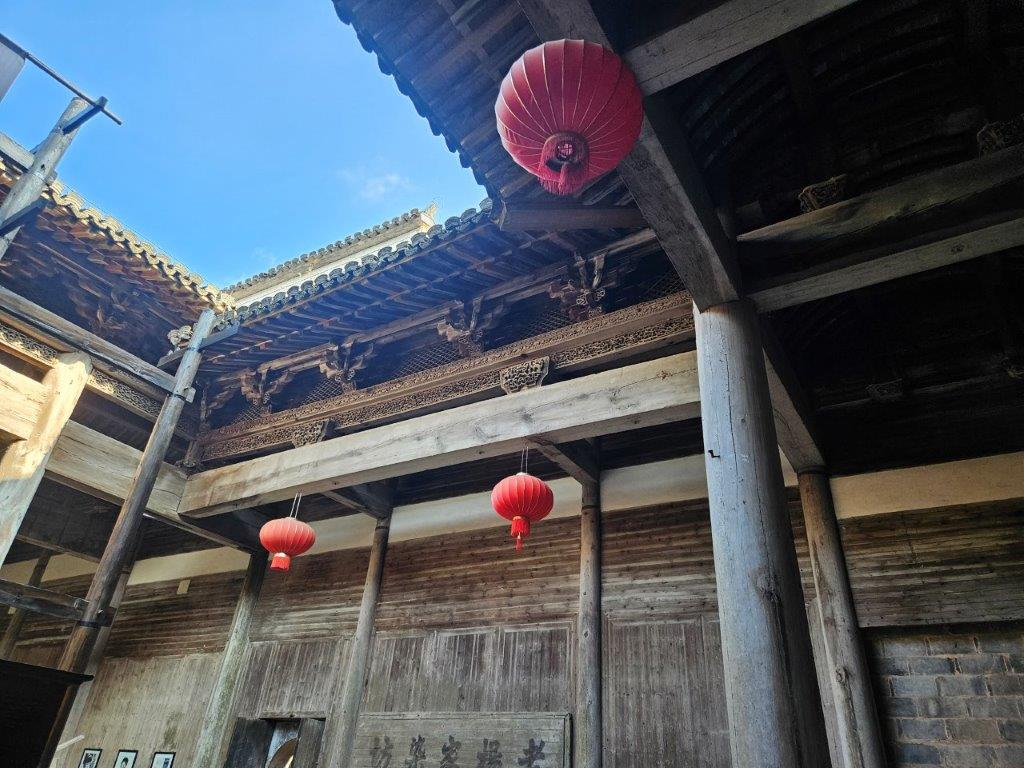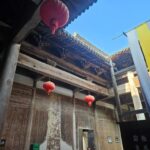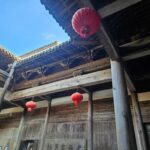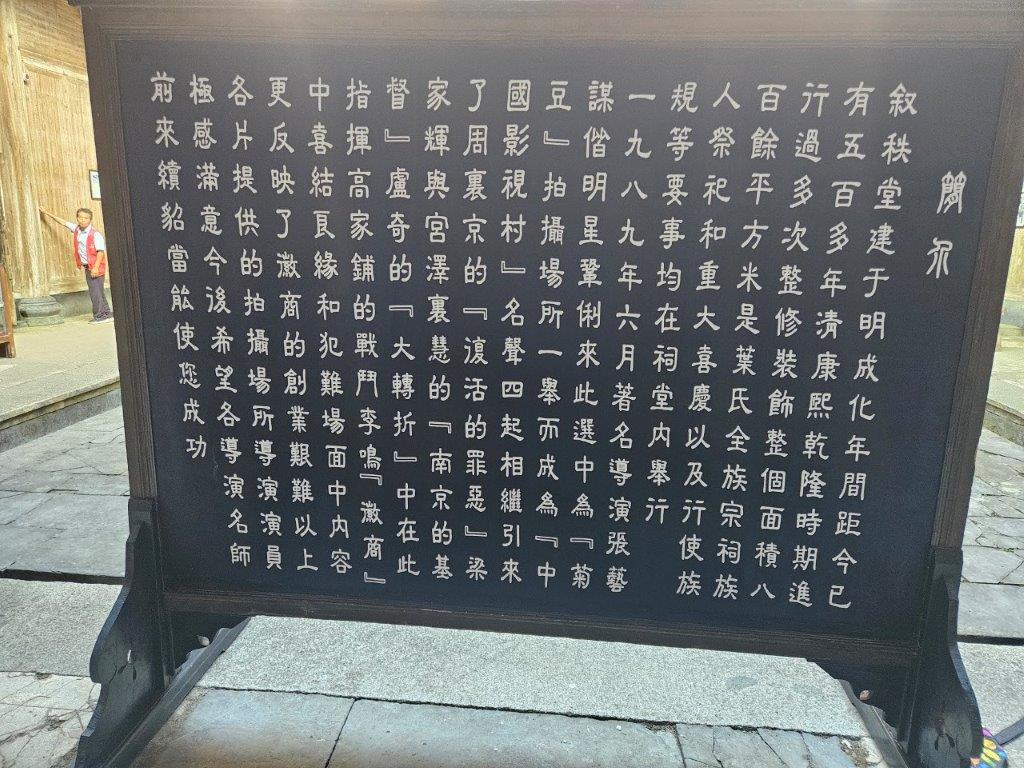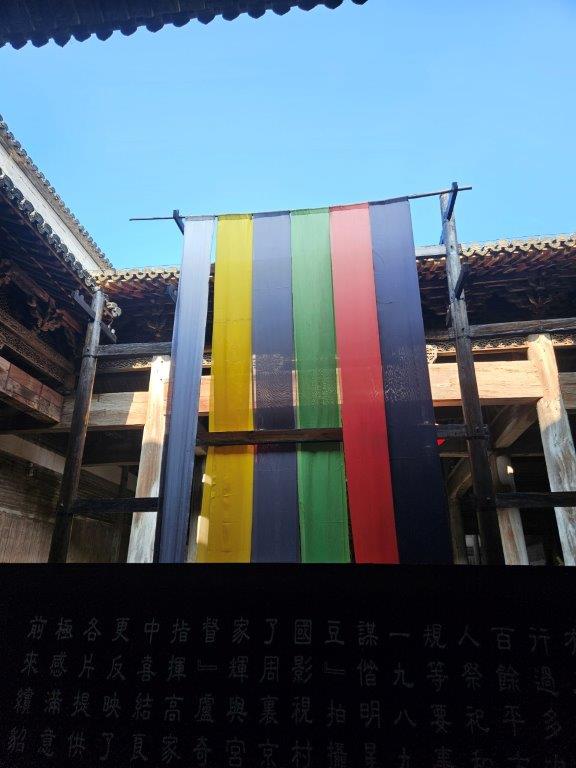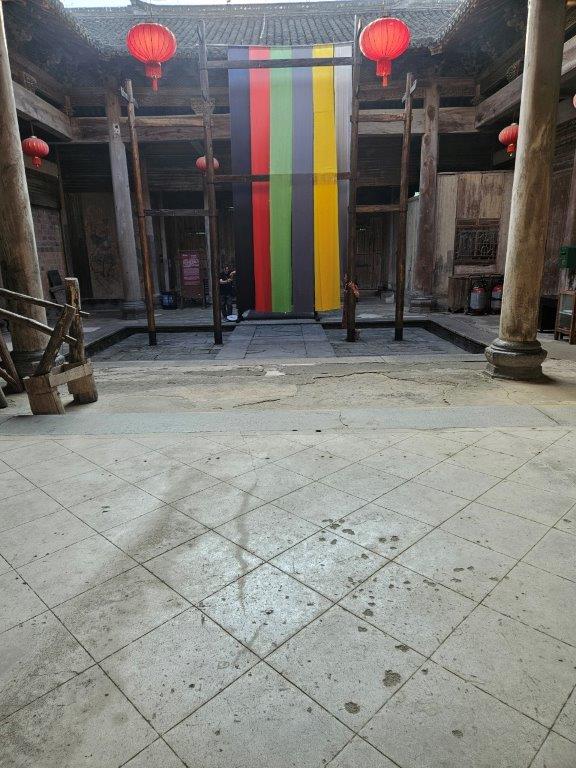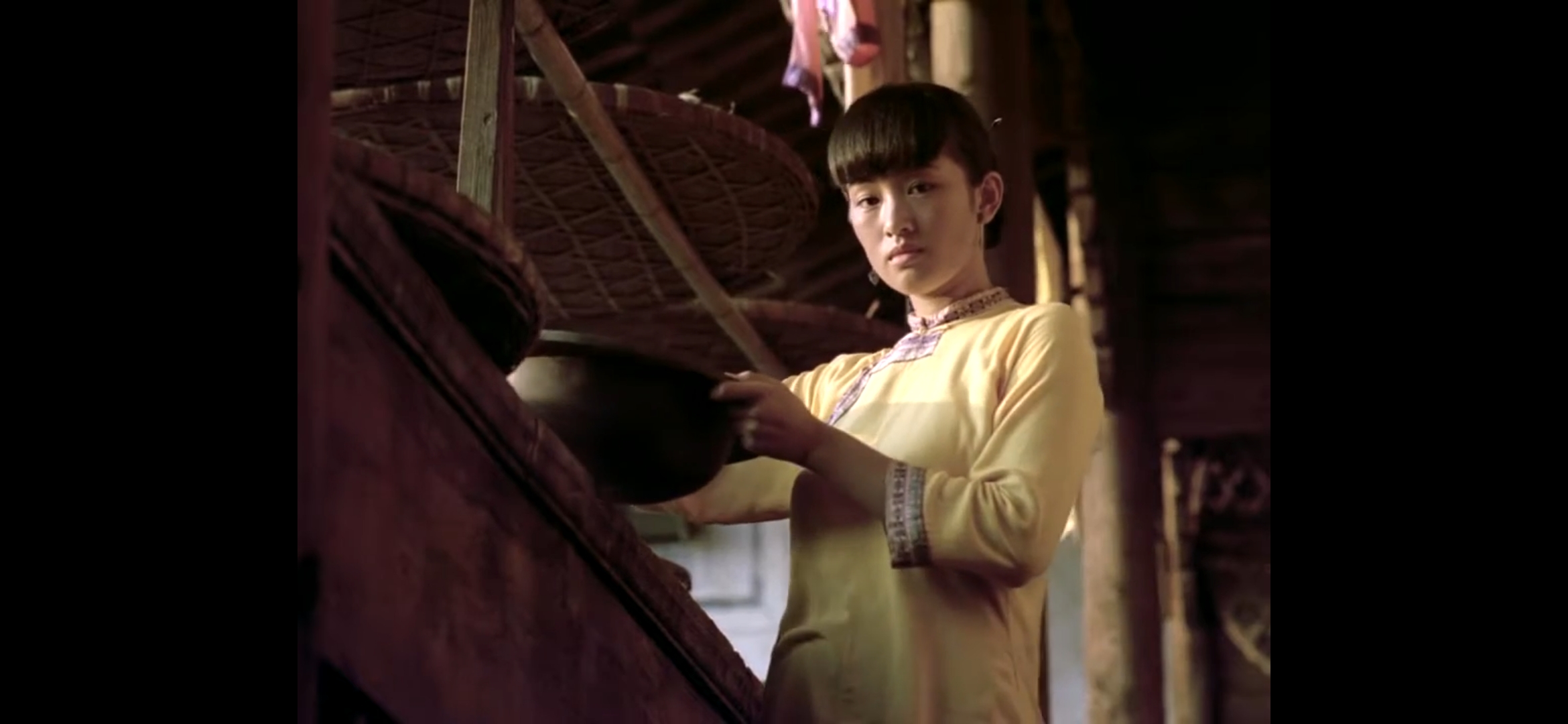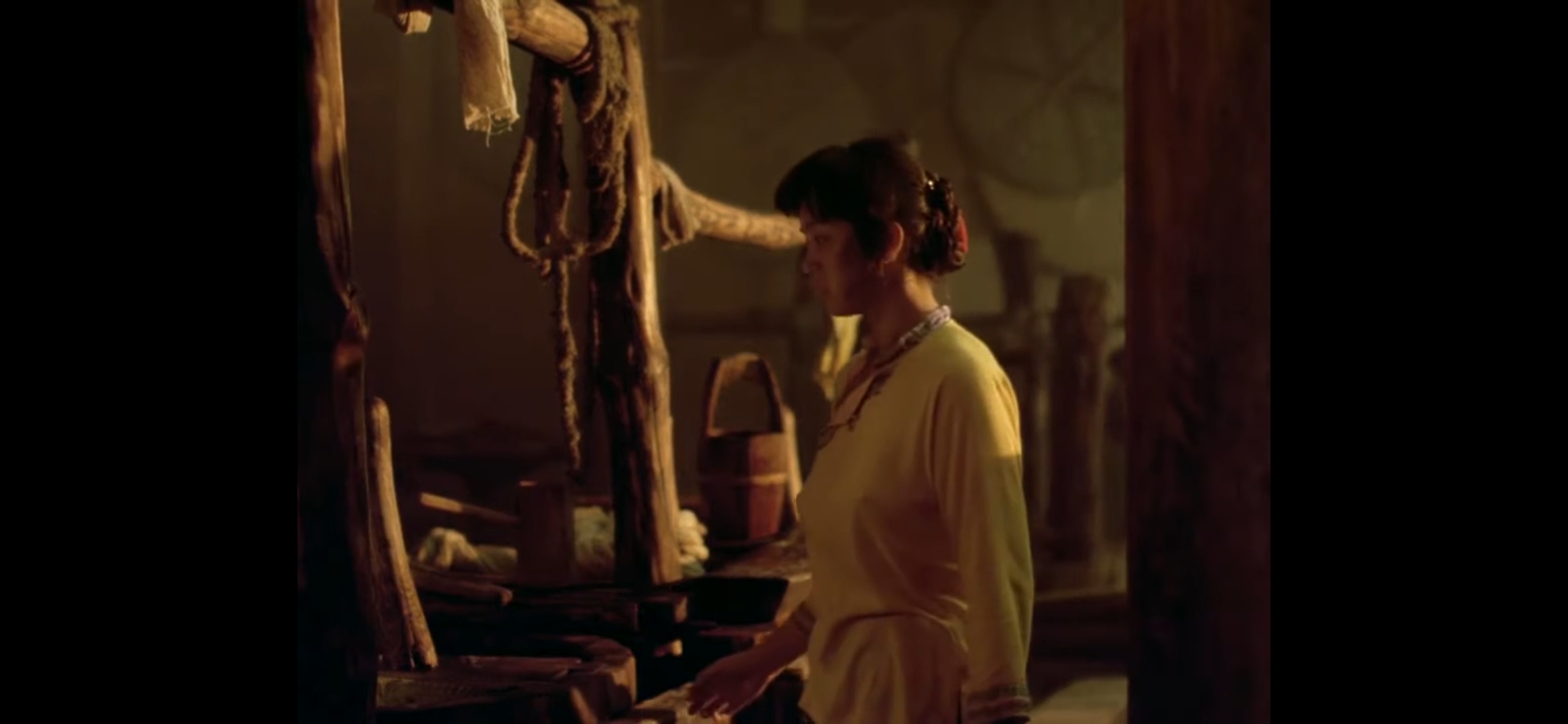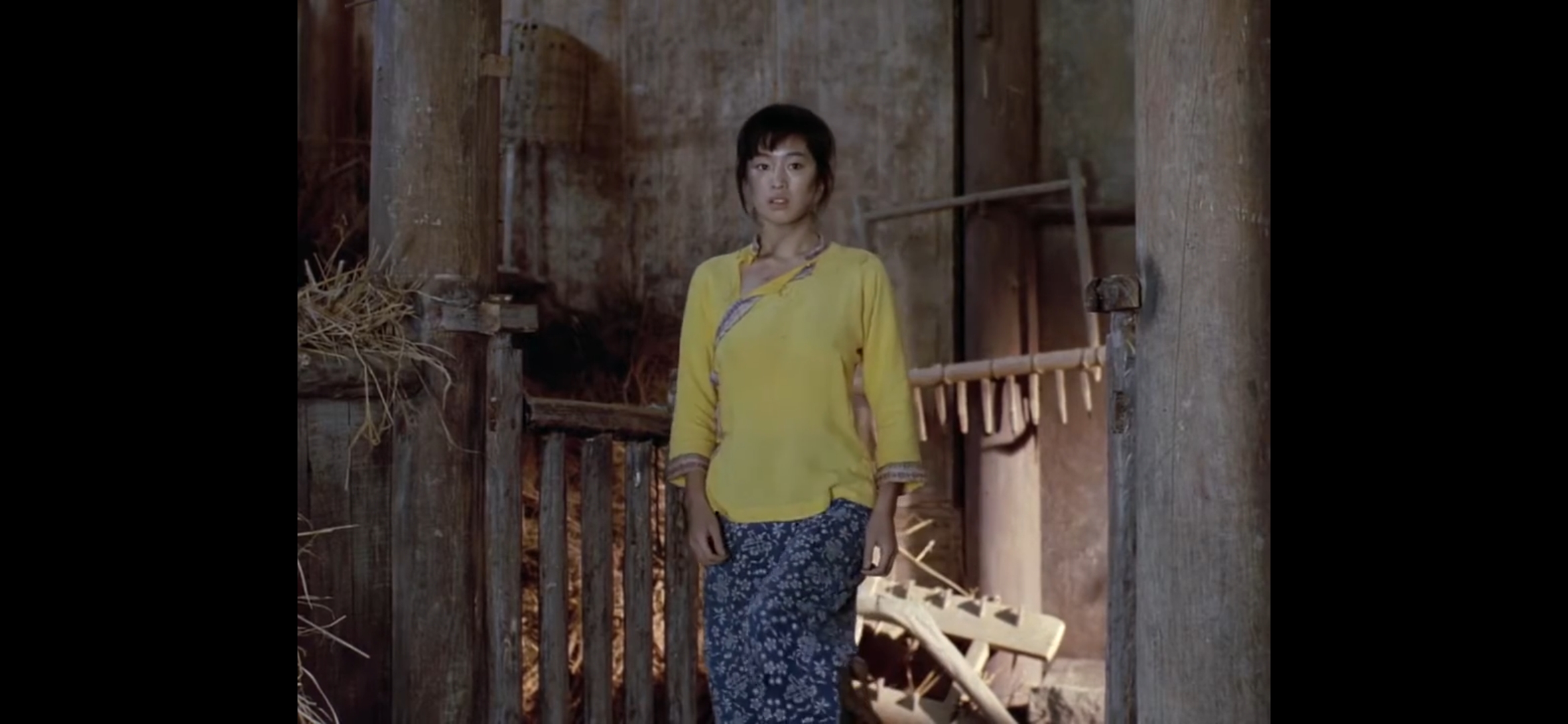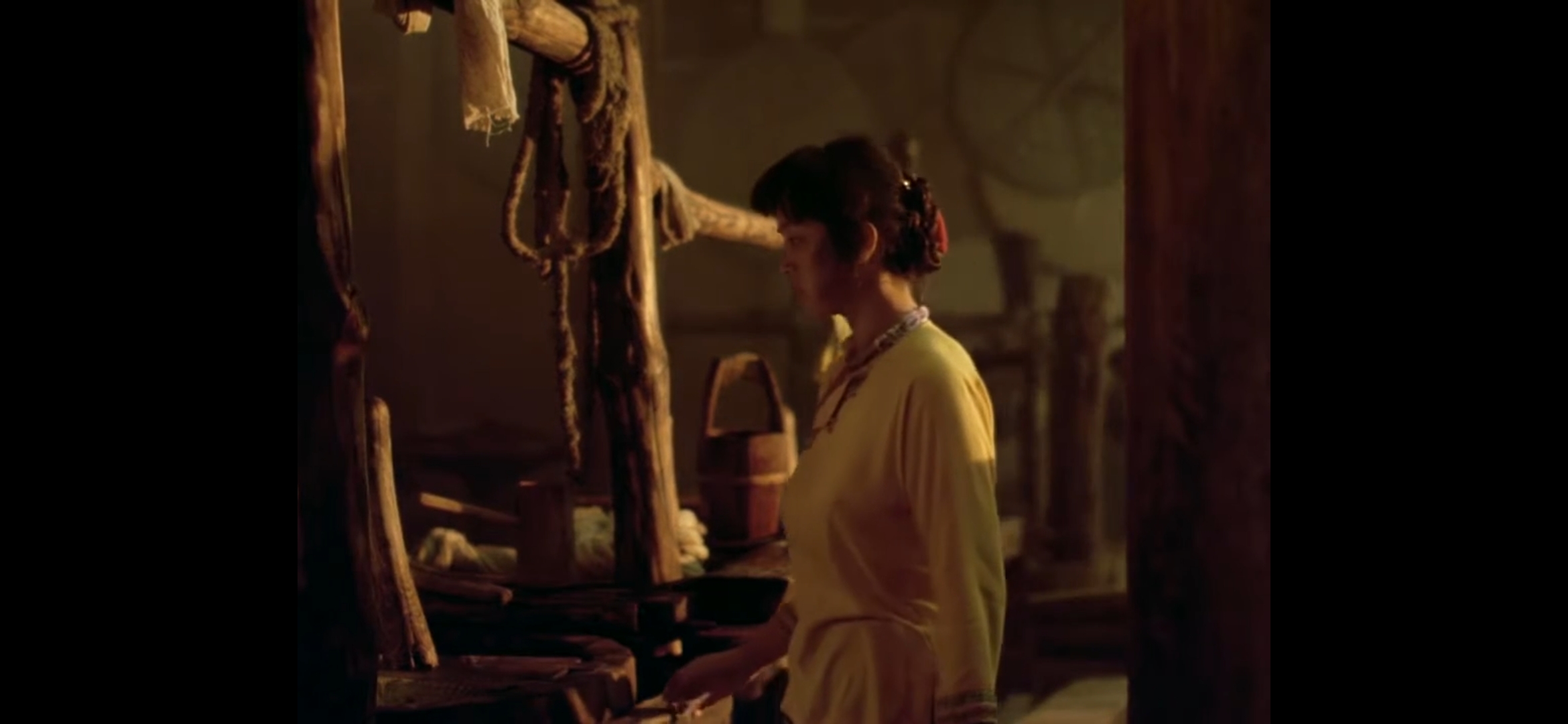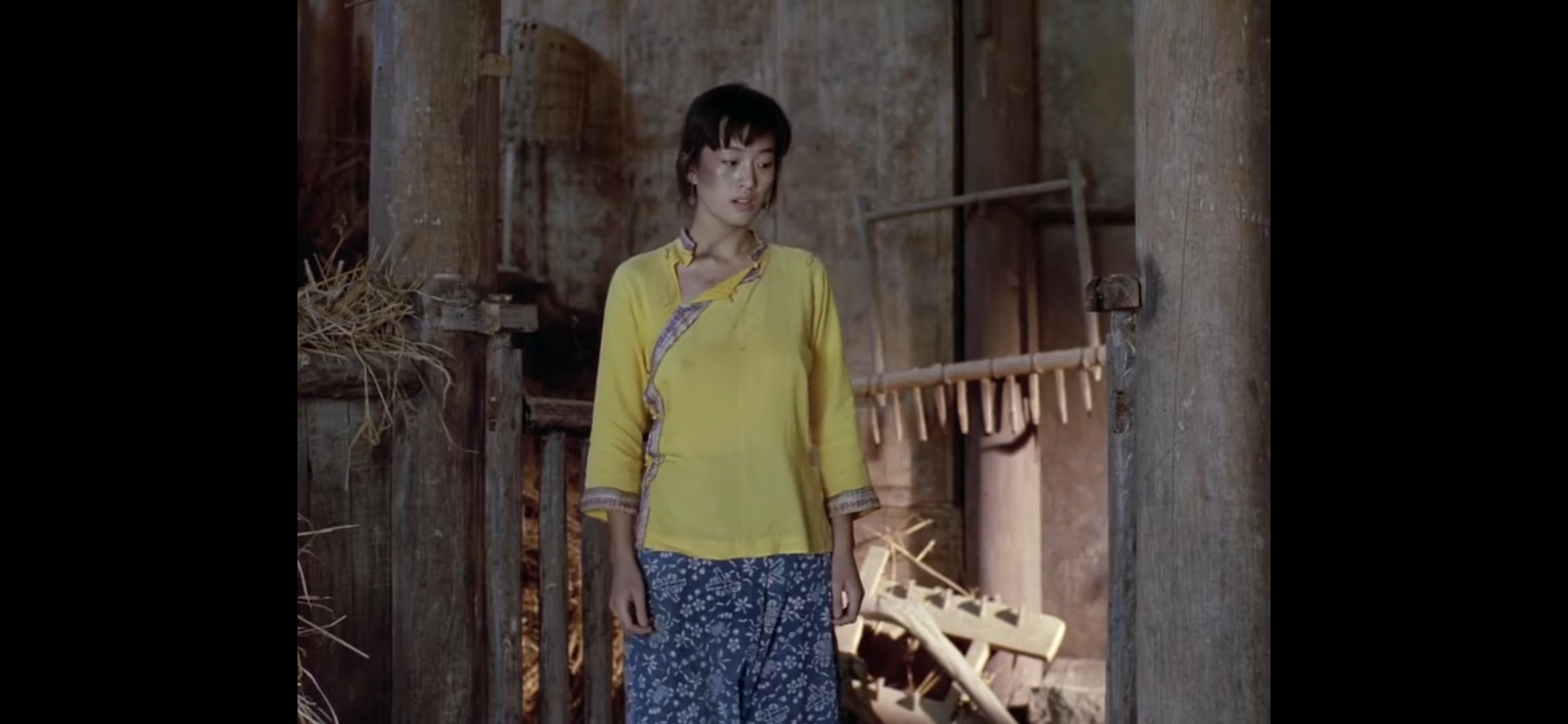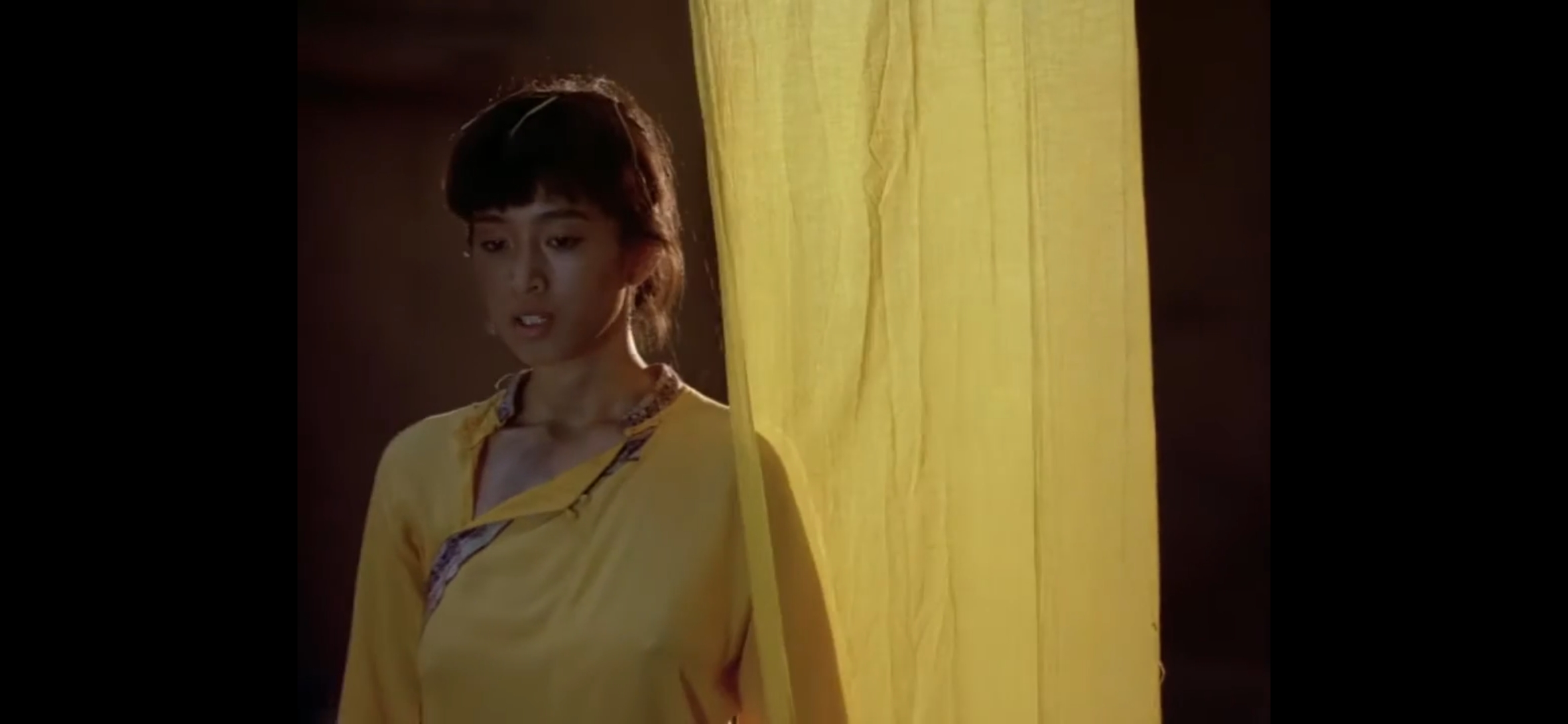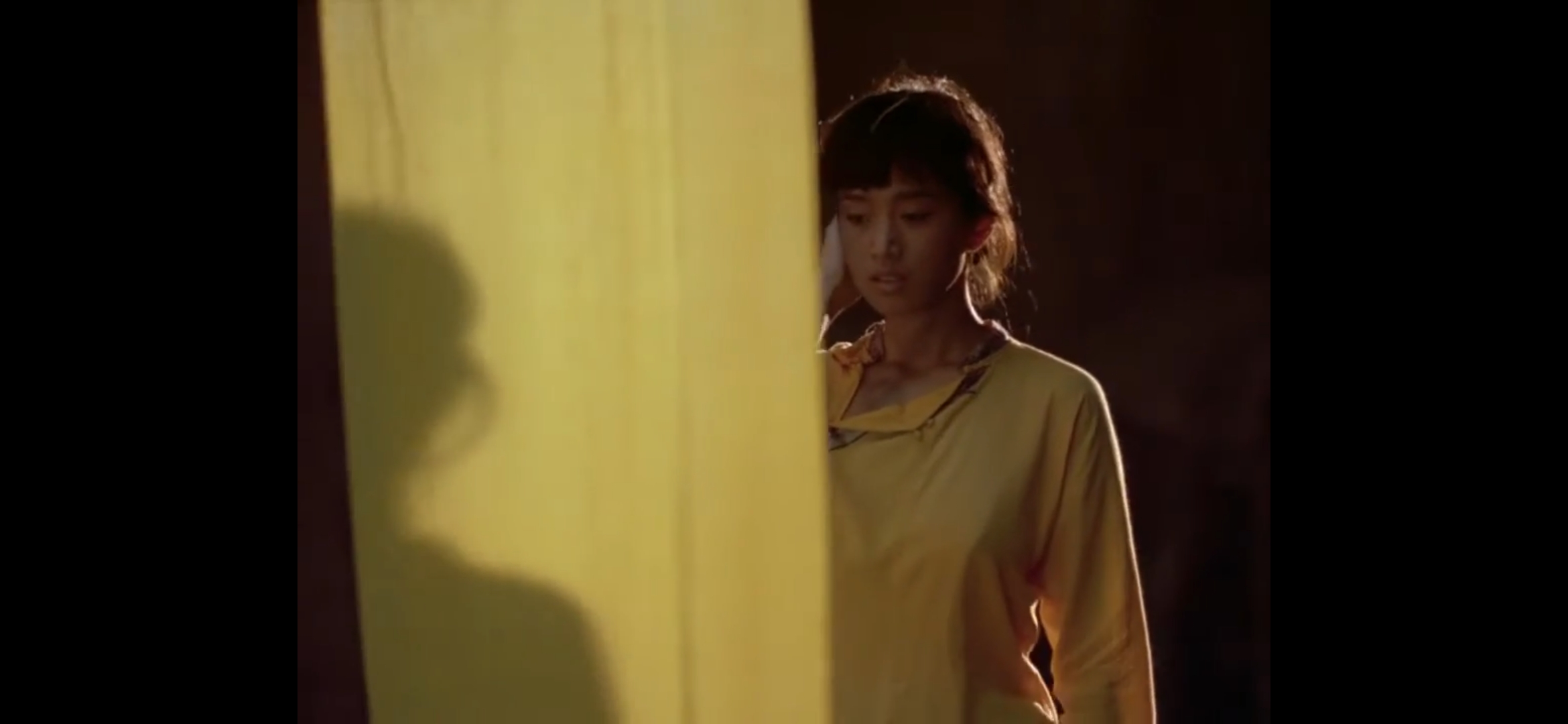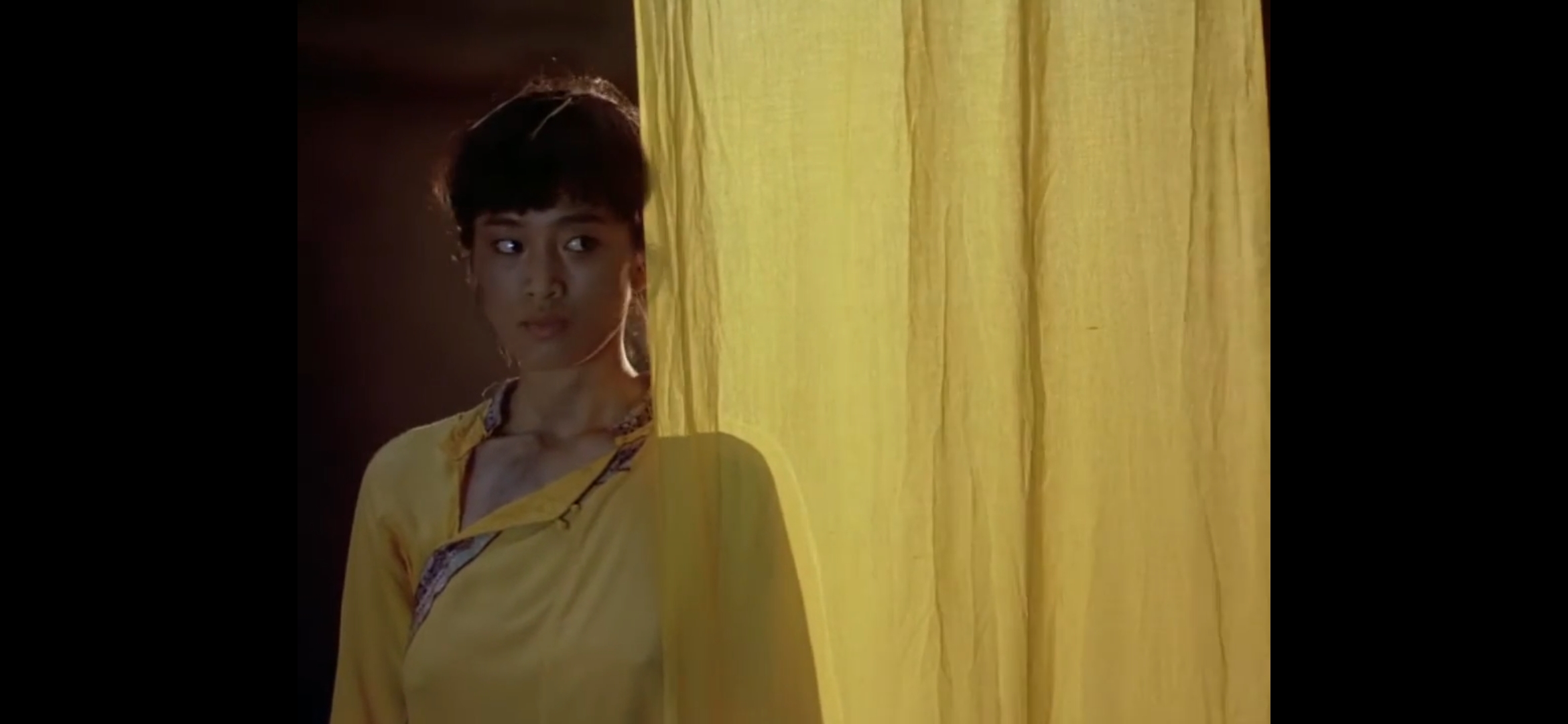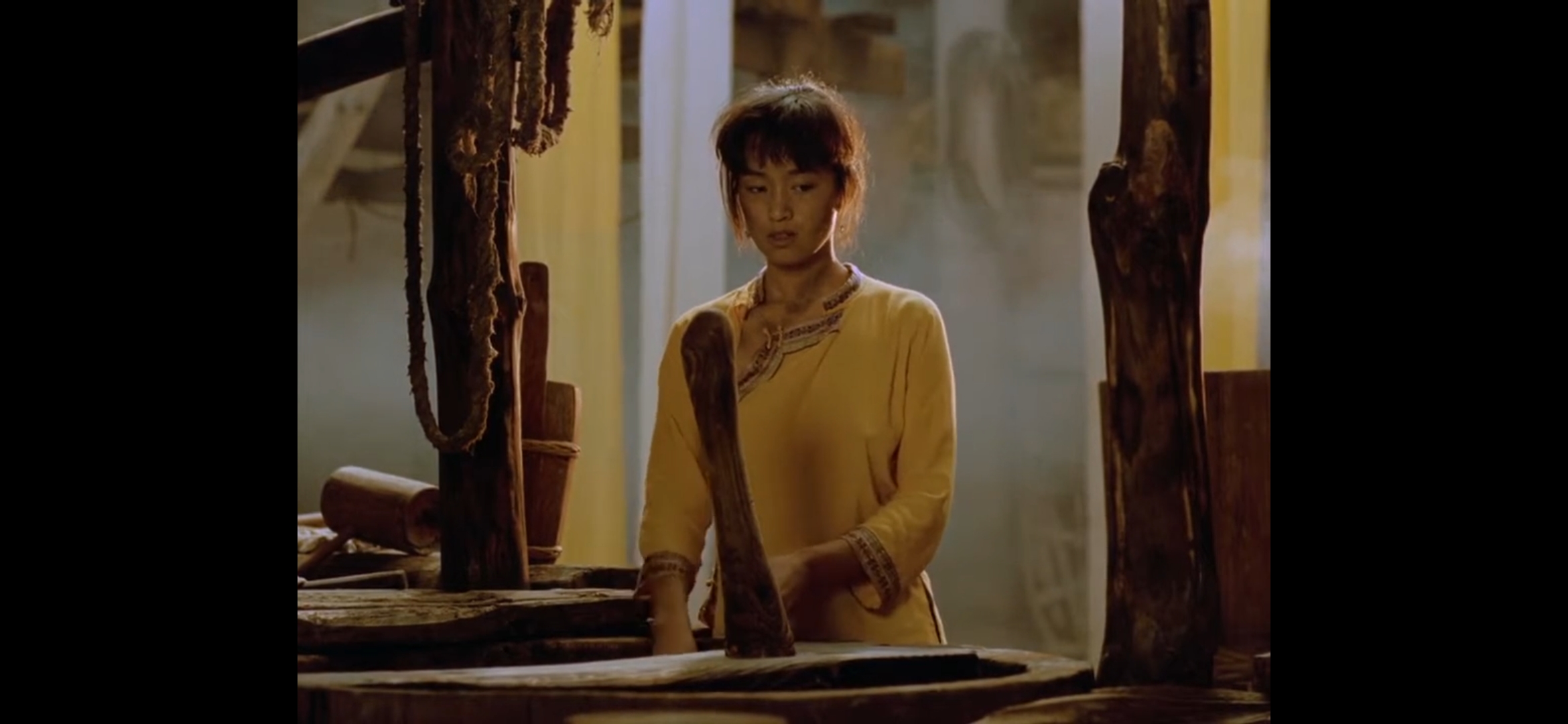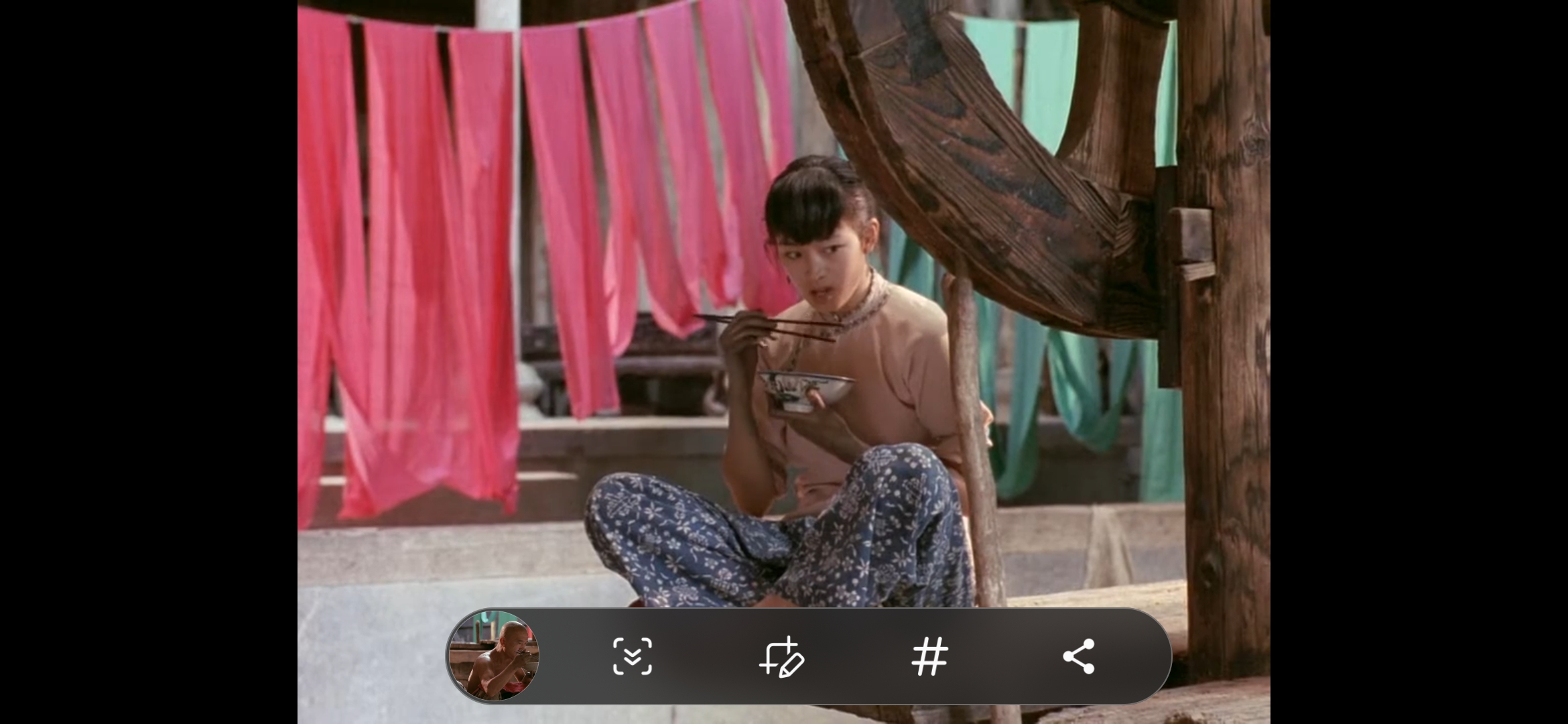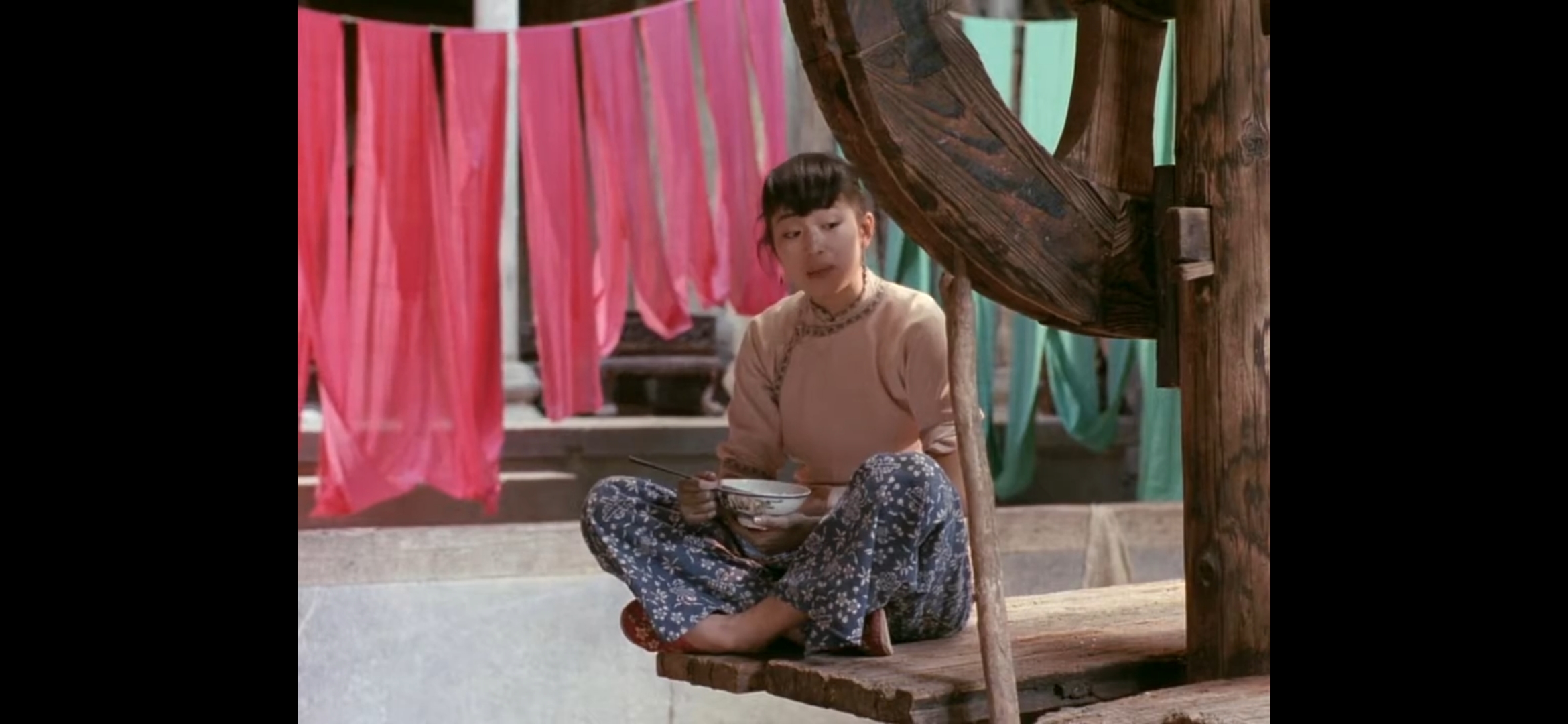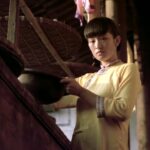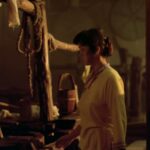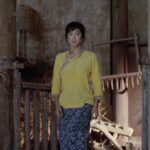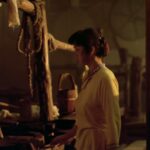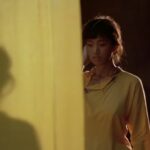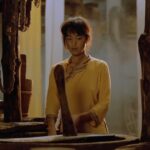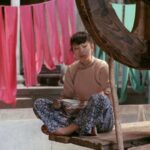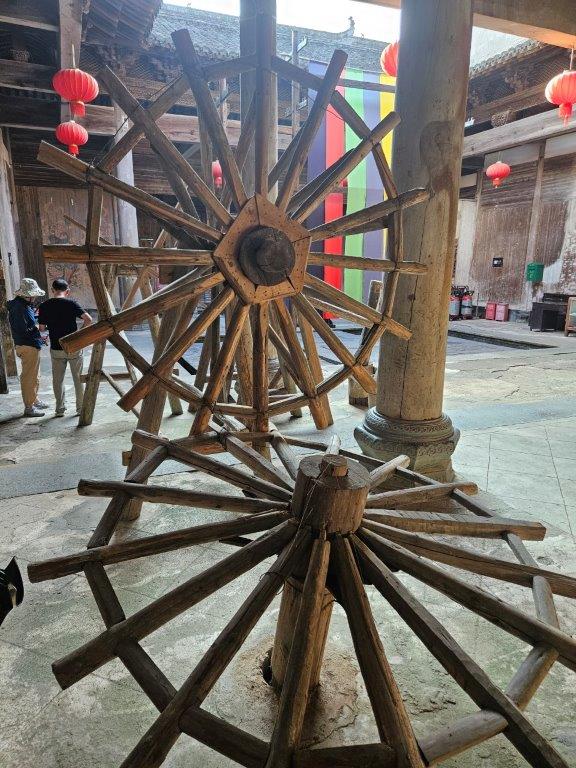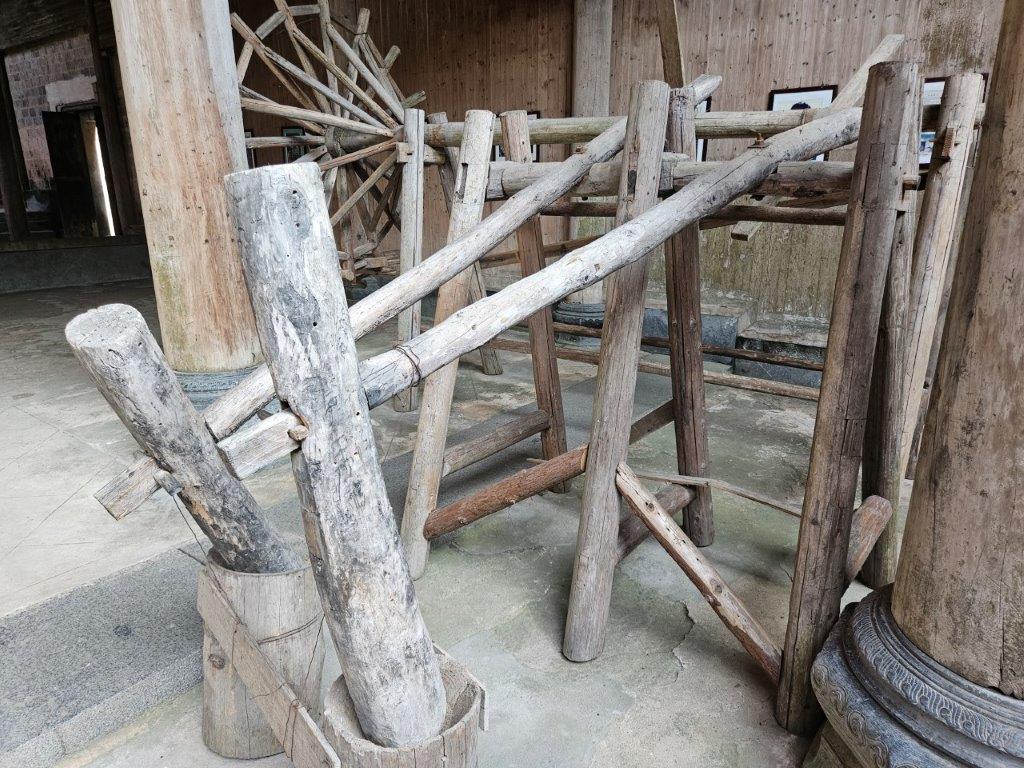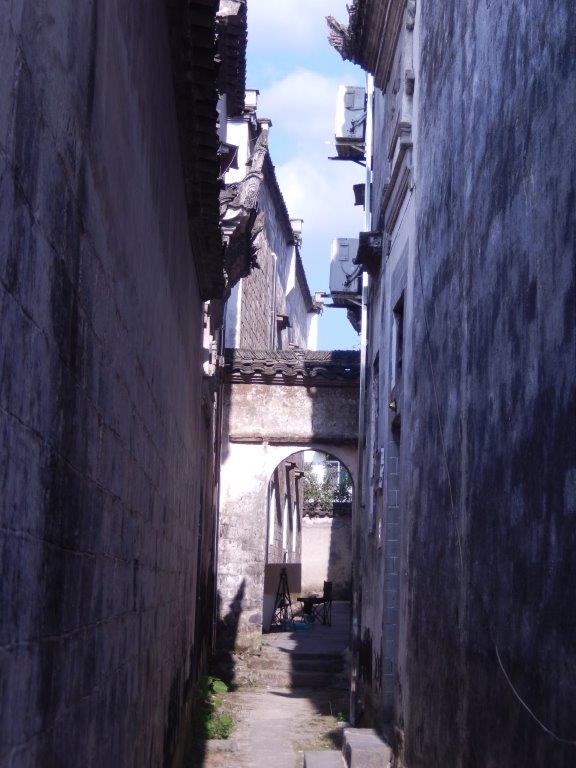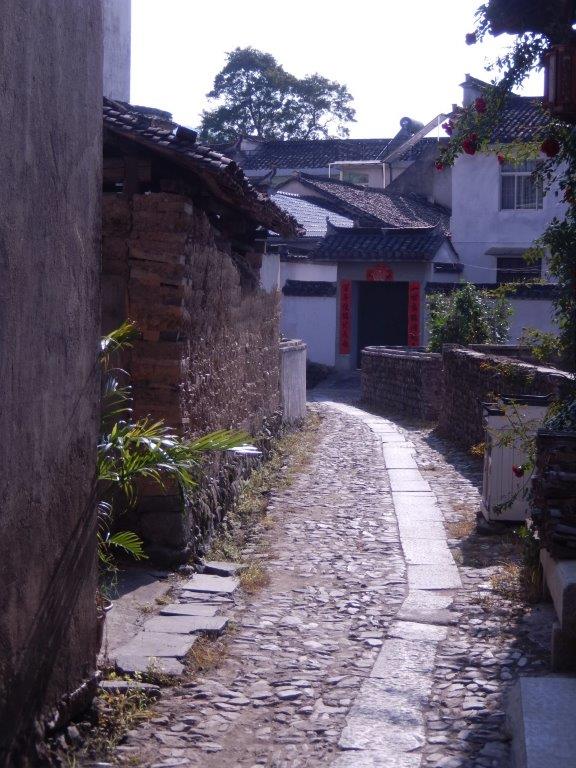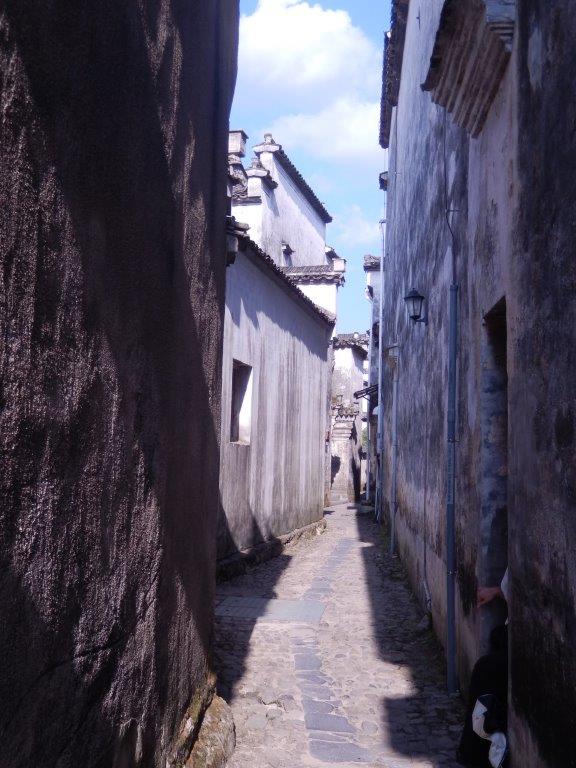11. China/Anhui: Nanping, the village of Ju Dou
In this blogpost I’m acting like a real movie buff. I have always been a great admirer of the movies of Zhang Yimou and his cooperation with actress Gong Li. Just before travelling to China I watched The Great Wall for tge 2nd time, which is Zhang’s first great hollywood production. In this blog I’ll show some images from the movie Ju Dou, which can be recognized from the Nanping scenery and from the interiors of Xu zhi Hall.
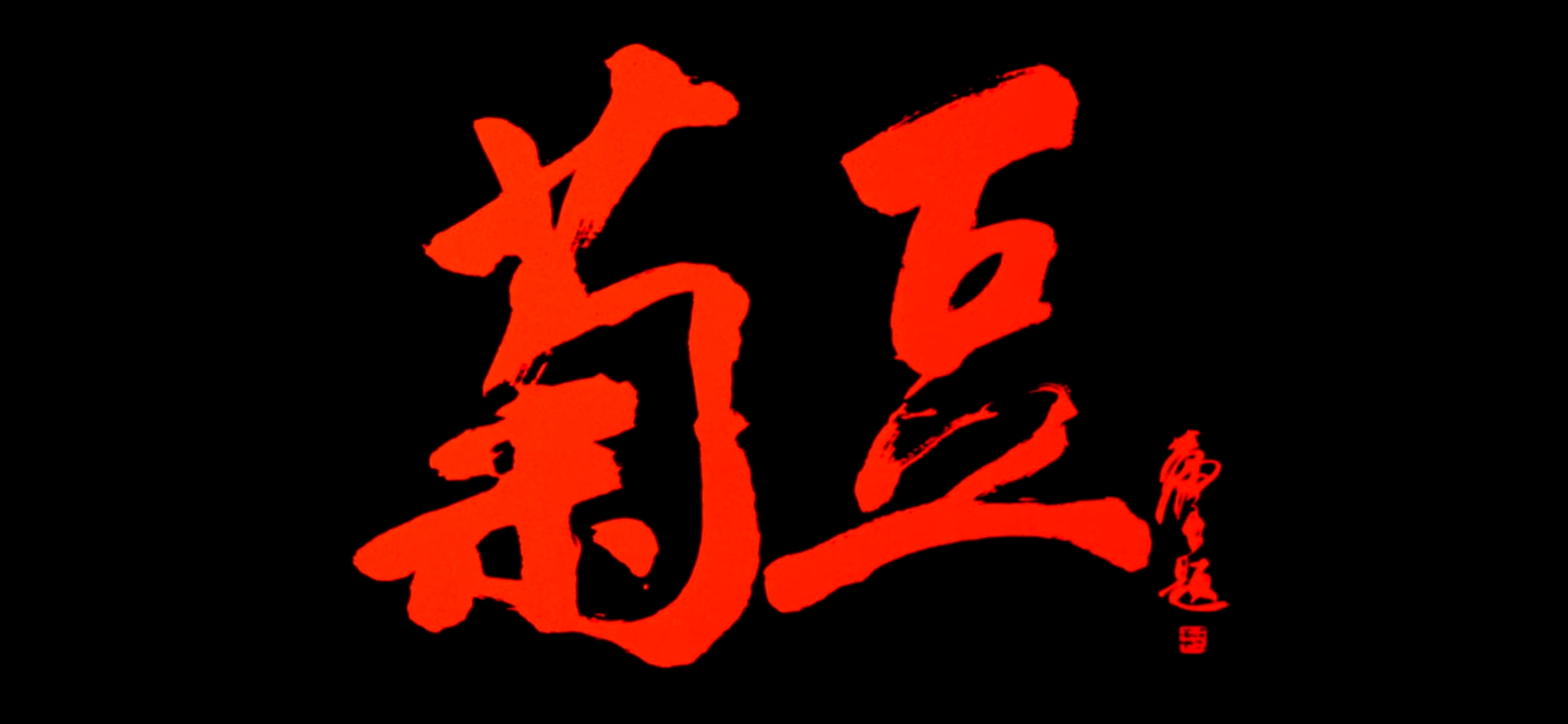
From the titles of the movie Ju Dou by Zhang Yimou …
As in the openings scene of the movie is shown, Nanping is surrounded by farm lands and mountains …
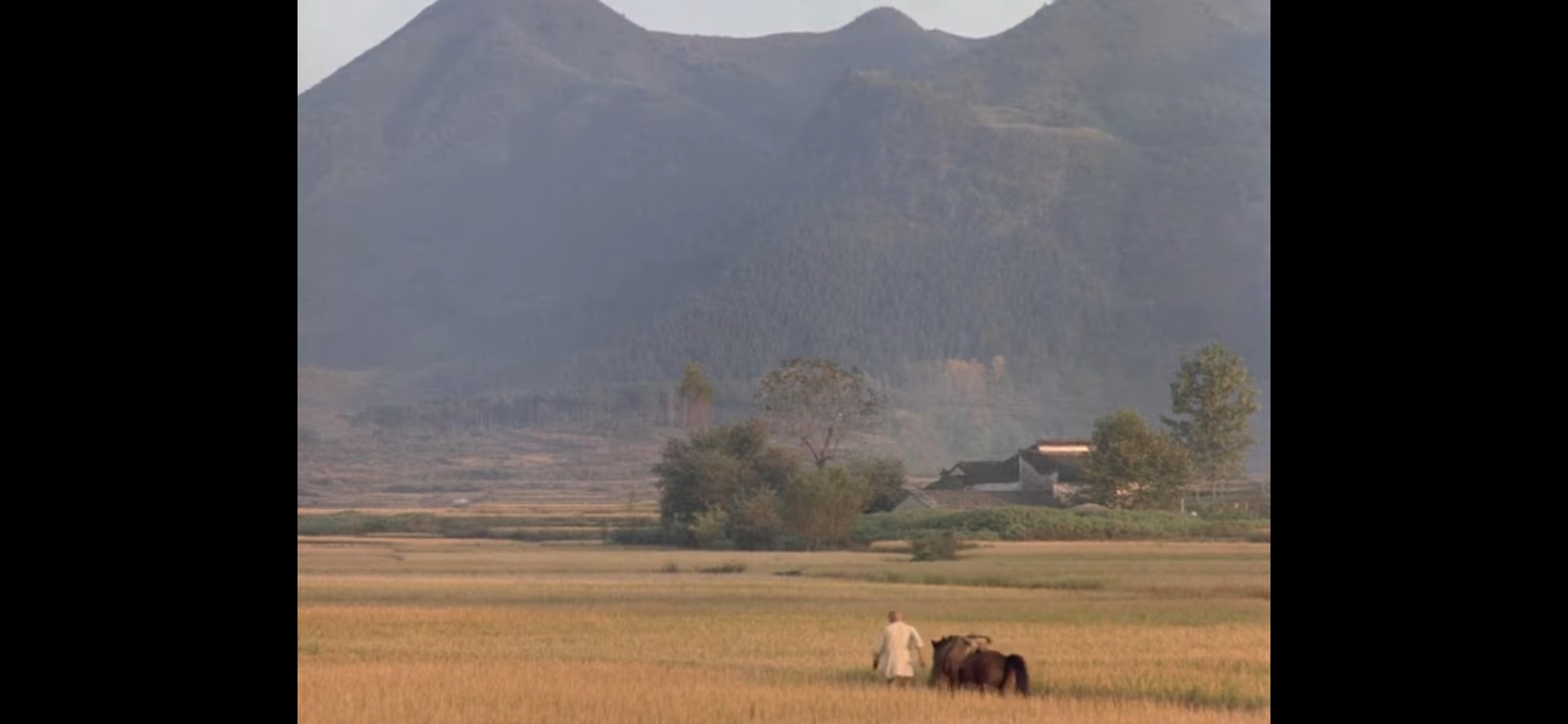
Scene from the movie Ju Dou by Zhang Yimou …
Huangshan Mountain, Hui-style architecture and Feng shui
When first entering Nanping, The Wandelgek immediately noticed how very quiet and tranquil this village was compared to Hongcun, but also to Chengkan.
There were some chinese artists painting the village, but apart from the inhabitants and The Wandelgek and his guide Louisa, there were almost no other travellers or tourists, not even chinese tourists).
All these little towns, like Chengkan, Hongcun and Nanping, are build with Feng shui in mind.
Feng shui, sometimes called Chinese geomancy, is a traditional form of geomancy that originated in Ancient China and claims to use energy forces to harmonize individuals with their surrounding environment. The term feng shui means, literally, “wind-water” (i.e., fluid). From ancient times, landscapes and bodies of water were thought to direct the flow of the universal Qi – “cosmic current” or energy – through places and structures. More broadly, feng shui includes astronomical, astrological, architectural, cosmological, geographical, and topographical dimensions.
The area around the Huangshan mountains and the mountains themselves are ideal for building Feng shui villages and the many artists drawn by the mountains must have had some influences on the villages as well.
Nanping
When you look at Nanping, it’s hard to believe that this sleepy little village was once the site of two major battles, the home of the “10,000 silver purses”, and the backdrop for a handful of blockbuster movies.
Yet there’s more to this rural slice of paradise than meets the eye! The nearby Nanping Mountain served as a battlefield during the Three Kingdoms Period (220-280 AD), but the area itself wouldn’t be settled until much later. Towards the end of the Yuan Dynasty (1271-1368), the village was established by the Ye clan, who had immigrated there from nearby Qimen.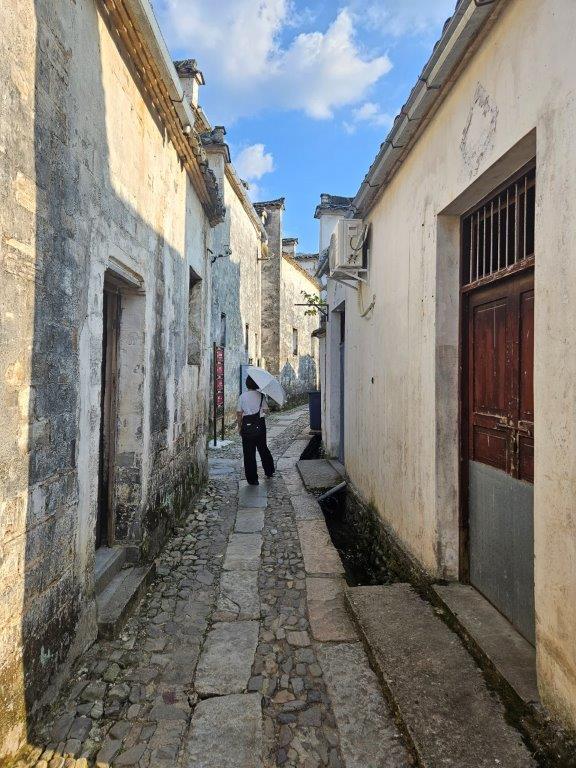
During the Ming Dynasty (1368-1644), two other merchant families known as the Li and Cheng clans decided to settle in the village, which was a rarity as most villages were made up of just one clan during imperial times. And it seems that, though two may have been company, three was definitely a crowd in Nanping!
The success of these three families is often attributed to their competitiveness, as an abnormal number of villagers went on to become wealthy merchants, imperial officials, and learned scholars. Their accomplishments are living proof that a little healthy competition can go a long way! Throughout the Ming and Qing (1644-1912) dynasties, these families built glorious mansions, private schools, and ancestral halls as a testament to their fortune.
Their prosperity was so renowned that the 20 families living in the village came to be known as “the 10,000 silver purses”. Even the frequent peasant uprisings during the establishment of the Taiping Heavenly Kingdom (1851-1864) (Taiping Heavenly Kingdom: An oppositional state in China that was formed from 1851 to 1864 and controlled some parts of southern China during the Qing Dynasty (1644-1912)), weren’t enough to shake the foundations of this tiny village. Unfortunately, when the Qing Dynasty finally collapsed and the imperial regime with it, the families in Nanping fell on hard times. Though their fortuitous streak may have been curtailed, their magnificent architecture was spared from damage by warfare and looting, and remains well-preserved as a monument to their former glory.

Nanping is at the red location icon in the bottom left corner. Hongcun and Xidi, two other major hui architecture historic towns are shown as well.
Nowadays the village is still inhabited by over 1,000 people from the Ye, Cheng, and Li clans, as well as a handful of outside families, and over 300 of its buildings date back to the Ming and Qing dynasties. These stunning mansions, with their white-washed walls and coal black roofs, are dotted throughout a maze of 72 lanes that zigzag throughout Nanping. A stretch of ancient woods, known as Wansonglin, surrounds the village and only adds to its mystical quality.
Nanping is located in the southwest part of Yixian county, Huangshan City. It is a town with broad scales and a thousand years history. Nanping features well-preserved ancestral halls, it still preserved 300 ancient buildings of the Ming and Qing dynasties.
“Kuiguang Hall“, “Xuzhi Hall” are magnificent halls, while “Shensi Hall” and “Bingling Hall” are simple, elegant dwellings.
A poorer Huizhou style house
The Wandelgek 1st visited this house which had a small living room …
… and a small seperate kitchen.
There was also a steep stair to the roof and an even steeper metal stair (which was quite hot in the sunlight), to the roof of a small building on top. Red peppers were drying in the sun …
From the roof the views over Nanping were extraordinary and The Wandelgek remembered this opening scene of the movie zJu Dou, showing a bird eye view over Nanping…
The Wandelgek always liked the rooftops of buildings, built in every possible direction …

Scene from the movie Ju Dou by Zhang Yimou …
After The Wandelgek descended, the walk through the narrow streets went on …
Parts of the village were down or up hill and small stairs were built to bridge the elevations …
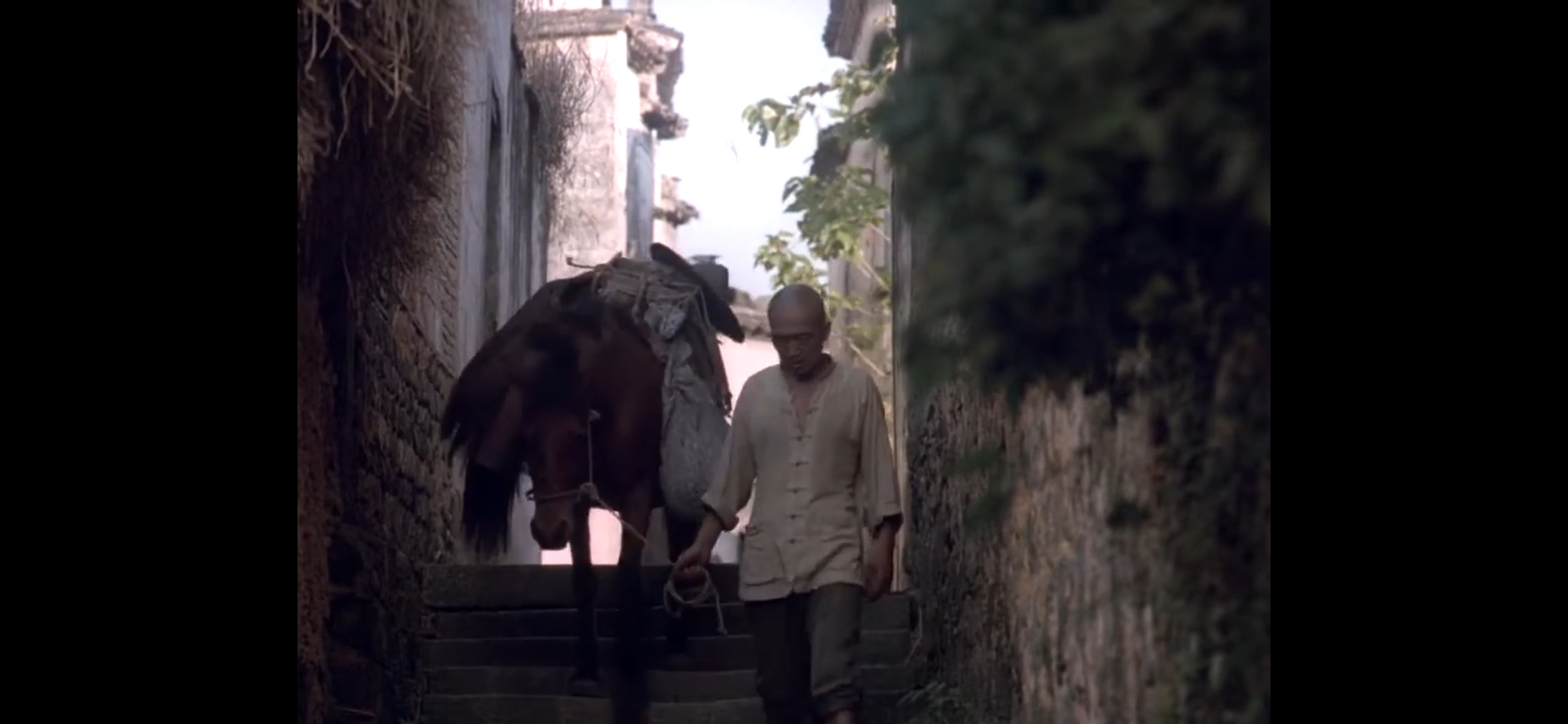
Scene from the movie Ju Dou by Zhang Yimou …
… until he arrived at …
A simple Huizhou style house: Shen-si Hall
This was house was larger then the previous one, but nothing compared to the rich merchant’s houses he had seen in Chengkan and Hongcun.
There were four different kitchens on display in the house …
What is shown here is the gradual modernzing of a kitchen in these very old houses. The kitchen above is obviously and the two following below are the oldest and they resemble a kitchen which The Wandelgek had seen before when visiting ancient Pompeï in Italy on a street corner where fastfood was sold …
See:
In both kitchens, a brick oven is heated and on top there are spare openings to put kettles on. Now it is well known that The Roman Empire had trade connections with the Chinese Empire via the Silkroad and it is also known tgat not only goods were traded but also knowledge and beliefs.
More about my many silkroad travels (partially in China too) can be read here:
Wood piles were seen next to every type of kitchen except the modern one, suggesting that for a very long time wood has been the major source for heating …
A more modern kitchen. In the bottom of the cabinet you can see bamboo pieces cut in half. They are hollow and arecused for cooking, but more about that in a later upcoming blogpost (that one will be much later though).
There were lots of practical tools hanging on the walls andca wioden stair led to a first floor which was inaccessible though …
Shoes and sandels, hanging from the wall, baskets on the floor …
Very interesting house! The Wandelgek left and followed the winding streets again. These villages are like a maze …
… and there were quite some young art students picking the best places to creat a new art work …
Next The Wandelgek was led to:
A rich merchant’s house
Even from the outside it could be seen that this was the house of someone wealthy.
The house had many courtyards which had to be crossed before entering. Beside the entrance door were what looked like two drums on pedestals. These were I think completely made from stone.
A narrow pathway was zigzagging through the first courtyard. This was done to keep the evil spirits trying to enter the house dazed and confused 
The 200 year old house was the largest of the houses, The Wandelgek visited and it also was the richest in decoration in Nanping.
Most of these houses had a central place where a table or a small cabinet was placed holding all sorts of memorabilia related to deceased family members or used to worship gods and spirits.
The woodwork was quite good, maybe not as advanced as in Hongcun or maybe it wasn’t even that. It was less common than in Hongcun.
This was a 2 storey house. Also notice the decorated/ engraved glass windows in the center. This is really old glass …
The rooms were old and less renovated then the ones seen in Hongcun, …
… but there were really beautiful woodcarvings here too …
This next room looked at bit like a central living room. It had chairs beside s narrow wall table, decorated with vases and a clock, but also chairs against bith side walls.
Of course a beautiful drawing of Huangshan Mountain was the center piece of attention.
The decoration of the wooden ceiling beams was often mesmerizing …
The rich male merchants in those days, were often married to more than one wife, sometimes up to two or three. Because of this there were multiple separated bedrooms in the house …
In Shanghai, a lively opium trade had emerged, which was also described in Tin Tin’s The Blue Lotus comic album. Foreign countries had started opium trade through the port of Shanghai and when the Chinese government tried to enforce prohibition on opium, which also meant destroying opium storages, these foreign countries like e.g. the British started the opium wars. But opium use had spread derp into China and also as deep as Nanping, where this rich merchant had a special opium room in his house …
The wooden panel below was regulate the amount of light and shade to enter the opium kit room. It looks again as if small panels of very old glass were used but I’m not entirely sure of that. It was not possible to look through, which of course is a must when hiding a prohibited activity like opium smoking…
The Wandelgek went on on his quest through the maze of narrow streets of Nanping …
The next building was part of cinematic history and was a must see for The Wandelgek:
Ju Dou and Xuzhi Hall
The village’s spectacular architecture is punctuated by eight ancestral halls, of which Xuzhi Hall and Kuiguang Hall are considered the most well-preserved. Both belong to the Ye family and, while Kuiguang Hall is an impressive 490 years old, Xuzhi Hall is a staggering 530 years old!
Beside the entrance door were again two drums placed on pedestals (they can be seen, but barely, through the green coverage). The front of the building was being painted or restored.
Xuzhi Hall is divided into three parts: the front hall, which was used for recreational activities; the main hall, which served as the centre for sacrificial ceremonies; and the back hall, where the memorial tablet to the ancestors is enshrined. This hall served as the main backdrop for the critically acclaimed film Ju Dou, directed by Zhang Yimou and starring the exceptional Gong Li.
Here the drums on pedestals are quite visible. I’m not sure, but I think these were made of stone too …
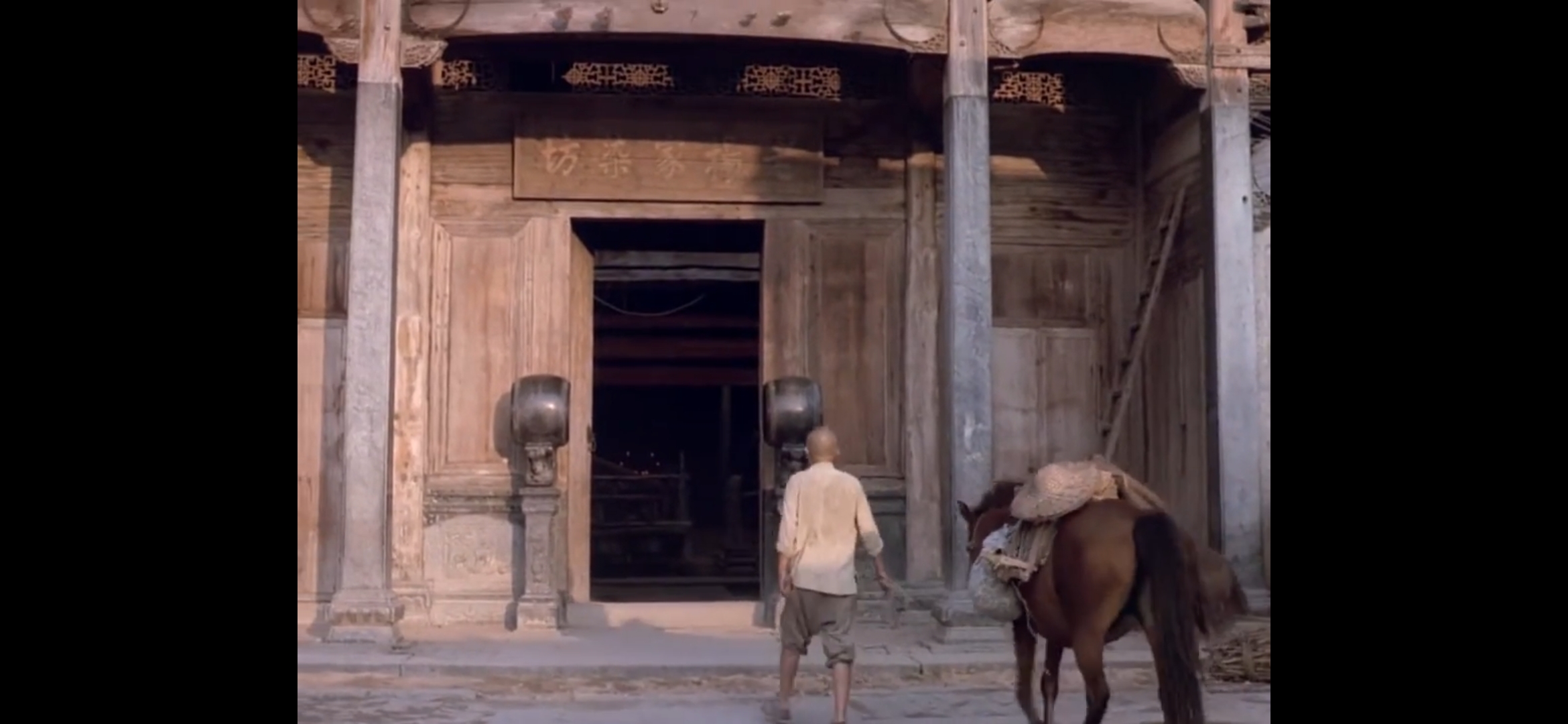
Scene from the movie Ju Dou by Zhang Yimou …
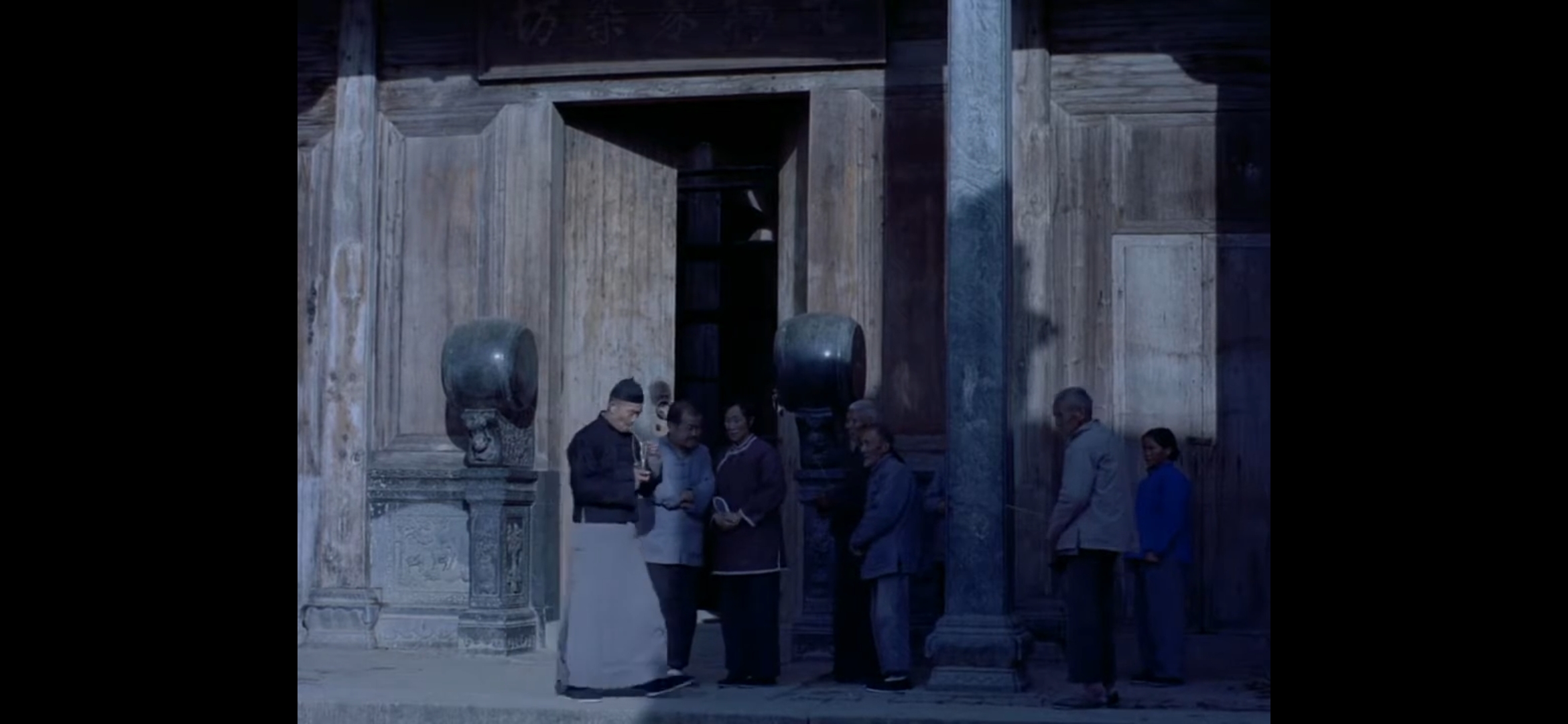
Scene from the movie Ju Dou by Zhang Yimou …
Zhang Yimou
Zhang Yimou; born 14 November 1950) is a Chinese filmmaker. A leading figure of China’s Fifth Generation directors, he made his directorial debut in 1988 with Red Sorghum, which won the Golden Bear at the Berlin International Film Festival.
Zhang has won numerous awards and recognitions, with three Academy Awards nominations for Best Foreign Language Film for Ju Dou in 1990, Raise the Red Lantern in 1991, and Hero in 2003. The last movie was the 1st in a series of 3; Hero, House of the Flying Daggers and The Curse if the Golden Flower, which were all more martial arts inspired movies, which he made after the great succes and Academy Award win of Ang Lee’s Crouching Tiger, Hidden Dragon.
His older movies, like Red Sorghum, Ju Dou and Raise the Red Lantern and The Story of Qiu Ju of were more critical of Chinese society and specificly of the position of women in that society.
Feminine Chastity:
In ancient times, chastity was considered the most important virtue for a woman to uphold and we believe that there are still many people who hold this opinion in modern China today. The appearance of Xin’an Li theory in the Huizhou region meant that women in this area suffered more under the rules of chastity.
Most of the men in the Huizhou region travelled out of the village to do business, and thus left their wives at home to serve their parents and raise the children. They might only come back once a year, or sometimes even less frequently. It was without question that, no matter what, the wife must remain chaste whilst the husband was away. Once her honor was threatened, she had to die rather than be violated to express her loyalty to remaining chaste. If a woman’s husband died young, the only way for her to properly remain a morally upright and chaste woman was to become a widow for the rest of her life.
You will find many archways that use and praise the theme of feminine chastity in their architecture, and many stories use this theme as well. For example, there are 94 memorial archways in Shexian, among which 34 of them honour the concept of feminine chastity.
These movies were popular as arthouse movies in Europe and The Netherlands during the late 80’s and early 90’s of the previous century and that is where The Wandelgek picked up on them. The female role in most of his movies was played by Gong Li.
Gong Li
Gong Li; born 31 December 1965, is a Chinese born Singaporean actress. Regarded as one of the best actresses in China today, she is known for her versatility and naturalistic performance. She starred in three of the four Chinese-language films that have been nominated for the Academy Award for Best International Feature Film.
Gong was born in Shenyang, Liaoning, and grew up in Jinan, Shandong. She enrolled at the Central Academy of Drama in Beijing, from where she graduated in 1989. While a student at the Academy, she was spotted by director Zhang Yimou and debuted in Zhang’s Red Sorghum in 1987. Gong and Zhang’s professional and personal relationship received much media attention in the Chinese-speaking world, as they continued to collaborate on a string of critically acclaimed movies, including the Oscar-nominated features Ju Dou (1990) and Raise the Red Lantern (1991). For her role in the Zhang-directed The Story of Qiu Ju (1992), Gong won the Volpi Cup for Best Actress at the Venice Film Festival.
Gong also starred in the Chen Kaige-directed Oscar-nominated Farewell My Concubine (1993), for which she won Best Supporting Actress at the New York Film Critics Circle Awards. In English-language films, she won the National Board of Review Award for Best Supporting Actress for Memoirs of a Geisha (2005), directed by Rob Marshall. Other notable appearances include Flirting Scholar (1993), To Live (1994), Chinese Box (1997), The Emperor and the Assassin (1998), Breaking the Silence (2000), Zhou Yu’s Train (2003), Eros (2004), Miami Vice (2006), Curse of the Golden Flower (2006) and Saturday Fiction (2019).
Ju Dou
Ju Dou (Gong Li), the young bride of Yang Jin-shan (Wei Li), who is the tyrannical owner of a silk-dyeing business, is forced to endure her husband’s violent tendencies and condescending nature. Although Ju Dou finds temporary solace in the arms of her husband’s nephew, Tian-qing (Baotian Li), problems arise when Ju Dou gets pregnant. The couple then desperately tries to hide their passionate romance while convincing the merciless Jin-shan that the child is his.
A large part (over 80% of the movie is filmed inside of a workplace and home of a fabric dyer, which in reality is an ancestral hall in Nanping, used by a specific rich merchant’s family to organize family celebrations, sacrifices to their ancestors and worship of deities.
Interior
Many of the sets from the film have been maintained so, The Wandelgek who always wanted to be in this movie, took his chance!
In the middle of the large main hall, was the dining table area which featured in the movie …,
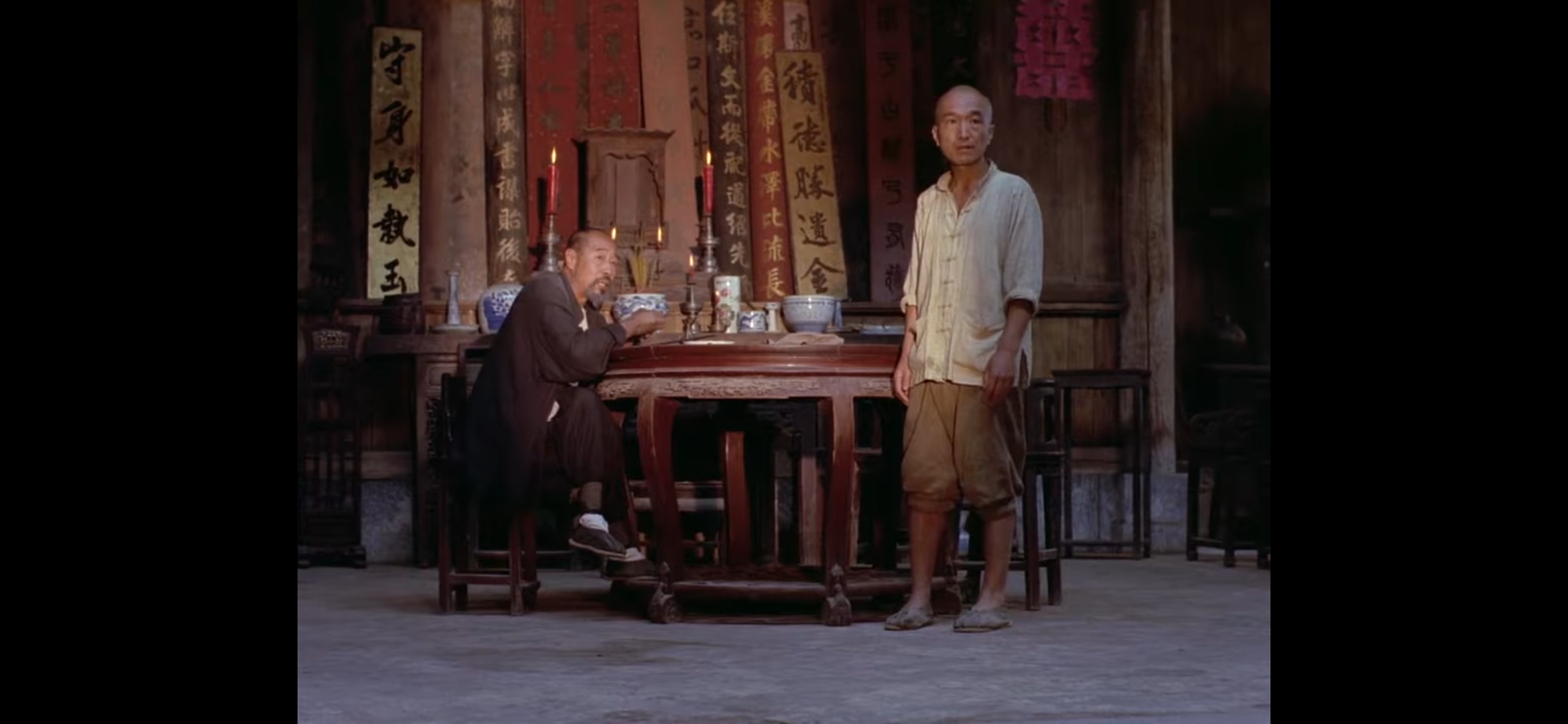
Scene from the movie Ju Dou by Zhang Yimou …
… but was like a temple altar in reality. In the scene above the altar, a bit camouflaged, can be seen behind the dining table …
If you remove all the texts, it looks like this …
Beautiful decorations …
As can be seen from this bird’s eye view scene, the center of the main hall’s roof is open, which functions as a great air refresher for a space where cloth is being dyed, removing the smell of paint quickly …
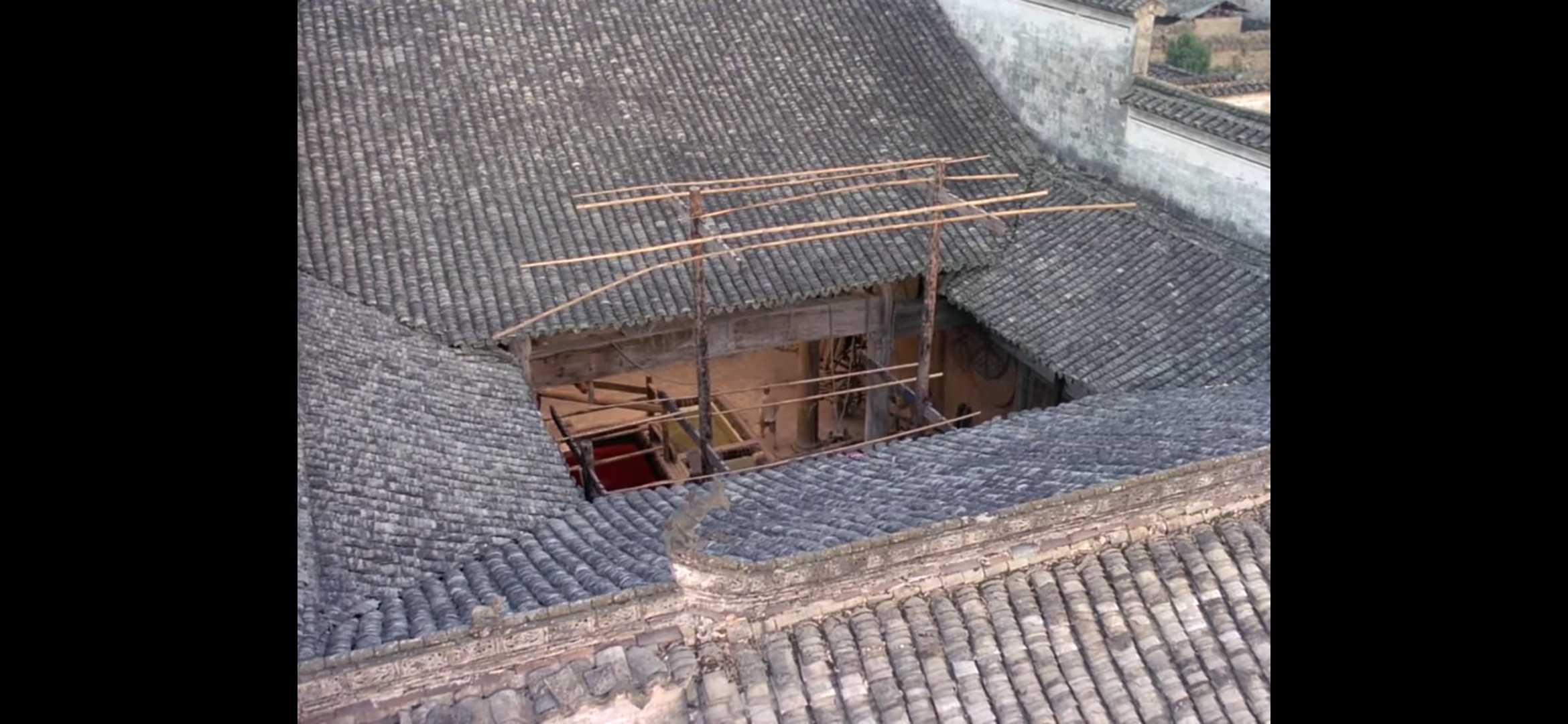
These are my photo’s from inside …
Movie props left behind
I really don’t know what this sign says, …
… but Google translate does:
There were still banners, dyed in many colors, hanging there to dry in the wind and hot sun…
This really was a journey backward in time to the early 90’s when The Wandelgek was still a student and a fervent visitor of the local arthouse in his home town.
This of course reminded me of the actual scenes where fabrics were hanged in the sun to dry the paint …
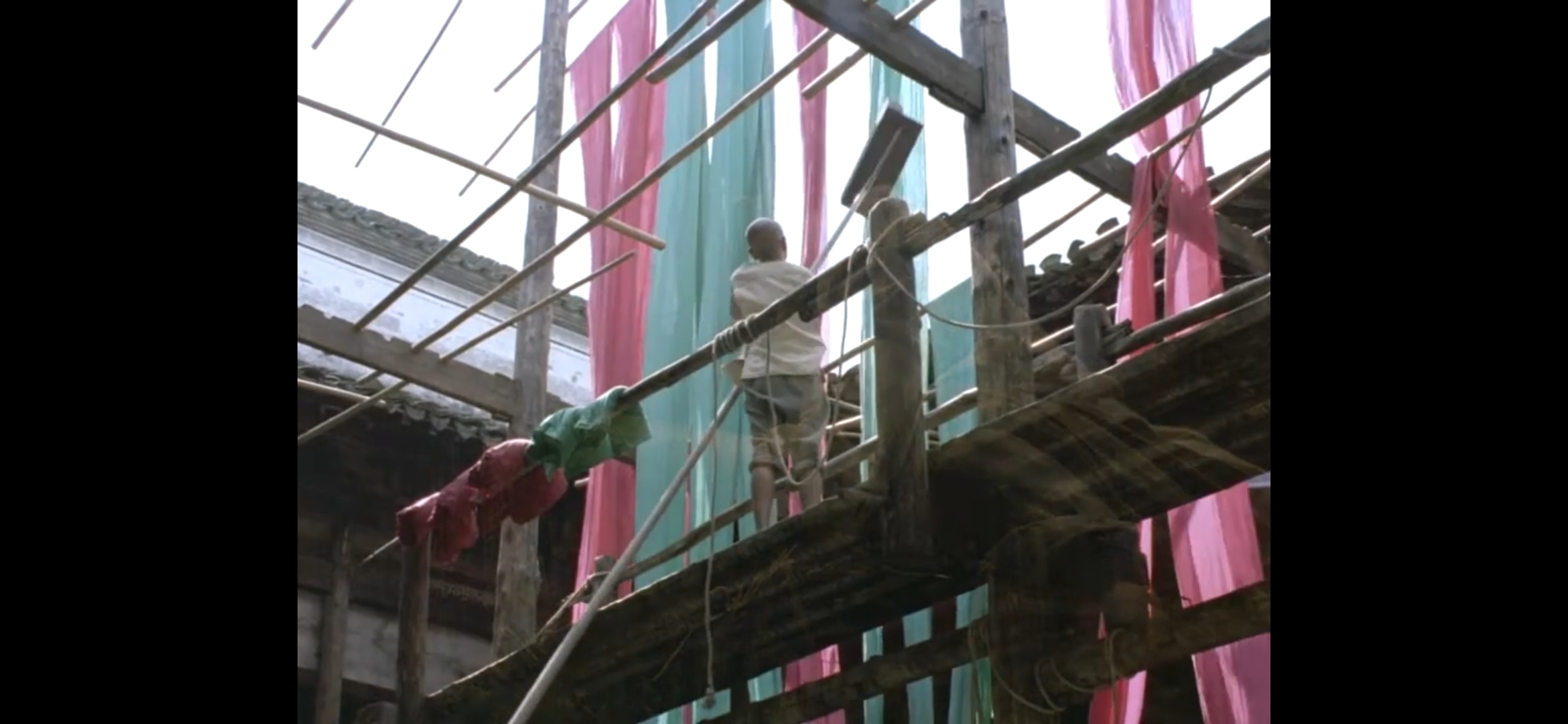
Scene from the movie Ju Dou by Zhang Yimou …
In other scenes, lots of a fabric dyer’s tools could be seen …
… and a lot of these tools and contraptions could still be seen, as if the film crew of Ju Dou had just left the building yesterday …
On the walls were many photographs of the filming process as well as some movie stills and poster material of the movie Ju Dou.
The movie was actually the very 1st chinese language international movie that got nominated for an Academy Award (1991).
Similarly as Shuzi Hall, Kuiguang Hall, with its smooth marble ornaments and elaborately decorated interior, was used as a set for the Oscar-winning film Crouching Tiger, Hidden Dragon, directed by Ang Lee. The Wandelgek however, did not visit Kuiguang Hall as well.
Then it was time to leave Nanping. My guide Louisa suddenly decided to pull a prank and asked me if I could still remember which way to go to the exit of the village.
Luckily I had remembered to look at the position of the sun before entering the maze 
Then we took the taxi and returned to Huangshan City and my hotel.

